Microsoft RAE-6 GSM 900/1800/1900 Phone with Bluetooth User Manual Manual revised
Microsoft Mobile Oy GSM 900/1800/1900 Phone with Bluetooth Manual revised
Manual revised
Nokia 9300 User Guide
9233291
Issue 1
file:///C:/USERS/MODEServer/rapi/7167389/rae-6_mini/en/issue_1/rae-6_mini_en_1.xml Page 1 Nov 22, 2004 2:59:20 PM
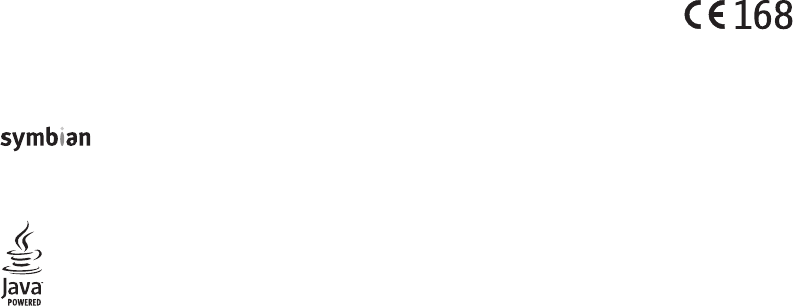
DECLARATION OF CONFORMITY
We, NOKIA CORPORATION declare under our sole responsibility that the product RAE-6 is in conformity with the provisions of the following Council
Directive: 1999/5/EC. A copy of the Declaration of Conformity can be found from www.nokia.com/phones/declaration_of_conformity/.
Copyright © 2004 Nokia. All rights reserved.
Reproduction, transfer, distribution or storage of part or all of the contents in this document in any form without the prior written
permission of Nokia is prohibited.
Nokia, Nokia Connecting People, Xpress-on and Pop-port are trademarks or registered trademarks of Nokia Corporation. Other product and company
names mentioned herein may be trademarks or tradenames of their respective owners.
Nokia tune is a sound mark of Nokia Corporation.
This product includes software licensed from Symbian Software Ltd (c) 1998-2004. Symbian and Symbian OS are trademarks of Symbian
Ltd.
This software is based in part of the work of the FreeType Team. This product is covered by one or more of the following patents: United States Patent
5,155,805, United States Patent 5,325,479, United States Patent 5,159,668, United States Patent 2232861 and France Patent 90 05712.
Java and all Java-based marks are trademarks or registered trademarks of Sun Microsystems, Inc.
Bluetooth is a registered trademark of Bluetooth SIG, Inc.
USE OF THIS PRODUCT IN ANY MANNER THAT COMPLIES WITH THE MPEG-4 VISUAL STANDARD IS PROHIBITED, EXCEPT FOR USE DIRECTLY RELATED TO (A) DATA OR
INFORMATION (i) GENERATED BY AND OBTAINED WITHOUT CHARGE FROM A CONSUMER NOT THEREBY ENGAGED IN A BUSINESS ENTERPRISE, AND (ii) FOR
PERSONAL USE ONLY; AND (B) OTHER USES SPECIFICALLY AND SEPARATELY LICENSED BY MPEG LA, L.L.C.
Nokia operates a policy of continuous development. Nokia reserves the right to make changes and improvements to any of the products described in this
document without prior notice.
Under no circumstances shall Nokia be responsible for any loss of data or income or any special, incidental, consequential or indirect damages howsoever
caused.
The contents of this document are provided "as is". Except as required by applicable law, no warranties of any kind, either express or implied, including,
but not limited to, the implied warranties of merchantability and fitness for a particular purpose, are made in relation to the accuracy, reliability or
contents of this document. Nokia reserves the right to revise this document or withdraw it at any time without prior notice
The availability of particular products may vary by region. Please check with the Nokia dealer nearest to you.
file:///C:/USERS/MODEServer/rapi/7167389/rae-6_mini/en/issue_1/rae-6_mini_en_1.xml Page 2 Nov 22, 2004 2:59:20 PM
Export Controls
This device may contain commodities, technology or software subject to export laws and regulations from the US and other countries. Diversion contrary
to law is prohibited.
FCC/INDUSTRY CANADA NOTICE
Your device may cause TV or radio interference (for example, when using a telephone in close proximity to receiving equipment). The FCC or Industry
Canada can require you to stop using your telephone if such interference cannot be eliminated. If you require assistance, contact your local service facility.
This device complies with part 15 of the FCC rules. Operation is subject to the condition that this device does not cause harmful interference.
9233291/Issue 1
file:///C:/USERS/MODEServer/rapi/7167389/rae-6_mini/en/issue_1/rae-6_mini_en_1.xml Page 3 Nov 22, 2004 2:59:20 PM

Contents
For your safety.......................................................7
ABOUT YOUR DEVICE......................................................................8
NETWORK SERVICES.......................................................................8
Shared memory.............................................................................8
Enhancements, batteries, and chargers................................9
Getting started.................................................... 10
Installing the SIM card, battery, and memory card.........10
Charging the battery.................................................................11
Switching the device on and off............................................12
First start-up.................................................................................13
Keys and connectors..................................................................13
Communicator interface..........................................................14
Cover phone.................................................................................17
Volume control............................................................................18
Instructions in your device......................................................18
Using the CD-ROM.......................................................................19
Nokia support on the Web......................................................19
Stickers in the sales package..................................................19
Transferring data from other devices.................................19
Cover phone......................................................... 20
Making a call................................................................................20
Answering a call..........................................................................21
Writing text..................................................................................21
Accessing the menu functions...............................................21
Messages ......................................................................................22
Call log ...........................................................................................23
Contacts ........................................................................................23
Profiles ..........................................................................................24
Settings .........................................................................................25
Desk....................................................................... 27
Managing groups.......................................................................28
Creating new groups.................................................................28
Telephone............................................................29
Making a call................................................................................29
Answering a call..........................................................................29
Speed dialing...............................................................................30
Making a conference call..........................................................30
Viewing dialed, received, and missed calls........................30
Setting the offline profile........................................................30
Diverting calls..............................................................................31
Call barring...................................................................................31
Call, network, and phone line settings................................32
Voice mailbox settings.............................................................33
Log...................................................................................................33
Messaging............................................................34
Messaging center........................................................................34
E-mail..............................................................................................36
Text messages.............................................................................41
Multimedia messages...............................................................43
Fax...................................................................................................46
Special message types..............................................................47
Cell broadcast...............................................................................47
Web.......................................................................49
Downloading files......................................................................50
Contents
file:///C:/USERS/MODEServer/rapi/7167389/rae-6_mini/en/issue_1/rae-6_mini_en_1.xml Page 4 Nov 22, 2004 2:59:20 PM

Clearing the cache......................................................................50
Managing bookmarks...............................................................50
Changing browser settings.....................................................51
Contacts................................................................53
Managing contact cards...........................................................53
Editing contact cards.................................................................54
My contact card...........................................................................54
Sending contact cards...............................................................55
Creating and editing contact groups...................................55
Copying and moving contacts to different
databases......................................................................................56
Documents...........................................................57
Working with documents........................................................57
Formatting documents.............................................................58
Inserting and editing objects.................................................58
Viewing tables.............................................................................59
Using templates..........................................................................59
Sheet.....................................................................60
Workbooks....................................................................................60
Working with worksheets.......................................................60
Working with cells.....................................................................61
Creating and modifying chart sheets..................................61
Presentations......................................................63
Viewing presentations.............................................................63
Creating presentations.............................................................64
Inserting tables...........................................................................65
Working with different views................................................65
Calendar................................................................67
Creating calendar entries.........................................................67
Calendar views............................................................................69
File manager........................................................ 71
Managing files and folders......................................................71
Memory card security................................................................72
Control panel.......................................................73
General...........................................................................................73
Data management.....................................................................76
Telephone.....................................................................................77
Messaging.....................................................................................80
Connections..................................................................................80
Security..........................................................................................81
Extras..............................................................................................84
Internet setup..............................................................................84
Media applications.............................................89
Images...........................................................................................89
Voice recorder..............................................................................91
Music player..................................................................................92
RealPlayer.....................................................................................92
Calculator.............................................................94
Making calculations...................................................................94
Clock......................................................................95
Using world clock.......................................................................95
Using Alarm clock.......................................................................95
Data and software management....................96
Data mover...................................................................................96
Backup............................................................................................97
Data transfer................................................................................97
Synchronization..........................................................................98
Contents
file:///C:/USERS/MODEServer/rapi/7167389/rae-6_mini/en/issue_1/rae-6_mini_en_1.xml Page 5 Nov 22, 2004 2:59:20 PMfile:///C:/USERS/MODEServer/rapi/7167389/rae-6_mini/en/issue_1/rae-6_mini_en_1.xml Page 5 Nov 22, 2004 2:59:20 PM

Nokia PC Suite..............................................................................99
Installing applications and software...................................99
Java™............................................................................................100
Connectivity....................................................... 101
Cable connection......................................................................101
Bluetooth....................................................................................101
Infrared.......................................................................................104
Modem.........................................................................................104
Printing........................................................................................105
Remote configuration (network service).........................106
Data connections.....................................................................107
Personalizing your device..............................108
Cover selection keys................................................................109
Desk..............................................................................................109
My own key................................................................................109
Wallpapers and color schemes............................................109
Shortcuts............................................................110
General shortcuts.....................................................................110
Application-specific shortcuts..............................................111
Battery information.........................................116
CARE AND MAINTENANCE..................................117
Additional safety information.......................118
Operating environment.........................................................118
Medical devices.........................................................................118
Vehicles.......................................................................................119
Potentially explosive environments..................................119
Emergency calls........................................................................119
Certification information (SAR)...........................................120
Index................................................................... 122
Contents
file:///C:/USERS/MODEServer/rapi/7167389/rae-6_mini/en/issue_1/rae-6_mini_en_1.xml Page 6 Nov 22, 2004 2:59:20 PMfile:///C:/USERS/MODEServer/rapi/7167389/rae-6_mini/en/issue_1/rae-6_mini_en_1.xml Page 6 Nov 22, 2004 2:59:20 PM
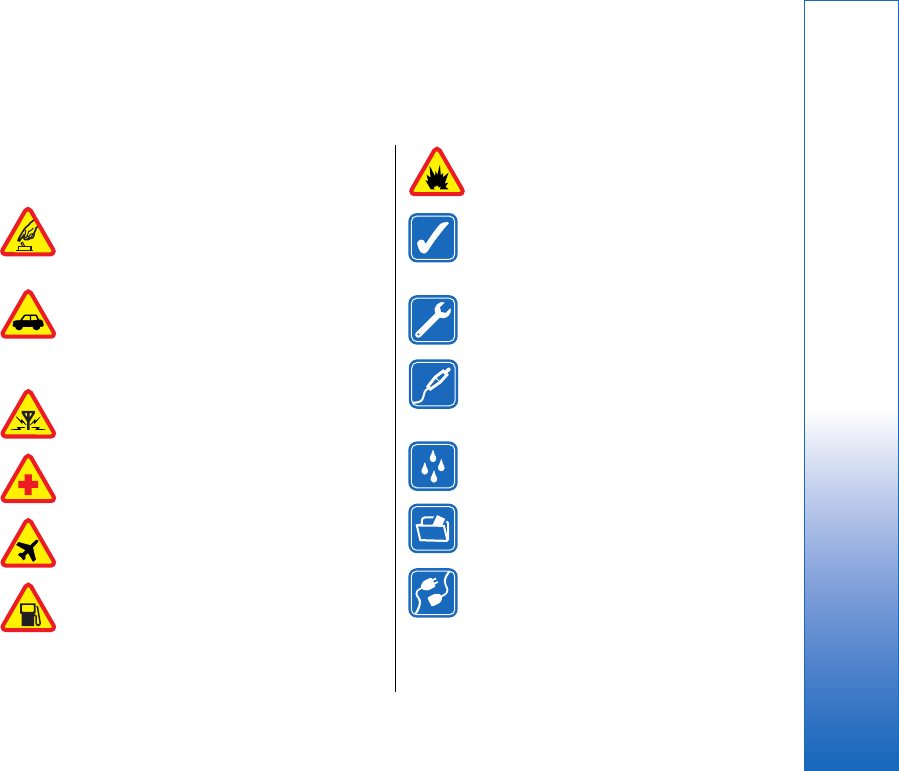
For your safety
Read these simple guidelines. Not following them may
be dangerous or illegal. Read the complete user guide
for further information.
SWITCH ON SAFELY
Do not switch the device on when wireless
phone use is prohibited or when it may
cause interference or danger.
ROAD SAFETY COMES FIRST
Obey all local laws. Always keep your hands
free to operate the vehicle while driving.
Your first consideration while driving should
be road safety.
INTERFERENCE
All wireless devices may be susceptible to
interference, which could affect performance.
SWITCH OFF IN HOSPITALS
Follow any restrictions. Switch the device off
near medical equipment.
SWITCH OFF IN AIRCRAFT
Follow any restrictions. Wireless devices can
cause interference in aircraft.
SWITCH OFF WHEN REFUELLING
Don't use the device at a refuelling point.
Don't use near fuel or chemicals.
SWITCH OFF NEAR BLASTING
Follow any restrictions. Don't use the device
where blasting is in progress.
USE SENSIBLY
Use only in the normal position as explained
in the product documentation. Don't touch
the antenna unnecessarily.
QUALIFIED SERVICE
Only qualified personnel may install or repair
this product.
ENHANCEMENTS AND BATTERIES
Use only approved enhancements and
batteries. Do not connect incompatible
products.
WATER-RESISTANCE
Your device is not water-resistant. Keep it dry.
BACK-UP COPIES
Remember to make back-up copies or keep a
written record of all important information.
CONNECTING TO OTHER DEVICES
When connecting to any other device, read
its user guide for detailed safety instructions.
Do not connect incompatible products.
7
For your safety
file:///C:/USERS/MODEServer/rapi/7167389/rae-6_mini/en/issue_1/rae-6_mini_en_1.xml Page 7 Nov 22, 2004 2:59:20 PM
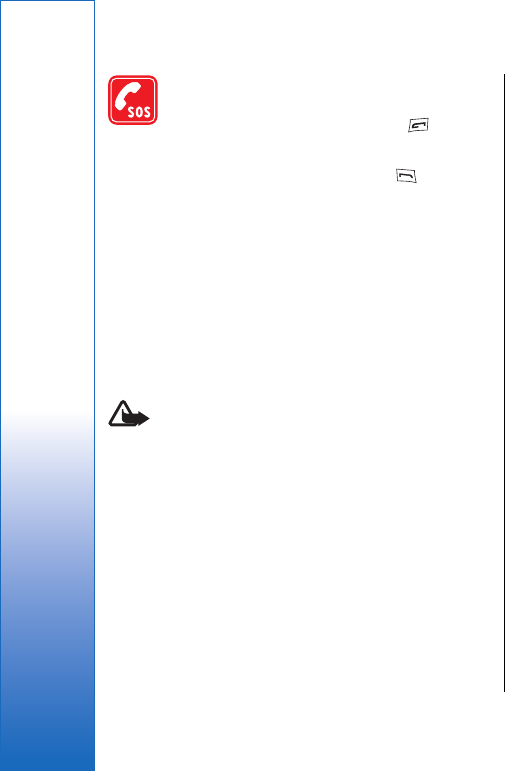
EMERGENCY CALLS
Ensure the phone function of the device is
switched on and in service. Press as many
times as needed to clear the display and
return to the start screen. Key in the
emergency number, then press . Give your
location. Do not end the call until given
permission to do so.
ABOUT YOUR DEVICE
The wireless device described in this guide is approved
for use on the EGSM900/GSM1800/GSM1900 network.
Contact your service provider for more information
about networks.
When using the features in this device, obey all laws
and respect privacy and legitimate rights of others.
Warning: Do not switch the device on when
wireless device use may cause interference or danger.
NETWORK SERVICES
To use the phone you must have service from a wireless
service provider. Many of the features in this device
depend on features in the wireless network to function.
These Network Services may not be available on all
networks or you may have to make specific
arrangements with your service provider before you
can utilize Network Services. Your service provider may
need to give you additional instructions for their use
and explain what charges will apply. Some networks
may have limitations that affect how you can use
Network Services. For instance, some networks may not
support all language-dependent characters and services.
Your service provider may have requested that certain
features be disabled or not activated in your device. If
so, they will not appear on your device menu. Contact
your service provider for more information.
This device supports WAP 2.0 protocols (HTTP and SSL)
that run on TCP/IP protocols. Some features of this
device, such as multimedia messages and Web browser
require network support for these technologies.
Shared memory
The following features in this device may share
memory: contacts, text messages, multimedia
messages, ringing tones, audio files, calendar and to-do
notes, files saved from any application (for example,
office documents, images, audio files, and video clips),
and downloaded applications. Use of one or more of
these features may reduce the memory available for
the remaining features sharing memory. For example,
saving many images may use all of the available
memory. Your device may display a message that the
memory is full when you try to use a shared memory
feature. In this case, delete some of the information or
entries stored in the shared memory features before
continuing.
8
For your safety
file:///C:/USERS/MODEServer/rapi/7167389/rae-6_mini/en/issue_1/rae-6_mini_en_1.xml Page 8 Nov 22, 2004 2:59:20 PMfile:///C:/USERS/MODEServer/rapi/7167389/rae-6_mini/en/issue_1/rae-6_mini_en_1.xml Page 8 Nov 22, 2004 2:59:20 PM

Enhancements, batteries,
and chargers
Check the model number of any charger before use
with this device. This device is intended for use when
supplied with power from ACP-12, AC-1, and LCH-12.
Warning: Use only batteries, chargers, and
enhancements approved by Nokia for use with this
particular model. The use of any other types may
invalidate any approval or warranty, and may be
dangerous.
For availability of approved enhancements, please
check with your dealer. When you disconnect the
power cord of any enhancement, grasp and pull the
plug, not the cord.
Your device and its enhancements may contain small
parts. Keep them out of reach of small children.
9
For your safety
file:///C:/USERS/MODEServer/rapi/7167389/rae-6_mini/en/issue_1/rae-6_mini_en_1.xml Page 9 Nov 22, 2004 2:59:20 PMfile:///C:/USERS/MODEServer/rapi/7167389/rae-6_mini/en/issue_1/rae-6_mini_en_1.xml Page 9 Nov 22, 2004 2:59:20 PM
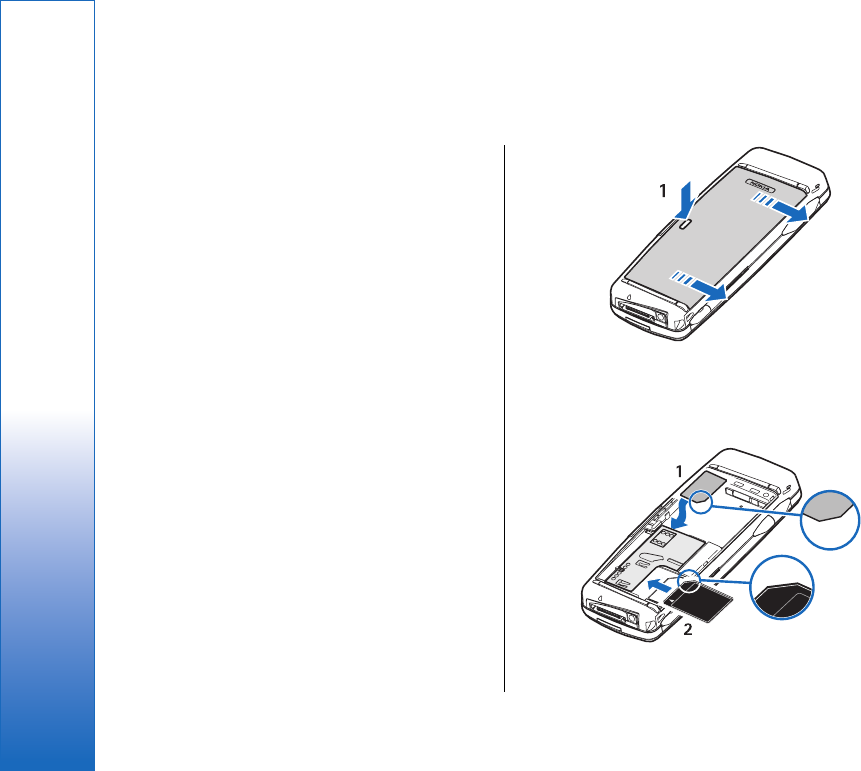
Getting started
The Nokia 9300 smartphone offers you various
business applications, such as e-mail, office tools, and
Web browsing, and flexible and fast network
connections with EGPRS (EDGE).
Installing the SIM card,
battery, and memory card
Keep all SIM cards out of the reach of small children. For
availability and information on using SIM card services,
contact your SIM card vendor. This may be the service
provider, network operator, or other vendor.
Use only compatible MultiMediaCards (MMC) with this
device. Other memory cards, such as Secure Digital (SD)
cards, do not fit in the MMC card slot and are not
compatible with this device. Using an incompatible
memory card may damage the memory card as well as
the device, and data stored on the incompatible card
may be corrupted.
1. Always switch the device off and disconnect the
charger before removing the battery.
With the back of the device facing you, press the
back cover release button (1), and slide the cover in
the direction of the arrows.
2. Insert the SIM card into the SIM card slot (1).
Make sure that the beveled corner of the SIM card is
pointing down and the contact area on the card is
facing downwards. Always remove the battery
before inserting or removing a SIM card.
10
Getting started
file:///C:/USERS/MODEServer/rapi/7167389/rae-6_mini/en/issue_1/rae-6_mini_en_1.xml Page 10 Nov 22, 2004 2:59:20 PM
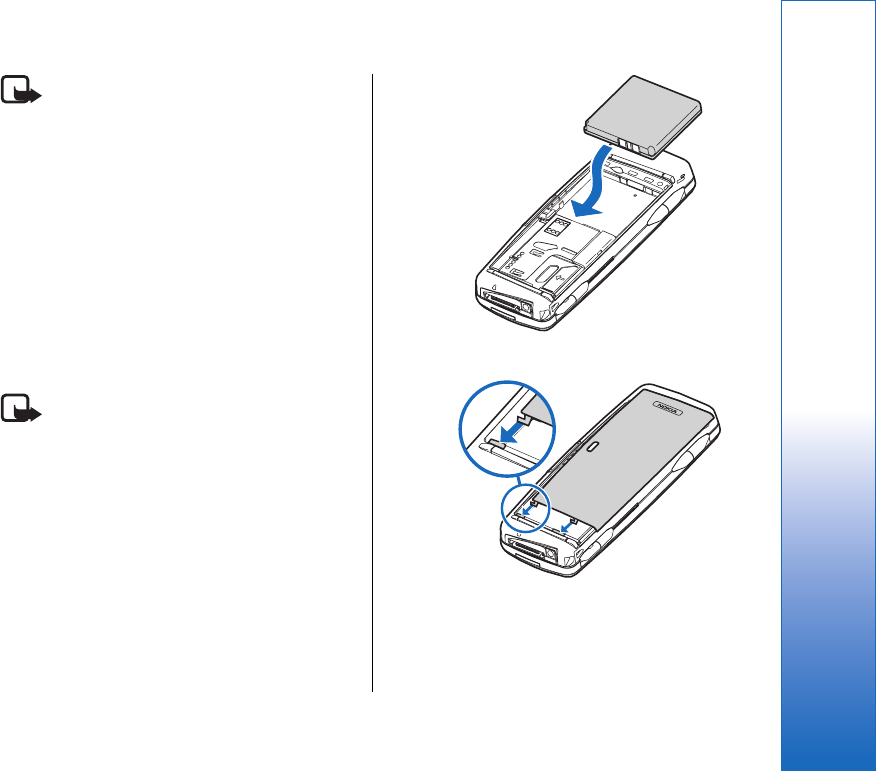
3. Note: Before you use an existing compatible
memory card with your Nokia 9300, you must
convert the memory card with Data mover and
reinstall the applications that you previously
installed to the memory card. However, do not
reinstall any pre-installed applications for the Nokia
9210 Communicator. Your Nokia 9300 contains a
later version of these applications, and these later
versions must be used with Nokia 9300.
If you have a memory card, slide the memory card
into the memory card slot (2).
Make sure that the beveled corner of the memory
card is pointing towards the SIM card slot and the
contact area is facing downwards. Note that the
back cover must be in place for the device to
recognize the memory card.
4. Note: Do not remove the MMC card in the
middle of an operation when the card is being
accessed. Removing the card in the middle of an
operation may damage the memory card as well as
the device, and data stored on the card may be
corrupted.
If you have a memory card, you can remove a
memory card after you have removed the back
cover even when the battery is inserted.
5. Insert the battery. Align the contacts of the battery
with the corresponding connectors on the battery
compartment.
6. Insert the locking catches of the back cover into the
corresponding slots, and slide the cover into place.
Charging the battery
1. Connect the charger to an AC wall outlet.
11
Getting started
file:///C:/USERS/MODEServer/rapi/7167389/rae-6_mini/en/issue_1/rae-6_mini_en_1.xml Page 11 Nov 22, 2004 2:59:20 PMfile:///C:/USERS/MODEServer/rapi/7167389/rae-6_mini/en/issue_1/rae-6_mini_en_1.xml Page 11 Nov 22, 2004 2:59:20 PM
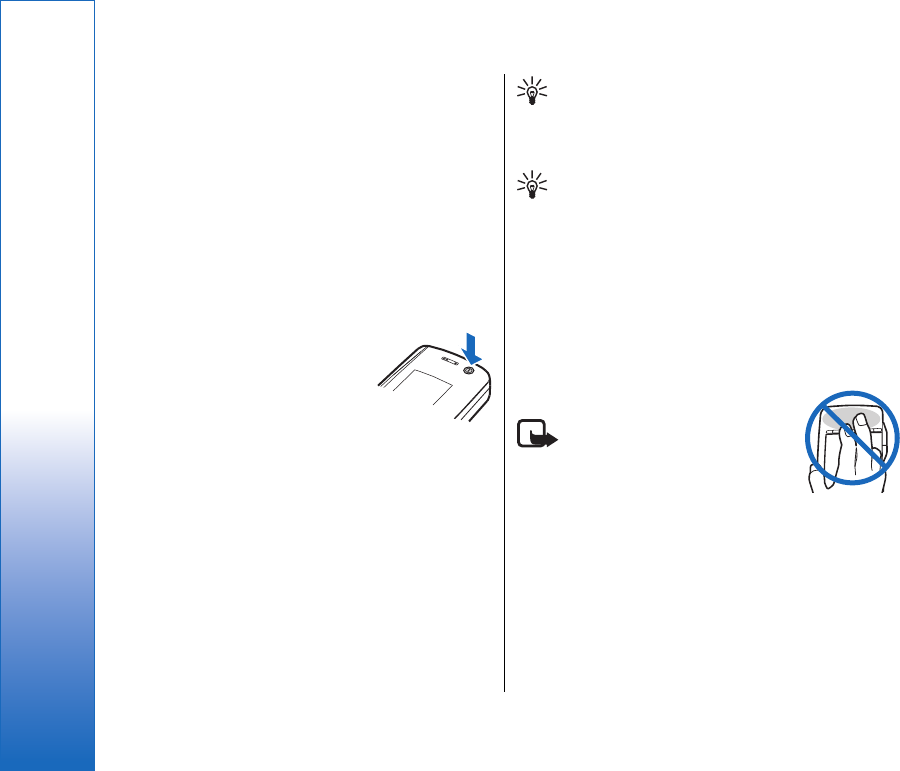
2. Connect the power cord to the bottom of the device.
See Figure Keys and connectors on page 13. The
battery indicator bar starts scrolling on both
displays. If the battery is totally discharged, it may
take a few minutes before the charging indicator is
shown. The device can be used while charging.
3. When the battery is fully charged, the bar stops
scrolling. Disconnect the charger from the device
and then from the AC outlet.
Switching the device on
and off
To switch the cover phone on, press
and hold the power key. The power
key switches only the cover phone on,
it does not affect the communicator
interface, which switches itself on
when you open the cover. The
communicator interface is switched completely on and
off by inserting and removing the battery. The
communicator interface can be used without the phone
functions when a SIM card is not inserted or when the
Offline profile is selected.
If the device asks for a PIN or security code, enter the
code, and press OK.
To switch the cover phone off, press and hold the
power key. To switch the communicator interface
completely off, remove the battery.
Tip: When you switch the phone on, it may
recognize the SIM card provider and configure
the correct text message, multimedia message,
and GPRS settings automatically. If not, contact
your service provider for the correct settings.
Tip: If you have removed the battery and
inserted it back quickly, you may need to press
the power key once before the communicator
interface starts up.
The communicator interface starts up first after the
battery is inserted. You cannot switch on the cover
phone immediately after the battery has been inserted,
you must wait until the communicator interface has
started.
Antenna
Your device has an internal antenna.
Note: As with any other radio
transmitting device, do not touch the
antenna unnecessarily when the device
is switched on. Contact with the antenna
affects call quality and may cause the
device to operate at a higher power level than
otherwise needed. Avoiding contact with the antenna
area when operating the device optimises the antenna
performance and the battery life.
12
Getting started
file:///C:/USERS/MODEServer/rapi/7167389/rae-6_mini/en/issue_1/rae-6_mini_en_1.xml Page 12 Nov 22, 2004 2:59:20 PMfile:///C:/USERS/MODEServer/rapi/7167389/rae-6_mini/en/issue_1/rae-6_mini_en_1.xml Page 12 Nov 22, 2004 2:59:20 PM
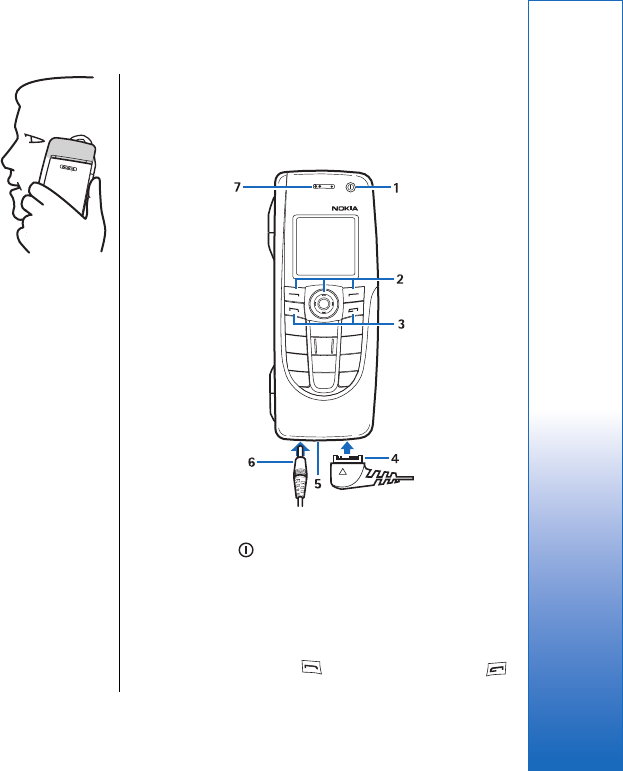
Normal position: Hold the device with
the antenna pointed up and over your
shoulder.
First start-up
The first time you switch your device on, you need to
set some basic settings. You can change the settings
later. Open the cover and follow the instructions on the
communicator display.
1. Select the language for the device, and press OK.
2. Select your home city from the list, and press OK.
You can browse for a city by starting to type the
name of the city, or using the joystick or arrow keys.
It is important to select the correct city, because
scheduled calendar entries that you create can
change when the home city is changed.
3. Set the time and date, and press OK.
4. Press OK to create your own contact card.
5. Enter your contact card information, and press OK.
6. Press OK.
The default folders, such as C:\My files\ and its
subfolders, are created during the first start-up. Note
that if you change the language of the device later,
folder names do not change.
Keys and connectors
Keys and connectors
1—Power key .
2—Scroll key, left and right selection keys. Press the
center of the scroll key, or press either selection key to
perform the function shown above it on the display.
The phone volume can be controlled with the scroll key
during a call.
3—Call key (on the left, ), End key (on the right, ).
13
Getting started
file:///C:/USERS/MODEServer/rapi/7167389/rae-6_mini/en/issue_1/rae-6_mini_en_1.xml Page 13 Nov 22, 2004 2:59:20 PMfile:///C:/USERS/MODEServer/rapi/7167389/rae-6_mini/en/issue_1/rae-6_mini_en_1.xml Page 13 Nov 22, 2004 2:59:20 PM
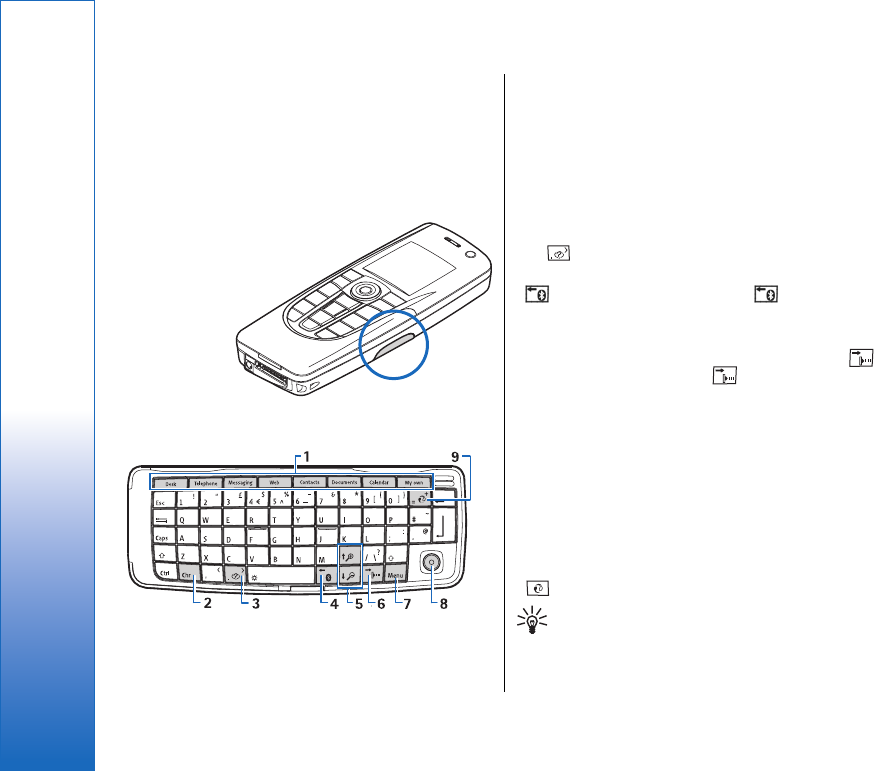
4—PopPort™ connector for the USB data cable,
headset, and loopset.
5—Microphone. Make sure that you do not cover the
microphone with your hand during phone calls.
6—Charger connector.
7—Earpiece.
The graphic shows the location of the infrared port.
Communicator interface
Communicator keyboard
1—Application buttons. Each button starts the
corresponding application, except My own key, which
you can configure to open any application. Press Ctrl
+My own key to select the application you want the My
own key to open. Note that you can open these
applications from Desk, too.
2—Character key. Opens a character table where you
can select special characters. Press Chr+keys with blue
symbols to access characters and functions behind key
combinations.
3—Help key. To get support using your device, press
Chr+ .
4—Bluetooth key. To activate Bluetooth, press the Chr
+. To deactivate, press the Chr+ again.
5—The Zoom keys. Pressing Chr+zoom keys makes the
fonts and some icons larger or smaller.
6—Infrared key. To activate infrared, press Chr+ .
To deactivate, press the Chr+ again.
7—Menu key. Press the Menu key to open the menu or
in multipage dialogs to move from one page to another.
8—Joystick. Move the joystick to the left, right, up or
down to scroll through different lists. Press the center
of the joystick to select or to perform the function of an
underlined command button. To change the
acceleration or the speed at which the cursor moves,
select Desk → Tools → Control panel → General
→ Display → Cursor settings.
9—Sync key. Establish a connection, and press Chr
+ to synchronize your device with a compatible PC.
Tip: You can use the arrow keys or the joystick
to move on the menus and the display, for
example in the Web application. The left arrow
key is on the Bluetooth key (4), the up and
14
Getting started
file:///C:/USERS/MODEServer/rapi/7167389/rae-6_mini/en/issue_1/rae-6_mini_en_1.xml Page 14 Nov 22, 2004 2:59:20 PMfile:///C:/USERS/MODEServer/rapi/7167389/rae-6_mini/en/issue_1/rae-6_mini_en_1.xml Page 14 Nov 22, 2004 2:59:20 PM
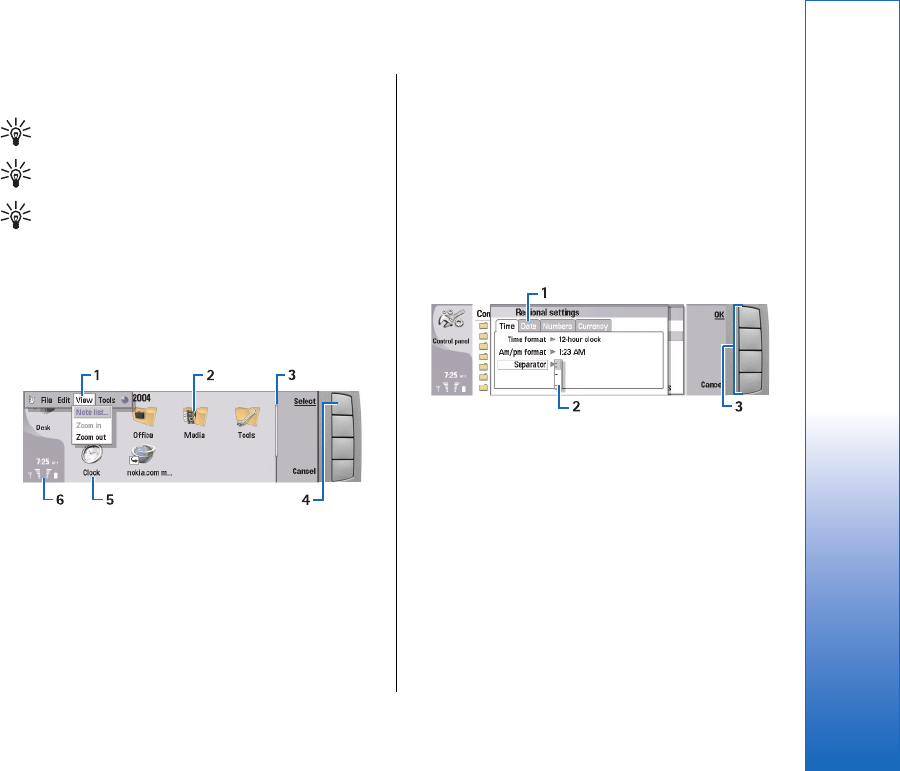
down arrow keys on the zoom keys (5), and the
right arrow key on the infrared key (6).
Tip: Press Esc to cancel selections and close
dialogs.
Tip: Press the backspace key to delete items
such as calendar entries and messages.
Tip: To write Latin characters, press
simultaneously both Shift keys on the
communicator keyboard, then write the text.
To switch back to the Cyrillic alphabet, press
both Shift keys again.
The communicator display turns on when you open the
cover. The application that was active the last time the
device was used is shown on the display. When you
close the cover, the communicator display turns off.
Desk main view
1—Menu. Press the Menu key to open the menu. You
can use the joystick or the arrow keys to move in the
menu, and press the enter key to select a menu option.
2—Folder. You can group applications, shortcuts, and
notes to different folders. See Creating new groups on
page 28.
3—Scroll bar. For example, if you have a long file in
Documents, the scroll bar helps you estimate where
you are in the file, and how much of the file you can
see. The longer the scroll bar, the more you can see of
the file.
4—Command buttons. The commands on the right
side of the display correspond to the command
buttons. Note that when a command is dimmed, it
cannot be used.
5—Application. To open an application from Desk,
select the application, and press Open or the enter key.
6—Indicator area. The indicator area shows
application and system-related information.
Multipage dialog
1—Dialog pages. You can move from one page to
another by pressing the menu key.
2—Selection list. You can view different options in a
selection list, and select one of them.
3—Command buttons. You can use the command
buttons to perform functions on a dialog page, or in a
selection list.
If there is more than one frame on the display, the
selected frame is always highlighted. You can move
between the frames by pressing the tab key.
15
Getting started
file:///C:/USERS/MODEServer/rapi/7167389/rae-6_mini/en/issue_1/rae-6_mini_en_1.xml Page 15 Nov 22, 2004 2:59:20 PMfile:///C:/USERS/MODEServer/rapi/7167389/rae-6_mini/en/issue_1/rae-6_mini_en_1.xml Page 15 Nov 22, 2004 2:59:20 PM

Switching between open applications
To switch between open applications, press Menu,
select , and select the application. You can also close
applications in the application list.
Tip: Press Chr+the tab key to switch between
open applications. Press Chr+the tab key again
to move in the list.
About the display
A small number of missing, discolored, or bright dots
may appear on the screen. This is a characteristic of this
type of display. Some displays may contain pixels or
dots that remain on or off. This is normal, not a fault.
About the Menu key
The communicator keyboard has a Menu key. Press the
Menu key to access the various menu options. The
options available depend on the application you are in.
The chosen option affects the item that is currently
selected or open. In multipage dialogs you can use the
Menu key to move from one page to another.
Scrolling and making selections
Use the arrow keys or the joystick to move the cursor
and make selections on the communicator interface.
Scrolling on the communicator interface
There are four separate arrow keys that you can use for
scrolling. Scrolling means that you move up, down, left
and right in the application groups on Desk, in an
application, in the text, or in the Menu. The joystick
functions similarly to the arrow keys, but you can also
press the joystick down to open files or perform the
function of an underlined command button.
Making selections
To select text left of the cursor, press and hold the Shift
key, and press the left arrow key until you have
selected the text. To select text right of the cursor, press
and hold the Shift key, and press the right arrow key
until you have selected the text.
To select different items, such as messages, files, or
contacts, press the arrow keys up, down, left or right to
scroll to the item you want.
To select items one by one, scroll to the first item, press
and hold the Ctrl key, scroll to the next item, and press
space bar to select it.
To select an object in a file, for example an attachment
in a document, move the cursor onto the object so that
square markers appear on each side of the object.
To select a cell in a worksheet, move the cursor to the
cell you want. To select an entire row, move the cursor
to the first cell of the first column on that row, and
press Shift+the left arrow key. To select an entire
column, move the cursor to the first cell of the column
you want to select, and press Shift+the up arrow key.
Common actions in several
applications
You can find the following actions in several
applications:
16
Getting started
file:///C:/USERS/MODEServer/rapi/7167389/rae-6_mini/en/issue_1/rae-6_mini_en_1.xml Page 16 Nov 22, 2004 2:59:20 PMfile:///C:/USERS/MODEServer/rapi/7167389/rae-6_mini/en/issue_1/rae-6_mini_en_1.xml Page 16 Nov 22, 2004 2:59:20 PM
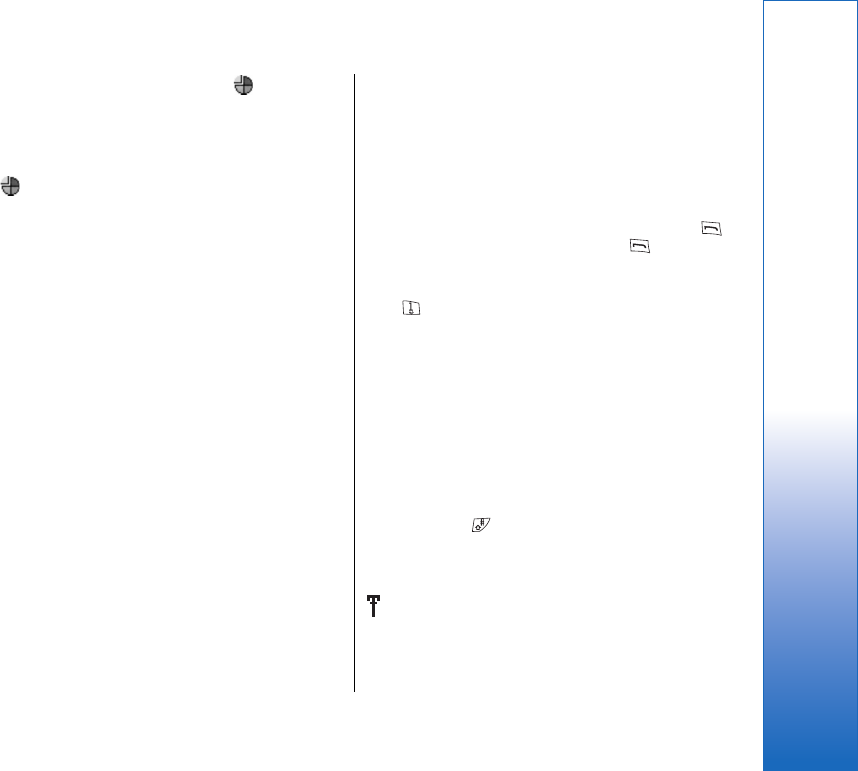
To change the profile, press Menu, select , and scroll
to the profile you want. To modify the profile settings,
such as the ringing tones, select the profile and press
Edit.
To activate a profile for a certain time, press Menu,
select , and select the desired profile. Press Timed,
and set the time (up to 24 hours) when you want the
profile setting to end. When the end time is reached,
the previous profile, which was not timed, becomes
active.
To save a file, press Menu, and select File → Save.
There are different save options depending on the
application you use.
To send a file, press Menu, and select File → Send. You
can send a file as an e-mail, fax, short message, or
multimedia message; or send them using infrared or
Bluetooth.
To add a shortcut, press Menu, and select File → Add
to Desk. Scroll to the group to which you want to add
the shortcut, and press Select. After you have selected
the group, press OK. For example, you can add
shortcuts to files or Web pages.
To print to a compatible printer, press Menu, and select
File → Printing. You can preview items that you want
to print, or edit the way printed pages look.
To cut, copy, and paste, press Menu, and select Edit, and
Cut, Copy, and Paste.
To delete a file, press Menu, and select Edit → Delete.
To zoom in or out, press Menu, and select View →
Zoom and the zoom type you want. You can also press
Chr+zoom keys to zoom in or out.
To insert special characters to text, press the Chr key.
Cover phone
To view the most recently dialed numbers, press .
Scroll to a number or name, and press again to call
the number.
To call your voice mailbox (network service), press and
hold .
To view received text messages, press the scroll key
right.
To open the contacts list, press the scroll key down.
To write and send text messages, press the scroll key
left.
To change the profile, press the power key briefly, and
scroll to the profile you want. Press Select to activate
the profile.
To switch between two phone lines (network service),
press and hold .
Display indicators
The signal strength of the cellular network at your
current location. The higher the bar, the stronger the
signal.
17
Getting started
file:///C:/USERS/MODEServer/rapi/7167389/rae-6_mini/en/issue_1/rae-6_mini_en_1.xml Page 17 Nov 22, 2004 2:59:20 PMfile:///C:/USERS/MODEServer/rapi/7167389/rae-6_mini/en/issue_1/rae-6_mini_en_1.xml Page 17 Nov 22, 2004 2:59:20 PM
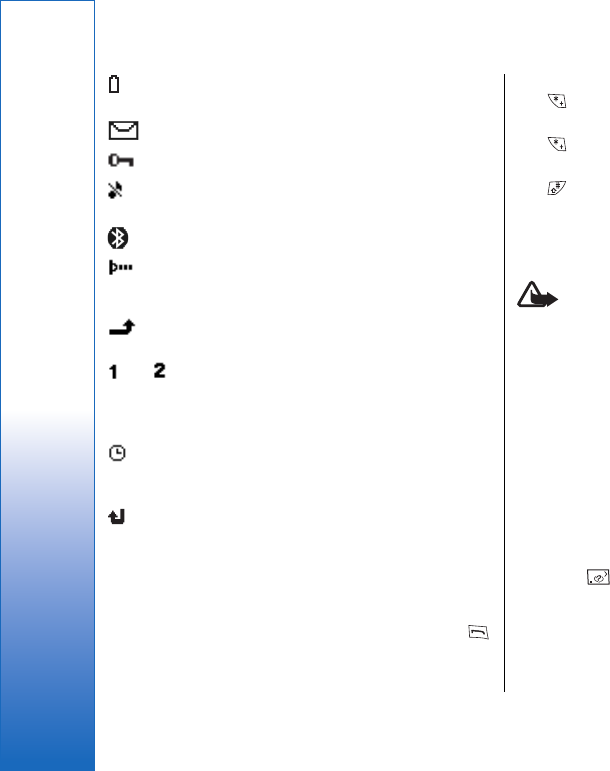
The battery charge level. The higher the bar, the
stronger the charge in the battery.
You have received a message.
You have locked the cover phone keypad.
You have selected the silent profile, and the device
does not ring for an incoming call or message.
Bluetooth is activated.
You have an active infrared connection. If the
indicator blinks, your device is trying to connect to the
other device, or the connection has been lost.
You have selected all your calls to be diverted to
another number (network service).
and Indicates the phone line that you have
selected in the Settings → Call settings → Line for
outgoing calls menu, if you have subscribed to two
phone lines (network service).
The timed profile is active. You can modify the
profile settings, such as the ringing tones, in Control
panel. See Profile settings on page 78.
You have missed a phone call.
Keypad lock (Keyguard)
When the keypad lock is on, calls still may be possible
to the official emergency number programmed into
your device. Key in the emergency number and press .
Use the keypad lock (keyguard) to prevent the keys on
the cover phone from being accidentally pressed.
To lock the keypad, press the center of the scroll key
and .
To unlock the keypad, press the center of the scroll key
and .
To lock the system, press the center of the scroll key
and . Note that you have to define a lock code with
which you can lock and unlock the system.
Volume control
Warning: Do not hold the device near your ear
when the loudspeaker is in use, because the volume
may be extremely loud.
To adjust the volume level during a call, press the scroll
key left or right.
To adjust the volume level when using the loudspeaker,
open Telephone, and scroll left or right with the
joystick.
Instructions in your
device
To view instructions on the applications in your device,
press Chr+ . The device help contains detailed
instructions, which you conveniently carry with you all
the time.
18
Getting started
file:///C:/USERS/MODEServer/rapi/7167389/rae-6_mini/en/issue_1/rae-6_mini_en_1.xml Page 18 Nov 22, 2004 2:59:20 PMfile:///C:/USERS/MODEServer/rapi/7167389/rae-6_mini/en/issue_1/rae-6_mini_en_1.xml Page 18 Nov 22, 2004 2:59:20 PM

Using the CD-ROM
The sales package CD-ROM is compatible with Windows
98SE, Windows ME, Windows 2000, and Windows XP.
The CD-ROM should launch itself after you have inserted
it into the CD-ROM drive of a compatible PC. If not, open
Windows Explorer, right-click the CD-ROM drive where
you inserted the CD-ROM, and select AutoPlay.
You can find the extended User Guide for Nokia 9300
and some additional guides in the CD-ROM.
You can also install the Nokia PC Suite and read the
User's Guide for Nokia PC Suite from the CD-ROM. Note
that Nokia PC Suite can be used only with Windows
2000 and Windows XP.
Nokia support on the Web
Check www.nokia.com or your local Nokia Web site for
the latest version of this guide, additional information,
downloads, and services related to your Nokia product.
Stickers in the sales
package
The stickers in the sales package contain important
information for service and customer support purposes.
The sales package also includes instructions on how
you should use these stickers.
Transferring data from
other devices
There are several ways to transfer data, such as
contacts or calendar information, to your Nokia 9300
from compatible devices. See Data and software
management on page 96.
19
Getting started
file:///C:/USERS/MODEServer/rapi/7167389/rae-6_mini/en/issue_1/rae-6_mini_en_1.xml Page 19 Nov 22, 2004 2:59:20 PMfile:///C:/USERS/MODEServer/rapi/7167389/rae-6_mini/en/issue_1/rae-6_mini_en_1.xml Page 19 Nov 22, 2004 2:59:20 PM
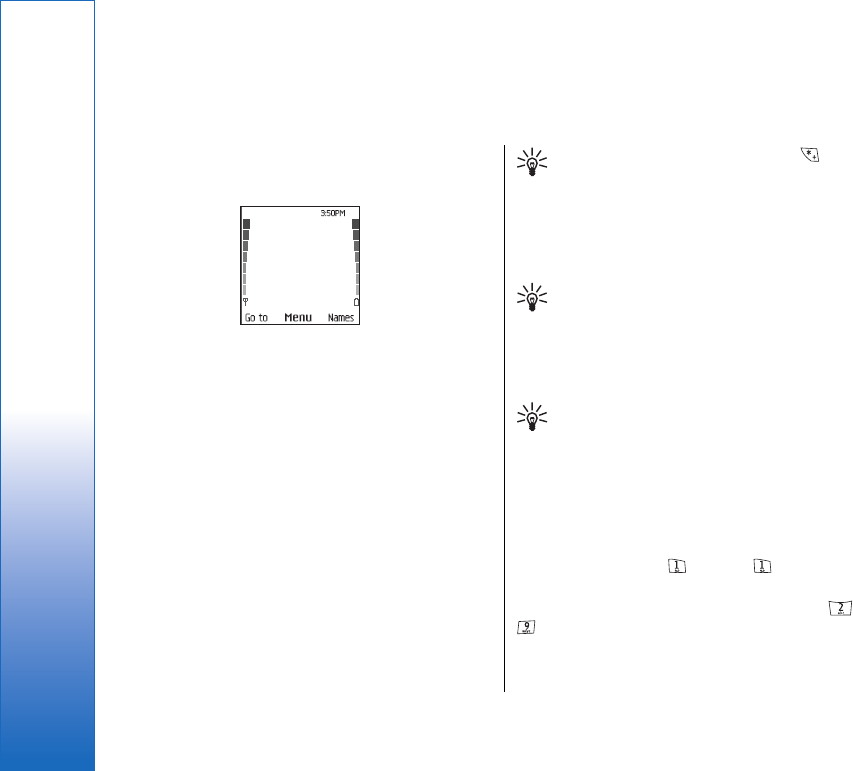
Cover phone
With the cover phone, you can, for example, make and
receive calls, and change profiles. Most of these features
are also available in the communicator interface.
Cover phone display, standby mode
For more advanced tasks, use the communicator
interface which you can access by opening the cover. If
you open the cover during a call, the loudspeaker is
activated. You can also use the applications during a call.
Making a call
To make and receive calls, the cover phone must be
switched on, the device must have a valid SIM card
installed, and you must be located in a service area of
the cellular network.
A GPRS connection is put on hold during voice calls.
To make a call, key in the phone number, including the
area code. If you key in an incorrect character, press
Clear.
Tip: For international calls, press twice to
add the + character that replaces the
international access code, and key in the
country code, area code (omit the leading 0, if
necessary), and phone number.
To call the number, press the Call key. To end the call or
cancel the call attempt, press the End key.
Tip: To adjust the volume during a call, press
the scroll key right to increase or left to
decrease the volume.
To make a call using the saved contacts, scroll down in
standby mode. Key in the first letters of the saved
name. Scroll to the name, and press the Call key.
Tip: You can save new contacts in the Contacts
menu in the phone or in the Contacts
directory dialog in the communicator interface.
To call a recently dialed number, in standby mode,
press the Call key to view up to 20 numbers that you
have last called or attempted to call. Scroll to the
desired number or name, and press the Call key.
To call your voice mailbox (network service), in standby
mode, press and hold , or press and the Call key.
To call a phone number using speed dialing when you
have assigned the number to one of the keys to
, do as follows: Press the desired number key and
the Call key in standby mode, or if the Speed dialling
function is set on, press and hold the number key in
standby mode until the call is started. To assign a
20
Cover phone
file:///C:/USERS/MODEServer/rapi/7167389/rae-6_mini/en/issue_1/rae-6_mini_en_1.xml Page 20 Nov 22, 2004 2:59:20 PM
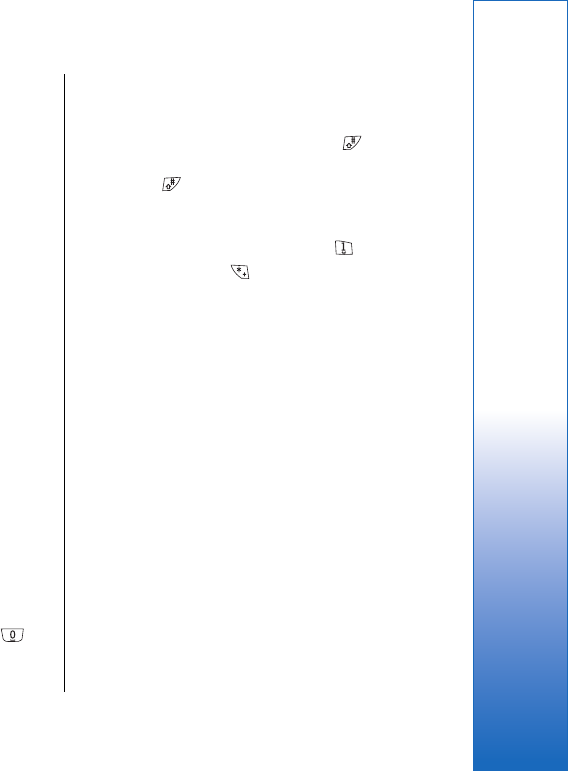
phone number to a number key, press Menu in standby
mode, and select Contacts → Speed dials. To set the
Speed dialling function on, press Menu in standby
mode, and select Settings → Call settings → Speed
dialling.
Answering a call
To answer a call, press the Call key.
To reject the call, press the End key. The call is diverted
if you have activated a call divert option such as Divert
if busy.
To mute a ringing tone instead of answering a call,
press Silence.
To answer a new call during a call when the Call
waiting function is activated, press the Call key or
Answer. The first call is put on hold. To end the active
call, press the End key.
Writing text
You can key in text, for example, when you write a text
message. Press a number key repeatedly until the
desired character appears. If the next letter is located
on the same key as the present one, wait until the
cursor is shown (or press the scroll key left, right, up, or
down to end the time-out period), and key in the letter.
The characters available depend on the language
selected for writing text. To insert a space, press .
• To delete a character to the left of the cursor, press
Clear. To delete the characters quickly, press and
hold Clear.
• To change the character case, press .
• To change between letter and number mode, press
and hold .
• To insert a number in letter mode, press and hold
the desired number key.
• To insert a special character, press repeatedly.
Alternatively, press , scroll to the desired
character, and press Use.
Accessing the menu
functions
The cover phone offers a set of menu functions.
Most of these functions are provided with a brief help
text. To view the help text, scroll to the menu function,
and wait for about 15 seconds. You must activate help
texts in Settings → Telephone settings before they
are shown.
Accessing a menu function
To access a function by scrolling, press Menu in standby
mode, scroll to the desired main menu, for example,
Settings, and press Select. Scroll to a submenu, for
example, Call settings, and press Select. Scroll to a
setting, and press Select.
To access a function by using a menu shortcut, press
Menu in standby mode, and within 2 seconds, key in
the shortcut number of the menu, submenu, and
21
Cover phone
file:///C:/USERS/MODEServer/rapi/7167389/rae-6_mini/en/issue_1/rae-6_mini_en_1.xml Page 21 Nov 22, 2004 2:59:20 PMfile:///C:/USERS/MODEServer/rapi/7167389/rae-6_mini/en/issue_1/rae-6_mini_en_1.xml Page 21 Nov 22, 2004 2:59:20 PM
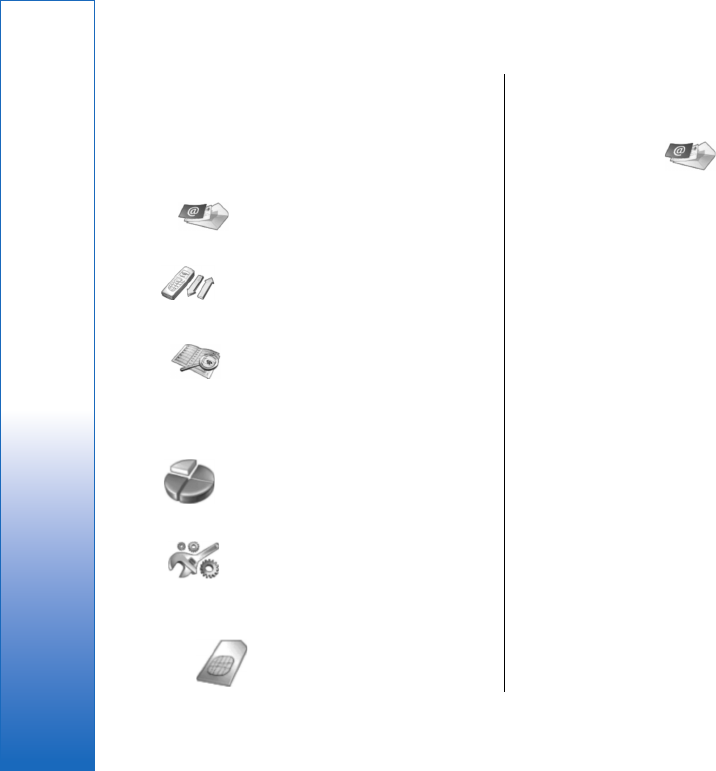
setting that you want to use. The shortcut number is
shown at the top right of the display.
To return to the previous menu level, press Back. To
exit the menu from the main menu list, press Exit. You
can also exit the menu by pressing the End key.
Menu structure
Messages 1 Write message, 2 Folders, 3
Voice messages, 4 Service
commands
Call log
1 Missed calls, 2 Received
calls, 3 Dialled numbers, 4
Delete recent call lists, 5 Call
duration
Contacts
1 Search, 2 Add contact, 3
Delete, 4 Settings, 5 Speed
dials, 6 Service numbers
(shown if supported by your SIM
card), 7 My numbers (shown if
supported by your SIM card)
Profiles
Contains setting groups
(profiles) that you can activate.
Only one profile can be active at
a time.
Settings
1 Call settings, 2 Telephone
settings, 3 Security settings, 4
Display settings, 5 Time and
date settings, 6 Right
selection key
SIM services
Allows you to use the additional
functions available on your SIM
card. This menu is only available
if supported by your SIM card.
Messages
Your device supports the sending of text messages
beyond the normal 160-character limit. If your message
exceeds 160 characters, it will be sent as a series of two
or more messages.
At the top of the display, you can see the message
length indicator counting backwards from 160. For
example, 10/2 means that you can still add 10
characters for the text to be sent as two messages.
Note that using special (Unicode) characters such as ë,
â, á, take up more space.
If there are special characters in your message, the
indicator may not show the message length correctly.
Before the message is sent, the device tells you if the
message exceeds the maximum length allowed for one
message.
Press Menu, and select Messages.
You can write other types of messages on the
communicator interface. See Messaging on page 34.
When sending messages, your device may display the
words Message sent. This is an indication that the
message has been sent by your device to the message
centre number programmed into your device. This is
not an indication that the message has been received
at the intended destination. For more details about
messaging services, check with your service provider.
To write a text message, select Write message, and
22
Cover phone
file:///C:/USERS/MODEServer/rapi/7167389/rae-6_mini/en/issue_1/rae-6_mini_en_1.xml Page 22 Nov 22, 2004 2:59:20 PMfile:///C:/USERS/MODEServer/rapi/7167389/rae-6_mini/en/issue_1/rae-6_mini_en_1.xml Page 22 Nov 22, 2004 2:59:20 PM
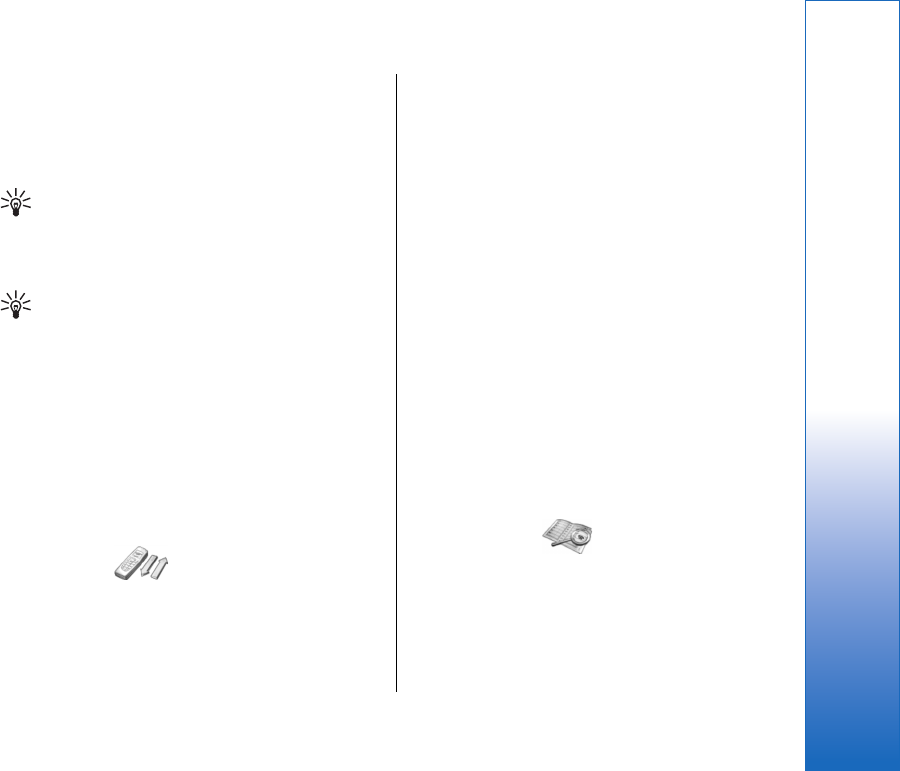
write the message. To send the message, press the Call
key or Send, and enter the recipient's phone number,
or press Search to search for it in the contacts list. If
you press Options while writing the message, you can,
for example, send the message to several recipients, or
save the message for later use.
Tip: To access the short message editor in
standby mode, press the scroll key left.
To view the contents of a text message folder, select
Folders and the desired folder. To create a new folder,
press Options in the folder list and select Add folder.
Tip: To open the Inbox folder in standby mode,
press the scroll key right.
To define or edit your voice mailbox number (network
service), select Voice messages → Voice mailbox
number. Key in the number, or search for it in the
contacts list. You can obtain the voice mailbox number
from your service provider or network operator.
To listen to your voice messages (network service),
select Voice messages → Listen to voice messages.
To send a service command to your service provider
(network service), select Service commands. Write the
command, and press the Call key or Send.
Call log
You can view the phone numbers of missed, received,
and dialed calls, and the approximate length of your
calls.
The phone saves missed and received calls only if the
network supports these functions and if the phone is
switched on and within the network service area.
Press Menu, and select Call log.
To view recent calls information, select Missed calls,
Received calls, or Dialled numbers. If you press
Options when the number list is shown, you can, for
example, view the time of call, send a text message to
the caller, save the number in the contacts list, or add
the number to a name saved in the contacts list.
To erase the call lists, select Delete recent call lists,
and select what calls you want to erase. You cannot
undo the operation.
The actual invoice for calls and services from your
service provider may vary, depending on network
features, rounding off for billing, taxes and so forth. To
view the approximate duration of your incoming and
outgoing calls, select Call duration. You can also reset
the timers.
You can also view recent calls information on the
communicator interface. See Viewing dialed, received,
and missed calls on page 30.
Contacts
You can view and manage the names and phone
numbers (contacts) that you have saved in the phone
memory or the SIM card.
In the phone memory, you can save names with several
phone numbers. The number of names that you can
save depends on the amount of information you have
saved for each name.
23
Cover phone
file:///C:/USERS/MODEServer/rapi/7167389/rae-6_mini/en/issue_1/rae-6_mini_en_1.xml Page 23 Nov 22, 2004 2:59:20 PMfile:///C:/USERS/MODEServer/rapi/7167389/rae-6_mini/en/issue_1/rae-6_mini_en_1.xml Page 23 Nov 22, 2004 2:59:20 PM
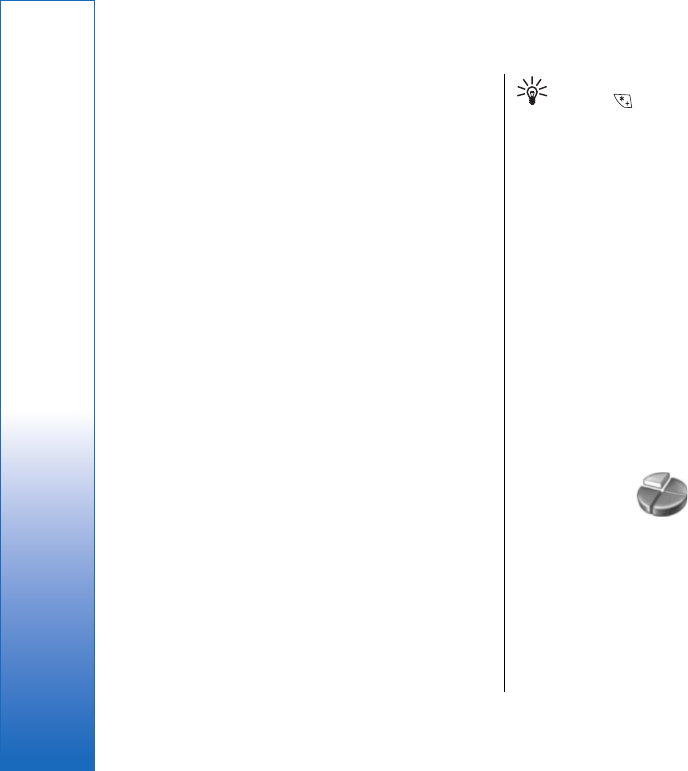
In the SIM card memory, you can save one phone
number for each name.
You can also use the more extensive Contacts
application on the communicator interface.
Shortcuts to the contacts list
You can also access the contacts list in the following
ways:
In standby mode, press Names (if available), or press
Go to, and select Contacts.
In standby mode, scroll down to the desired name,
press Details, and scroll to a number.
During a call, press Options, and select Contacts.
Searching for, adding, and
deleting contacts
To search for a contact, in standby mode, press Menu,
and select Contacts → Search, or press the scroll key
down in standby mode. Key in the first letters of the
desired name. Scroll to the desired name, and press
Details. Scroll through the phone numbers added to
the name.
To save a name and phone number in the selected
memory, press Menu, and select Contacts → Add
contact. Key in the first name, and press OK. If you are
using the telephone memory, key in the second name,
and press OK. Key in the phone number, including the
area code, and press OK. Select the number type, and
press Select → Done.
Tip: To use the phone number while abroad,
press twice (for the + character), and key in
the country code, area code (omit the leading
zero, if necessary), and phone number.
To delete contacts and all the numbers attached to
them, in standby mode, press Menu, and select
Contacts → Delete. Select One by one or Delete all.
To delete a single number added to a name, in standby
mode, scroll down to the desired name, and press
Details. Scroll to the number that you want to delete,
press Options, and select Delete number.
Settings for the contacts
In standby mode, press Menu, and select Contacts →
Settings, and one of the following options:
•Memory in use—To select the memory that you
want to use for your contacts.
•Contacts view—To select how the contacts are
shown.
Profiles
To make an emergency call while the device is in the
offline or flight profiles, you may need to enter the lock
code and change the device to a calling profile before
making any call, including a call to an emergency
number.
Press Menu, and select Profiles.
To change the profile, select the desired profile, and
select Activate.
24
Cover phone
file:///C:/USERS/MODEServer/rapi/7167389/rae-6_mini/en/issue_1/rae-6_mini_en_1.xml Page 24 Nov 22, 2004 2:59:20 PMfile:///C:/USERS/MODEServer/rapi/7167389/rae-6_mini/en/issue_1/rae-6_mini_en_1.xml Page 24 Nov 22, 2004 2:59:20 PM
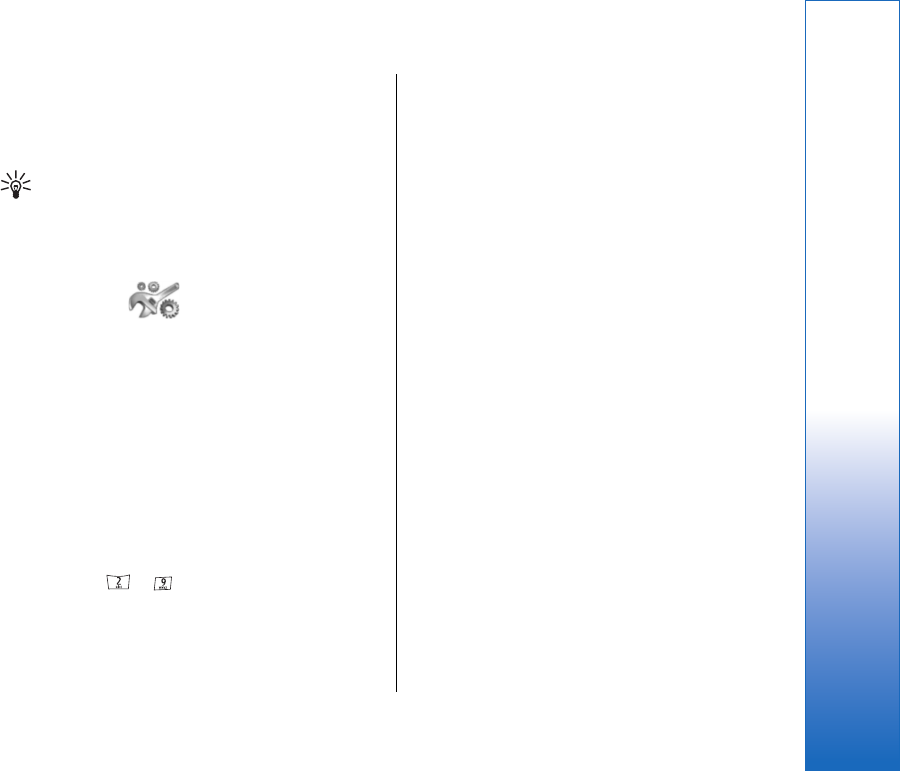
To activate a profile for a certain time, select the
desired profile and Timed. Set the time (up to 24
hours) when you wish the profile setting to end. When
the end time is reached, the previous profile, which was
not timed, becomes active.
Tip: To activate a profile in standby mode,
briefly press the power key, and select the
desired profile.
You can edit the profile settings in the communicator
interface of your device. See Profile settings on page 78.
Settings
Press Menu, and select Settings.
To adjust call settings, scroll to Call settings, and select:
•Call divert (network service)—select to direct your
incoming calls to another number such as your voice
mailbox.
•Anykey answer—select On if you want to answer
an incoming call by briefly pressing any key except
the power key, the selection keys, and the End key.
•Automatic redial—select On to set the phone to
make a maximum of 10 more attempts to connect
the call after an unsuccessful call attempt.
•Speed dialling—select On if you want to call the
names and phone numbers assigned to the speed
dialing keys to by pressing and holding the
corresponding key.
•Call waiting—select Activate to request the
network to notify you when you receive a new call
during a call (network service).
•Send my caller ID—select Yes to show your phone
number to the person you are calling (network
service). If you select Set by network, the device
will use the setting that you have agreed with your
service provider.
•Line for outgoing calls (network service)—select
the phone line 1 or 2 for making calls.If you select
Line 2 and have not subscribed to this network
service, you are not be able to make calls. However,
calls on both lines can be answered regardless of the
selected line.
To adjust phone settings, scroll to Telephone settings,
and select:
•Cell info display—to set the device to indicate
when you use it in a cellular network based on Micro
Cellular Network (MCN) technology (network service).
•Network selection—to set the device to
automatically select a cellular network available in
your area. If you select Manual, you can select a
network that has a roaming agreement with your
home service provider.
•Confirm SIM service actions—to set the phone to
show confirmation messages that are sent between
your phone and your service provider when you use
SIM card services.
Note that accessing these services may involve
sending a text message or making a phone call. You
may be charged for these services.
•Help text activation—to set the phone to show
help texts that guide you in using the menu
functions of the cover phone.
•Start-up tone—to play a tone when the cover
phone is switched on.
25
Cover phone
file:///C:/USERS/MODEServer/rapi/7167389/rae-6_mini/en/issue_1/rae-6_mini_en_1.xml Page 25 Nov 22, 2004 2:59:20 PMfile:///C:/USERS/MODEServer/rapi/7167389/rae-6_mini/en/issue_1/rae-6_mini_en_1.xml Page 25 Nov 22, 2004 2:59:20 PM

To adjust phone security settings, scroll to Security
settings, and select:
•PIN code request—to set the phone to request
your PIN code every time the phone is switched on.
Note that some SIM cards do not allow this setting to
be changed.
•Call barring service—to restrict calls (network
service).
Select the desired barring option and set it on
(Activate) or off (Cancel), or check whether the
option is active (Check status).
•Access codes—to change the security code, PIN
code, PIN2 code, or barring password.
•Lock if SIM card is changed—to set the device to
ask for the lock code when an unknown SIM card is
inserted into your device. The device maintains a list
of SIM cards that are recognized as the owner's cards.
•Lock system—to lock the device. To unlock the
device, press Unlock → in standby mode. See
Defining device lock settings on page 81.
To adjust phone display settings, scroll to Display
settings, and select:
•Colour schemes —to choose the color for some
parts of the phone display, such as the indicators for
the signal strength and battery charge level.
•Operator logo—to display or hide the operator
logo.
•Screen saver timeout—to set the period after
which the screen saver is activated.
To adjust the time and date settings, scroll to Time and
date settings.
To set the function for the right selection key in
standby mode, scroll to Right selection key, and select
the desired function from the list.
26
Cover phone
file:///C:/USERS/MODEServer/rapi/7167389/rae-6_mini/en/issue_1/rae-6_mini_en_1.xml Page 26 Nov 22, 2004 2:59:20 PMfile:///C:/USERS/MODEServer/rapi/7167389/rae-6_mini/en/issue_1/rae-6_mini_en_1.xml Page 26 Nov 22, 2004 2:59:20 PM
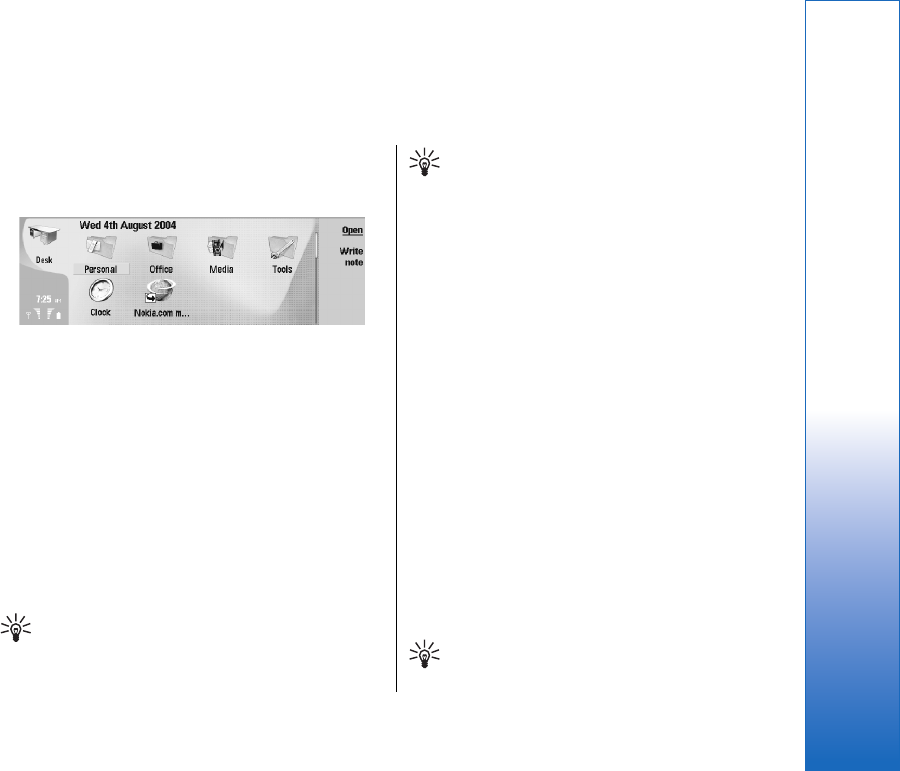
Desk
Desk is a starting point from which you can open all
applications in the device or on a memory card. Use the
joystick or arrow keys to move up and down on the
screen.
Desk shows all applications that are installed in your
device. When you install new applications, they are
shown on Desk as well. Most applications are grouped
in default groups, which are Personal, Office, Media,
and Tools. If you have applications on a memory card,
those are shown on Desk or in one of the groups,
depending on the application.
To open an application or group, or activate a shortcut,
select the application, group, or shortcut , and press
Open.
To remove an application, go to Desk → Tools →
Control panel → Data management → Application
manager.
To write a note, press Write note.
Tip: To write a note in Desk main view, you can
also press Desk.
Tip: The notes are saved to the location you
are in. For example, tips that are created from
the Office group are saved in that group You
can view a list of all notes in Desk: press menu,
and select View → Note list… .
You can add your own shortcuts to Desk from most
applications. The shortcuts can open a document or a
Web page.
To add a shortcut to Desk, press Menu, and select File
→ Add to Desk. Scroll to the group you want to add
the shortcut to, select the group, and press OK.
To remove a shortcut or note, press Menu, and select
File → Delete.
To change the order of application, shortcut, or note
icons, select the icon, press Menu, and select File →
Move. Move the icon to its new location using the
joystick or arrow keys, and press Place here. You
cannot move an application, shortcut or note to groups.
To increase or decrease the size of the icons, press
Menu, and select View → Zoom in or Zoom out.
To add or change a background image, press Menu, and
select Tools → Display settings…. Select the Desk
page, and set Wallpaper to Yes. In the Image file
field, press Change to browse for an image. Scroll an
image, and press OK.
Tip: You can set a background image for the
cover phone display on the Cover page of the
same dialog.
27
Desk
file:///C:/USERS/MODEServer/rapi/7167389/rae-6_mini/en/issue_1/rae-6_mini_en_1.xml Page 27 Nov 22, 2004 2:59:20 PM

To change the icon or name of a group, application,
shortcut, or note, select the item, press Menu, and
select File → Properties. Scroll to Icon, and press
Change. Scroll to a new icon, and press Done. Scroll to
Name, enter the new name, and press Done.
Managing groups
You can group applications, shortcuts, or notes into
different groups on Desk. You can have the same
application or shortcut in several groups.
To open a group, select the group, and press Open.
To move an application, a shortcut, or a note to a
different group, select an item, press Menu, and select
File → Show in groups…. The current group is
marked. Scroll to a new group, select the group, and
press Done.
Creating new groups
You can group applications, shortcuts, or notes to
different groups in Desk. You cannot create a group
inside a group, for example, you cannot create a group
inside the Office group.
To create a new group, press Menu, and select File →
New group…. Enter a name for the group, and press OK.
28
Desk
file:///C:/USERS/MODEServer/rapi/7167389/rae-6_mini/en/issue_1/rae-6_mini_en_1.xml Page 28 Nov 22, 2004 2:59:20 PMfile:///C:/USERS/MODEServer/rapi/7167389/rae-6_mini/en/issue_1/rae-6_mini_en_1.xml Page 28 Nov 22, 2004 2:59:20 PM
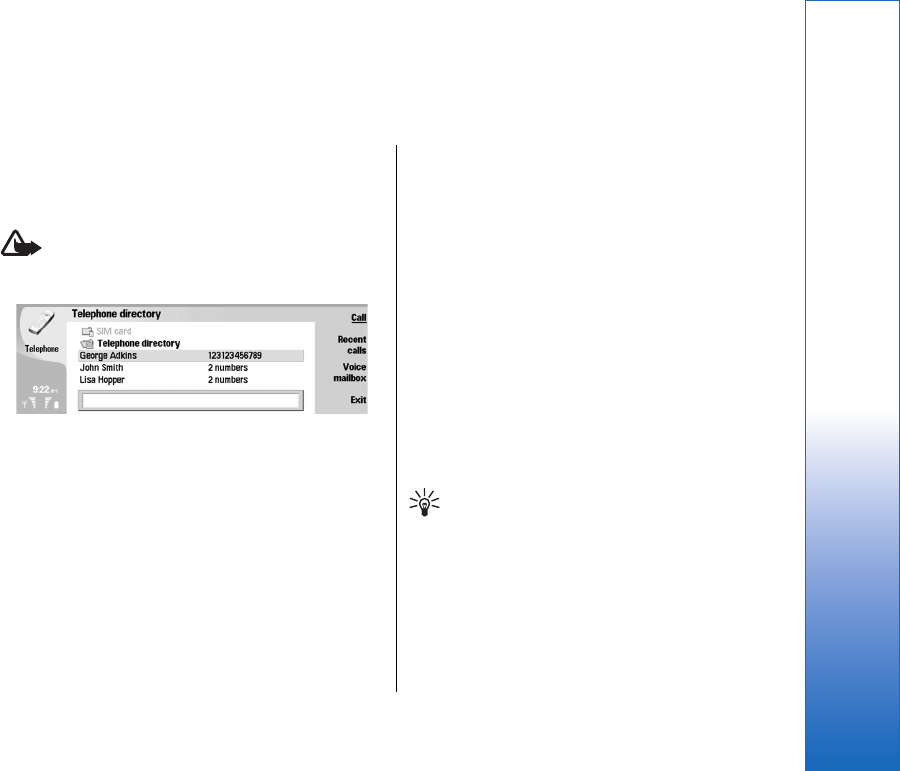
Telephone
In Telephone, you can view the contacts you have
stored in the telephone directory, SIM card, or memory
card. You can also make phone calls, view recent calls,
contact voice mailboxes, and define call settings.
Warning: Do not hold the device near your ear
when the loudspeaker is in use, because the volume
may be extremely loud.
Making a call
To make and receive calls, the cover phone must be
switched on, the device must have a valid SIM card
installed, and you must be located in a service area of
the cellular network.
To make a call, go to Telephone, type the phone
number, or select the contact from the list, and press Call.
To adjust the volume of the active call, press Audio
controls. Press Volume + to increase the volume or
Volume - to decrease it. Press Done when the volume
is set.
To view calls you have recently made, answered, or
missed, press Recent calls, and select Dialled calls,
Received calls, or Missed calls. To move from one
dialog page to another, press Menu. To call a number,
scroll to the number, and press Call.
To check your voice mail (network service), press Voice
mailbox.
Note that a GPRS connection is put on hold during voice
calls.
Answering a call
You can see the name and telephone number of the
incoming call (if allowed by the caller), or just the
number if the number is not included in your Contacts
directory.
To answer the call, press Answer.
Tip: If you want to have a private telephone
conversation, use the hands-free set or close
the device cover.
To switch between an active call and a call on hold
(network service), select the call that is on hold with
the arrow keys, and press Activate.
To mute the ringing tone , press Silence.
To reject the call, press Reject.
29
Telephone
file:///C:/USERS/MODEServer/rapi/7167389/rae-6_mini/en/issue_1/rae-6_mini_en_1.xml Page 29 Nov 22, 2004 2:59:20 PM

Speed dialing
Speed dialing allows you to make a call by pressing a
number key and the Call key when the device cover is
closed.
Press Menu, and select Settings → Speed dials….
To assign a number key to a phone number, scroll to a
speed dialing key, and press Add number. Select the
desired number from the Contacts directory.
To delete the phone number assigned to a number key,
scroll to the speed dialing key, and press Remove
number.
To modify a phone number assigned to a number key,
scroll to the speed dialing key, and press Change
number. Select the desired number from the Contacts
directory.
Making a conference call
In a conference call, you and up to five persons can hear
each other simultaneously.
To make a conference call (network service), make a
call, or answer an incoming call. During the call, make
another call, or answer another incoming call, and
press Conference call.
To view a list of conference call participants, press
Conference commands.
To mute a conference call, press Mute.
To remove a participant from the conference call, scroll
to the participant in the list, and press Drop.
To have a private phone call with a participant, scroll to
the participant in the list, and press Private call.
Viewing dialed, received,
and missed calls
You can view calls that you have recently dialed,
received, or missed.
The phone saves missed and received calls only if the
network supports these functions and if the phone is
switched on and within the network service area.
Press Recent calls, and select Dialled calls, Received
calls, or Missed calls.
To move from one dialog page to another, press Menu.
You can also view call information in the Log. See Log
on page 33.
To call a number, select a call in the list, and press Call.
To remove all calls from the list, press Clear all.
To save the phone number of the call in your Contacts
directory, select the number in the list, and press Add
to Contacts.
Setting the offline profile
The offline profile prevents you from accidentally
switching on your phone, making Internet connections,
or using Bluetooth.
30
Telephone
file:///C:/USERS/MODEServer/rapi/7167389/rae-6_mini/en/issue_1/rae-6_mini_en_1.xml Page 30 Nov 22, 2004 2:59:20 PMfile:///C:/USERS/MODEServer/rapi/7167389/rae-6_mini/en/issue_1/rae-6_mini_en_1.xml Page 30 Nov 22, 2004 2:59:20 PM

Important: In offline profile you cannot make
(or receive) any calls, or use other features that require
GSM network coverage. To make any calls, you must
first activate the phone function by changing the
profile. You may, however, be able to make an
emergency call in offline profile by pressing the power
key on the cover of the device and then entering the
official emergency number. This can be done using the
cover phone interface only, not the communicator
interface. If the device has been locked, enter the lock
code to activate the phone function. When the device is
locked, calls may still be possible to the official
emergency number.
Making an emergency call in offline profile or when the
device is locked requires that the device recognizes the
number to be an official emergency number. It may be
advisable to change the profile or unlock the device by
entering the lock code before you make the emergency
call.
To activate the offline profile, go to Telephone, press
Menu, and select → Offline.
To allow full communication again, press Menu, and
select → Exit Offline profile → OK. Then switch
on the cover phone.
Tip: You can activate the offline profile in any
application menu, or from the cover phone.
Diverting calls
You can divert incoming calls to your voice mailbox or
to another phone number.
To divert voice calls, go to Telephone. press Menu, and
select Settings → Voice call diverting.
Select one of the available diverting options.
To check your current diverts, scroll to the diverting
option, and press Check status.
To stop diverting voice calls, press Cancel all.
Call barring
You can restrict incoming or outgoing calls, and
international calls (network service).
Call barring and call diverting cannot be active at the
same time.
When calls are barred, calls still may be possible to
certain official emergency numbers.
To bar voice calls, go to Telephone, and select
Settings → Voice call barring.
Select one of the available barring options.
To use the call barring service, you need the barring
password that you receive from your service provider
when you subscribe to the service.
To check the status of voice call barring, scroll to the
barring option, and press Check status.
To stop voice call barring, press Cancel all.
31
Telephone
file:///C:/USERS/MODEServer/rapi/7167389/rae-6_mini/en/issue_1/rae-6_mini_en_1.xml Page 31 Nov 22, 2004 2:59:20 PMfile:///C:/USERS/MODEServer/rapi/7167389/rae-6_mini/en/issue_1/rae-6_mini_en_1.xml Page 31 Nov 22, 2004 2:59:20 PM
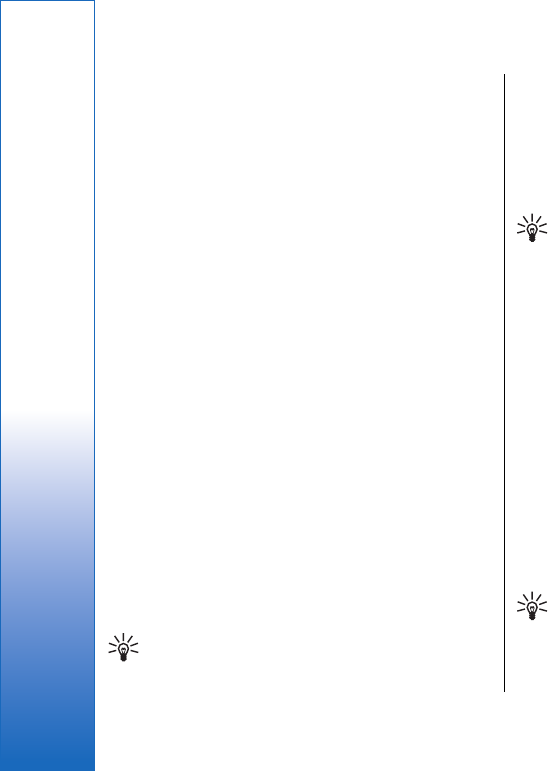
Call, network, and phone
line settings
In the Other settings dialog you can define various
settings related to calls and network services.
Go to Telephone, press Menu, and select Settings →
Other settings.
Call settings
In the Other settings dialog, select Call.
To show your phone number to the recipients of your
calls (network service), scroll to Send my caller ID,
press Change, and select On.
To set the phone to briefly show the approximate
duration of the last call, scroll to Summary after call,
press Change and select On.
To set the device to redial the number if it was busy at
the first call attempt, scroll to Automatic redial, press
Change, and select On.
Network settings
In the Other settings dialog, select Network.
To select a cellular network manually, scroll to
Network selection, press Change, and select Manual.
Select one of the networks available in your location.
Tip: Manual selection is useful when you know
that one network costs less than another, or
that it has more bandwidth.
To set the device to select the network automatically,
scroll to Network selection, press Change, and select
Automatic.
To use the call waiting service (network service), scroll
to Call waiting, press Change, and select On. When
you receive a new call during a call, a sound and a note
notify you of the new call.
Tip: Press Check status to find out if call
waiting is in use.
Advanced settings
You can restrict calls to certain numbers and select the
phone line you want to use.
When fixed dialling is activated, calls still may be
possible to the official emergency number programmed
into your device.
In the Other settings dialog, select Advanced.
To allow calls only to certain numbers (fixed dialing),
scroll to Fixed dialling number, press Change, and
select On. Even when fixed dialing is in use, you can
browse the numbers saved in the device memory. If
your SIM card does not support fixed dialing, you
cannot use this function.
To modify the list of fixed dialing numbers, scroll to
Fixed dialling number, and press Number list.
Tip: With fixed dialing, you can, for example,
restrict calls to certain areas. In this case, type
the area code in the Number field.
To change the phone line for outgoing calls (network
service), scroll to Telephone line in use, press Change,
32
Telephone
file:///C:/USERS/MODEServer/rapi/7167389/rae-6_mini/en/issue_1/rae-6_mini_en_1.xml Page 32 Nov 22, 2004 2:59:20 PMfile:///C:/USERS/MODEServer/rapi/7167389/rae-6_mini/en/issue_1/rae-6_mini_en_1.xml Page 32 Nov 22, 2004 2:59:20 PM

and select the phone line. To be able to use this
function, you need a SIM card that supports the
alternate line service and a subscription to two phone
lines.
To prevent the phone line selection, scroll to Block line
selection, press Change, and select Yes.
Voice mailbox settings
You can define the phone number of a voice mailbox
and a DTMF tone sequence that you want to use with
the mailbox (network service).
Press Menu, and select Settings → Voice mailboxes….
To define a phone number of the voice mailbox , scroll
to Number, and type the phone number. You can
obtain the number of the voice mailbox service from
your service provider.
Tip: If you want to use your voice mailbox
abroad, add the plus sign and the country or
region code to the phone number.
To define a DTMF tone sequence for the voice mailbox,
scroll to DTMF, and type the tone sequence.
Log
In the Log, you can view information, such as sent and
received text messages and made and received calls,
about the communication history of a device.
To access the Log, press Menu, and select Tools → Log.
Shortcut: You can press Shift+Ctrl+L to open
the Log in most applications.
To use the From/To information, press Use. You can
answer text messages, faxes, or calls or add the caller
or sender of a message to your contacts by pressing the
appropriate button.
To select the type of communication that you want to
view , for example, only phone calls, press Filter by type.
To view Log events by direction, select View → Filter
by direction…. You can, for example, view all
communication, or view only incoming communication,
outgoing communication, or missed communication.
To sort the Log information in a different order, press
Menu, and select one of the two options in View →
Sorting order
To view detailed information about a communication
event, press Details. For example, you can see the type,
direction, and subject of a message, or the phone
number of the caller or sender of a message.
To clear the contents of the Log, press Menu, and select
Tools → Clear log….
To specify how long log events remain in the Log
before they are deleted, press Menu, and select Tools
→ Log duration….
To copy a number from Log, press Menu, and select
File → Copy number. You can paste the number to a
new contact card or message.
33
Telephone
file:///C:/USERS/MODEServer/rapi/7167389/rae-6_mini/en/issue_1/rae-6_mini_en_1.xml Page 33 Nov 22, 2004 2:59:20 PMfile:///C:/USERS/MODEServer/rapi/7167389/rae-6_mini/en/issue_1/rae-6_mini_en_1.xml Page 33 Nov 22, 2004 2:59:20 PM
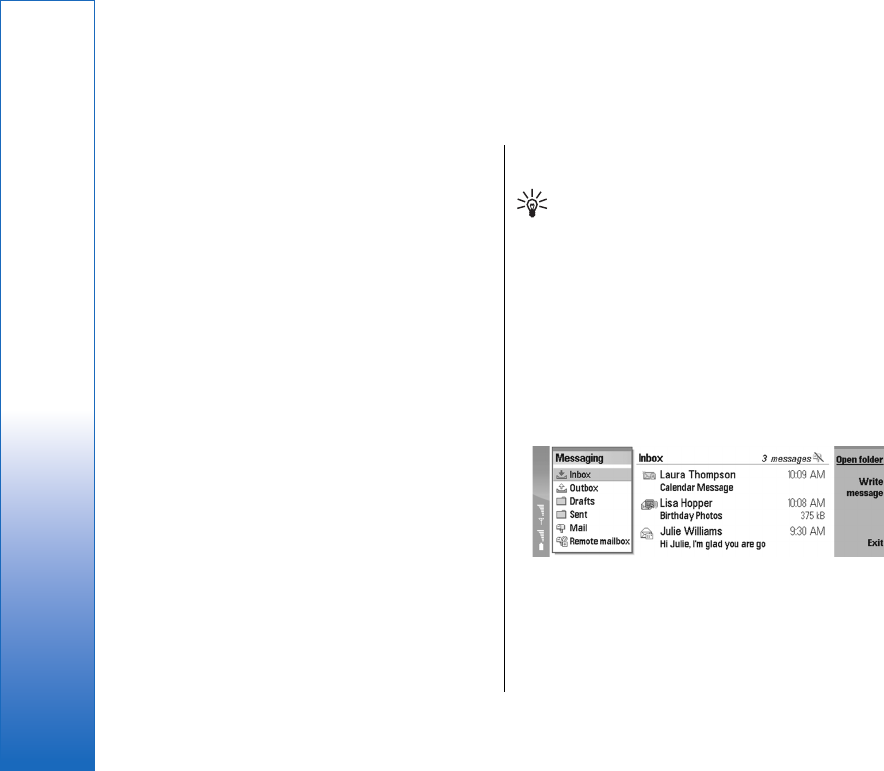
Messaging
In Messaging, you can create, send, receive, view, edit,
and organize text messages, multimedia messages, e-
mail messages, fax messages, and special text
messages containing data, such as settings or
bookmarks of Web pages. You can also receive
messages and data using Bluetooth or Infrared, receive
service messages, cell broadcast messages, and send
service commands.
Before you can send or receive messages:
• The cover phone must be switched on, the device
must have a valid SIM card installed, and you must
be located in a service area of the cellular network.
The device cover can either be open or closed.
• The network you are using must support fax calls,
data calls, and the Short Message Service if you want
to use these.
• The fax, data and Short Message Service must be
activated for your SIM card.
• The Internet access point (IAP) settings must be
defined. See Internet setup on page 84.
• The e-mail settings must be defined. See E-mail
account settings on page 39.
• The short message settings must be defined. See
Text message settings on page 42.
• The multimedia message settings must be defined.
See Multimedia message account settings on page 45.
Contact your service provider, network operator or
Internet service operator for the correct settings.
Tip: When you take your Nokia 9300 into use,
it may recognize the SIM card provider and
configure the correct text message, multimedia
message, and GPRS settings automatically. You
may need to contact your network operator to
activate multimedia messages and GPRS before
they become available.
Messaging center
The main view of Messaging has two frames: the list of
folders on the left, and the messages from the selected
folder on the right. Press the tab key to move between
the frames.
Folders in the Messaging main view:
•Inbox—contains all received messages except e-
mails and SIM card and cell broadcast messages. E-
mail messages are stored in the remote mailbox.
•Outbox—contains messages waiting to be sent.
34
Messaging
file:///C:/USERS/MODEServer/rapi/7167389/rae-6_mini/en/issue_1/rae-6_mini_en_1.xml Page 34 Nov 22, 2004 2:59:20 PM

•Drafts—stores draft messages that have not been
sent.
•Sent—stores messages that have been sent, except
those sent using Bluetooth.
Any remote mailboxes that you define are shown last in
the list of folders.
Writing and reading messages
To view a message, select the message, and press Open.
To expand a folder to full display size, press Open folder.
To write a new message, press Write message. Select
the type of message, and press OK.
To reply to the sender and all recipients of an e-mail,
press Menu, and select Write → Reply to all.
To forward a message, press Menu, and select Write
→ Forward. Note that it may not be possible to
forward all messages.
To retrieve messages from your SIM card, press Menu,
and select Receive → SIM messages. SIM messages
are text messages, that have been stored on your SIM
card.
To sort messages in a specific order, press Menu, and
select one of the options in the View → Sort by menu.
To print a message, press Menu, and select File →
Printing → Print….
To change the page layout before printing, press Menu,
and select File → Printing → Page setup….
Managing messages
To create a new folder for messages, press Menu, and
select File → New folder. Enter a Folder name, select
where the folder should be created, and press Create.
Note that you cannot create subfolders in Inbox,
Outbox, or Sent folders, except in IMAP4 remote Outbox,
and Sent folders when online. IMAP 4 is a standard
protocol for accessing e-mail on your remote server.
With IMAP4, you can conduct searches, create, delete
and manage messages and folders on the server.
To rename a folder, select the folder, press Menu, and
select File → Rename folder. Enter the new name,
and press Rename. Note that you can only rename
folders that you have created.
To move a message, select the message, press Menu,
and select Edit → Move. Scroll to a new folder, and
press Move. If you want to move the message to a
subfolder, select the main level folder, and press Expand.
To search for messages, press Menu, and select Edit →
Find…. Enter the text for which you want to search, and
press Find.
To refine your search, press Options.
Avoiding low memory
You should regularly delete messages from Inbox and
Sent folders, and delete retrieved e-mail from the
device memory to free up memory space.
To delete e-mails from the device, press Menu, and
select Tools → Delete e-mails locally…. Press
Change, and select the e-mail you want to delete. For
35
Messaging
file:///C:/USERS/MODEServer/rapi/7167389/rae-6_mini/en/issue_1/rae-6_mini_en_1.xml Page 35 Nov 22, 2004 2:59:20 PMfile:///C:/USERS/MODEServer/rapi/7167389/rae-6_mini/en/issue_1/rae-6_mini_en_1.xml Page 35 Nov 22, 2004 2:59:20 PM

example, you can delete all e-mail or only e-mail that
was received more than two weeks ago. Press Delete
now to delete the e-mails.
Tip: Use this method to delete e-mail from the
device. Otherwise the messages you delete are
permanently deleted from your remote
mailbox the next time you go online.
To delete e-mail from the device and from the remote
server, open an e-mail, and press Delete.
To empty the Sent folder automatically, press Menu,
and select Tools → Sent items storage…. Set Delete
sent items to automatically, and enter the number of
days after which the device empties the folder.
E-mail
To write and read e-mail, go to Messaging.
The Nokia 9300 mail system is compliant with Internet
standards SMTP, IMAP4 (rev 1), and POP3.
To receive and send mail, you must set up a remote
mailbox service. This service may be offered by an
Internet service provider, a network service provider, or
your company.
Before you can send, receive, retrieve, reply to, and
forward mail on your device, you must do the following:
• You must configure an Internet access point (IAP)
correctly. See Internet setup on page 84.
• You must define your mail settings correctly. See E-
mail account settings on page 39.
Follow the instructions from your remote mailbox and
Internet service providers. Contact your network and
Internet service providers or operator for the correct
settings.
Working online and offline
Working online means working with your device
connected to a remote mailbox through an Internet
connection. When online, you can delete, rename, or
create new folders in your remote mailbox. When you
work offline, which means that your device is not
connected to a remote mailbox, you can delete only
messages, not folders.
Note that any changes you make in the remote mailbox
folders while offline take effect in your remote mailbox
the next time you go online and synchronize.
If you delete an e-mail from your device when offline,
the e-mail will be deleted from the remote mailbox the
next time you connect to the mailbox. You can delete a
message from your device to save memory. See
Avoiding low memory on page 35.
Managing your e-mail offline enables you to save in
connection costs and work in conditions that do not
allow a data connection. If you work in conditions
where one connection becomes unavailable, you can
change the connection.
Changing the Internet connection
If your connection becomes unavailable, you may need
to change the connection.
To use another connection, press Menu, and select
Tools → Change connection. Scroll to a new
connection, and press Connect. Note that you must
36
Messaging
file:///C:/USERS/MODEServer/rapi/7167389/rae-6_mini/en/issue_1/rae-6_mini_en_1.xml Page 36 Nov 22, 2004 2:59:20 PMfile:///C:/USERS/MODEServer/rapi/7167389/rae-6_mini/en/issue_1/rae-6_mini_en_1.xml Page 36 Nov 22, 2004 2:59:20 PM

select an e-mail account and be online before you can
change the connection, and that the connection is
changed only for that account.
You are asked for confirmation if your current
connection becomes unavailable, if you have not set
the device to change connection automatically. See E-
mail account settings on page 39.
To use another connection, scroll to the connection you
want to use, and press Change.
To go online after selecting a new connection, press
Connect.
Writing and sending e-mail
Press Write message, select E-mail, and press OK.
To write new e-mail, press Recipient. Select the
recipient of the message from the Contacts directory,
and press To. Enter a subject and the message, and
press Send. You can also enter the recipient's e-mail
address in the To: field. Note that e-mail addresses
cannot contain accented characters such as Å, Ä, or É.
Tip: If you select the primary recipient of the e-
mail from the Contacts directory, you can also
select other recipients using the Cc (the
recipient is shown to all other recipients) and
Bcc (the recipient is hidden from all other
recipients) buttons.
To set the sending time or adjust other delivery
settings, press Menu, and select Tools → Sending
options….
You can send documents, images, and other files as e-
mail attachments.
To attach a file to an e-mail, press Insert file.
Tip: All e-mail is stored in the Outbox before
sending. Unless your e-mail is sent
immediately, you can open the Outbox and
suspend and resume sending or open the e-
mail.
To store the e-mail in the Drafts folder without sending
it, press Close.
Start writing or editing a message, press Menu, and
select Tools → Preferences….
To change the font type or size of the text, select the
appropriate field, and press Change. Select the new
font type or font size, and press OK.
Sending options
To define sending options for the e-mail you are
writing, press Menu, and select Tools → Sending
options….
Select the Message page.
To set the importance of your e-mail, select Priority,
and press Change.
To define the e-mail type , select Message type, and
press Change.
Select from these options:
•Plain text (no MIME)—Select when the receiving e-
mail system cannot display messages sent in the
regular Internet e-mail format, MIME.
37
Messaging
file:///C:/USERS/MODEServer/rapi/7167389/rae-6_mini/en/issue_1/rae-6_mini_en_1.xml Page 37 Nov 22, 2004 2:59:20 PMfile:///C:/USERS/MODEServer/rapi/7167389/rae-6_mini/en/issue_1/rae-6_mini_en_1.xml Page 37 Nov 22, 2004 2:59:20 PM

•Plain text—Select to use the regular Internet e-
mail format, MIME. The MIME format allows, for
example, including images as attachments to the
message.
•Formatted text (HTML)—Select to use enhanced
text formatting options, such as bold, italic,
underline, or bullets. If the receiving e-mail system
does not support HTML, the message is shown as
plain text without the formatting.
To receive a note when the recipient has opened the e-
mail, select Request read report, press Change, and
select Yes. Note that some e-mail servers may not
support read reports, or the user may have turned the
read receipt sending off.
Select the Delivery page.
To change the e-mail account you use to send the e-
mail, select E-mail account in use, and press Change.
Select the new account, and press OK.
To set the time you want to send the e-mail, select
Send e-mail, and press Change.
Select from these options:
•Immediately—to send the e-mail immediately
during the current connection
•Upon request—to store the e-mail in the Outbox,
from which you can send it later
•During next connection—to send the e-mail the
next time you establish a connection.
Retrieving e-mail
E-mail addressed to you is not automatically received
by your device, but by your remote mailbox. To read
your e-mail, you must first connect to the remote
mailbox and then select the e-mails you wish to
retrieve into your device. Connection to a remote
mailbox is established using data call, GPRS, or IP
passthrough. See Connectivity on page 101.
Note that e-mail that you mark as deleted when offline
will also be deleted from the remote mailbox server
when the device is online again. You can delete local e-
mail without deleting remote mailbox files. See
Avoiding low memory on page 35.
To retrieve e-mail from a remote server, scroll to your
mailbox, and press Retrieve e-mail.
Select:
•Mail headers (stay online)—to retrieve only the
sender, date and subject information.
•Messages—to retrieve entire e-mails without the
attachments.
•Messages and attachments—to retrieve all e-
mails and the attachments they contain.
•Ask before retrieving—to confirm whether the
device should retrieve mails.
Press Retrieve to go online and retrieve the mails.
If you have created subfolders in your IMAP4 mailboxes,
you can view those folders with your device. To be able
to view folders in your IMAP4 mailbox, establish an
Internet connection, press Menu, and select Receive →
Folder subscriptions…. Note that you can only
subscribe to folders in your IMAP4 mailboxes.
To view a remote folder, select a folder, and press
Subscribe. Every time you go online the subscribed
38
Messaging
file:///C:/USERS/MODEServer/rapi/7167389/rae-6_mini/en/issue_1/rae-6_mini_en_1.xml Page 38 Nov 22, 2004 2:59:20 PMfile:///C:/USERS/MODEServer/rapi/7167389/rae-6_mini/en/issue_1/rae-6_mini_en_1.xml Page 38 Nov 22, 2004 2:59:20 PM

folders are updated. Note that this may take a lot of
time if the folders are large.
To update the list of folders, press Update list.
Reading and replying to e-mail
To reply to an e-mail, press Reply.
Tip: If an e-mail contains Web addresses, e-
mail addresses, or phone or GSM numbers, you
can use them. For example, you can select a
Web address or a phone number, and press the
appropriate command button to open the Web
page, send e-mail or call the number.
To add new contacts to your Contacts directory, select
the sender or a recipient from the header fields, press
Menu, and select Tools → Add to Contacts….
Tip: If you reply to an e-mail that contains
attached files, the attachments are not
included in the reply. If you forward the
received e-mail, attachments are included.
To forward an e-mail, press Menu, and select File →
Forward.
To print an e-mail, press Menu, and select File →
Printing → Print….
E-mail attachments
Important: E-mail messages may contain
viruses or otherwise be harmful to your device or PC. Do
not open any attachment if you are not sure of the
trustworthiness of the sender
To open an attachment, select the attachment, and
press Open.
To save an attachment, select the attachment, and
press Save.
To delete an attachment, select the attachment, and
press Delete locally. Note that a copy of the
attachment remains on the e-mail server.
Changing e-mail replying and
viewing preferences
Open a received e-mail, and press Preferences….
To include the text of the received e-mail in your
replies, select Include message in reply, press
Change, and select Yes.
To define the font type or size of text, select the
appropriate field, and press Change. Choose the new
font type or size, and press OK.
E-mail account settings
Any changes you make to e-mail settings affect the way
your e-mail is sent and received.
Press Menu, select Tools → Account settings…, and
press Create new.
Scroll to the type of account that you want to create,
and press OK.
39
Messaging
file:///C:/USERS/MODEServer/rapi/7167389/rae-6_mini/en/issue_1/rae-6_mini_en_1.xml Page 39 Nov 22, 2004 2:59:20 PMfile:///C:/USERS/MODEServer/rapi/7167389/rae-6_mini/en/issue_1/rae-6_mini_en_1.xml Page 39 Nov 22, 2004 2:59:20 PM
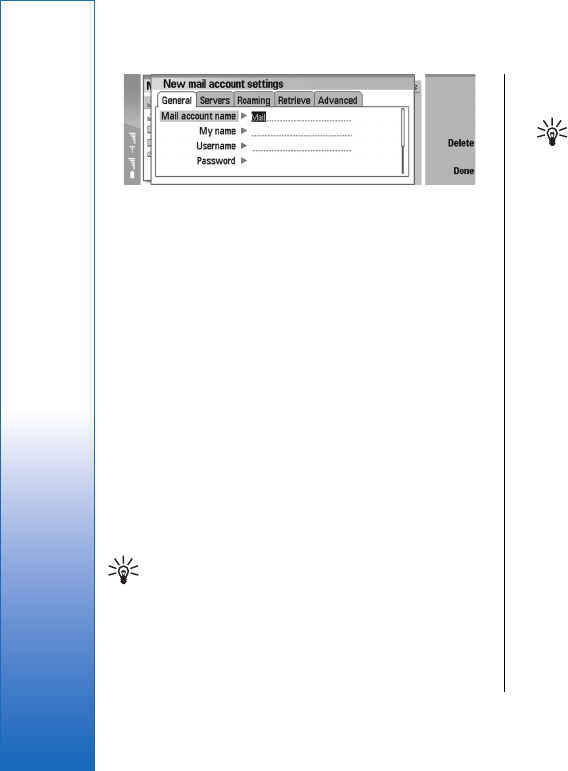
Define the following on the General page:
•E-mail account name—Enter a descriptive name
for the connection. Note that the maximum length
of the name is 25 characters.
•My name—Enter your name.
•Username—Enter your user name, given to you by
your service provider.
•Password—Enter your password. If you leave this
field blank, you will be prompted for a password
when you try to connect to your mailbox.
•My e-mail address—Enter the e-mail address
given to you by your service provider. The address
must contain the @ character. Replies to your
messages are sent to this address.
•Internet access—Select the Internet access point
that you want to use.
•Default account—If you have created several e-
mail accounts, select the e-mail account you want to
use as the default account.
Tip: You can move from one dialog page to
another by pressing the Menu key.
Define the following on the Servers page:
•E-mail account type—Select the e-mail protocol
your remote mailbox service provider recommends.
Note that this setting can be selected only once and
cannot be changed if you have saved or exited from
the mailbox settings.
Tip: POP3 is a version of Post Office Protocol,
a standard protocol for receiving e-mail
from your remote server. With POP3, you
can check your remote mailbox and
download your e-mail. IMAP4 is a version of
Internet Message Access Protocol, a standard
protocol for accessing e-mail on your
remote server. With IMAP4, you can conduct
searches, create, delete and manage
messages and folders on the server.
•Outgoing e-mail server—Enter the IP address or
host name of the computer that sends your e-mail.
•Incoming e-mail server—Enter the IP address or
host name of the computer that receives your e-mail.
•Use SMTP authentication—Select whether the
SMTP (Simple Mail Transfer Protocol) server requires
authentication, and enter the SMTP user name and
password.
Define the following on the Roaming page:
•Change connection automatically—Select
whether you want the device to switch between
connections automatically if connection to the
primary Internet access point is lost.
•Second access, Third access, and Fourth
access—Define the other possible Internet access
options.
Define the following on the Retrieve page:
•Retrieve—Select whether you want to retrieve
only the e-mail header information such as sender,
40
Messaging
file:///C:/USERS/MODEServer/rapi/7167389/rae-6_mini/en/issue_1/rae-6_mini_en_1.xml Page 40 Nov 22, 2004 2:59:20 PMfile:///C:/USERS/MODEServer/rapi/7167389/rae-6_mini/en/issue_1/rae-6_mini_en_1.xml Page 40 Nov 22, 2004 2:59:20 PM

subject and date, e-mails, or e-mails with their
attachments.
•Max. size of e-mail—Define how large e-mails are
retrieved to your device.
•Sync. e-mails in Inbox—Select the number of e-
mails you want to download from the remote server
to your Inbox.
•Sync. e-mails in folders—Select the number of e-
mails you want to download from the remote server
to your folders.
Define the following on the Advanced page:
•Default e-mail type—Select whether to sent e-
mail as Plain text, Plain text (no MIME) if the
receiving e-mail system cannot display e-mail sent in
the regular Internet format, or Formatted text
(HTML) to be able to use enhanced text formatting
options.
•Send e-mail—Select Immediately to send the e-
mail as soon as possible, During next connection
to send it the next time you retrieve e-mail, or Upon
request to store the e-mail in the Outbox, from
where you can send it later.
•Include signature—Select whether you want to
use a signature. Select Use my contact card to use
the contact card in the device, or Custom to use a
signature file that you can create for the e-mail
account.
•Request read report—Select whether you want to
receive a note when the recipient has opened your e-
mail.
•Allow report requests—Select whether you want
the sender of the e-mail to receive a note that you
have read the e-mail.
•Copy to my e-mail address—Select whether you
want to receive a copy of every e-mail you send.
•Secure login (APOP)—Select whether you want to
use a POP3 secure login system, and the POP3 server
you use supports this system.
•Incoming secure connection—Select whether
you want to use encryption to make the incoming
connection secure. Secure connection is used with
POP3 and IMAP4 protocols to secure the connection
to a remote mailbox. Note that the remote server
must support secure connections for this function to
work.
•Outgoing secure connection—Select whether
you want to use encryption to make the outgoing
connection secure. Secure connection is used with
the SMTP protocol to secure the connection to a
remote mailbox. Note that the remote server must
support secure connections for this function to work.
•IMAP4 folder path—Enter the path to the IMAP4
inbox location in case the server cannot open it
automatically. Normally you do not need to define
the path.
To edit an existing account, select the account type that
you want to edit, and press Edit.
Text messages
Your device supports the sending of text messages
beyond the normal 160-character limit. If your message
exceeds 160 characters, it will be sent as a series of two
or more messages.
In the navigation bar, you can see the message length
indicator counting backwards from 160. For example,
41
Messaging
file:///C:/USERS/MODEServer/rapi/7167389/rae-6_mini/en/issue_1/rae-6_mini_en_1.xml Page 41 Nov 22, 2004 2:59:20 PMfile:///C:/USERS/MODEServer/rapi/7167389/rae-6_mini/en/issue_1/rae-6_mini_en_1.xml Page 41 Nov 22, 2004 2:59:20 PM

10 (2) means that you can still add 10 characters for the
text to be sent as two messages.
Note that using special (Unicode) characters such as ë,
â, á, ì take up more space.
If there are special characters in your message, the
indicator may not show the message length correctly. If
Confirm multipart messages is set to Yes, then
before the message is sent, the device tells you if the
message exceeds the maximum length allowed for one
message. See Text message settings on page 42.
Press Write message, select Text message, and press
OK.
To write a new text message, press Recipient to select
the recipients of the message, or enter the recipients'
GSM phone numbers in the To: field. If you enter more
than one number, separate the numbers with a
semicolon or by pressing the Enter key after each
number. Write the message, and press Send. You can
see the number of characters that are left in the
character counter. Note that a text message can only
contain unformatted text.
To set the sending time or modify other delivery
settings, press Sending options.
To print the text message, press Menu, and select File
→ Printing → Print….
Replying to text messages
To respond to received text messages, open the
message, and press Reply.
To call the sender of the text message, press Call sender.
Tip: If the text message that you received
contains a hyperlink, select the hyperlink, and
press Open Web address to open the browser.
If the text message that you received contains
a number, place the cursor on the number, and
press Call number to call the number.
Text message settings
To define general sending options for text messages,
press Menu, and select Tools → Account settings….
Select Text message, and press Edit. To move from
one dialog page to another, press the Menu key.
On the General page, define the following:
•Service centre in use—Select the message center
to deliver the messages.
•Delivery report—Select whether to view the
status of the sent text messages in Log.
•Send text message—Select when to send the text
messages. If you select Upon request, you must
select a message in Outbox and press Send to send it.
•Validity period—Select how long the message
center stores messages if a recipient cannot be
reached. Note that the network must support this
feature.
On the Concatenation page, define the following:
•Concatenation—Select No to send text messages
longer than 160 characters as several messages.
Select Yes to send text messages that are longer
than 160 characters as several messages, and allow
them to be received as one long message by
42
Messaging
file:///C:/USERS/MODEServer/rapi/7167389/rae-6_mini/en/issue_1/rae-6_mini_en_1.xml Page 42 Nov 22, 2004 2:59:20 PMfile:///C:/USERS/MODEServer/rapi/7167389/rae-6_mini/en/issue_1/rae-6_mini_en_1.xml Page 42 Nov 22, 2004 2:59:20 PM
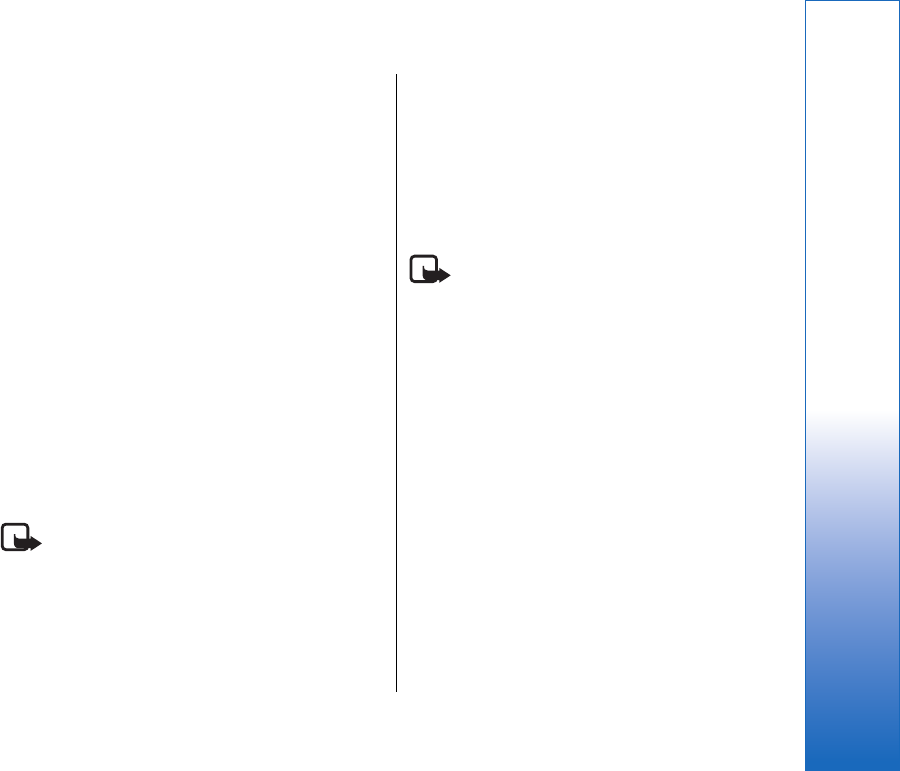
compatible devices. Sending a message over 160
characters may be more expensive than one message.
•Confirm multipart messages—Select whether
you want to see a confirmation note when you try to
send text messages exceeding 160 characters.
See the User Guide on the CD-ROM for advanced settings.
Modifying message center
settings
To view message centers, press Menu, and select Tools
→ Account settings…. Select Text message, and
press Edit. In General, press Service centres.
To edit message centers, press Edit, and enter the
Service centre name and Service centre number.
To add new message centers, press New, and enter the
Service centre name and Service centre number.
To delete message centers, scroll to a center, and press
Delete.
Picture messages
Note: Picture message function can be used only
if it is supported by your network operator or service
provider. Only devices that offer picture message
features can receive and display picture messages.
To view a picture message, select the message in
Messaging, and press Open.
To reply to the sender, press Reply via text msg.. Note
that the picture is not included in the reply.
To forward a picture message, press Forward. Press
Recipient to select a recipient, write the message text,
and press Send. Note that the picture message text
cannot be longer than 120 characters.
Multimedia messages
Note: Only devices that offer compatible
multimedia message or e-mail features can receive and
display multimedia messages.
The appearance of a multimedia message may vary
depending on the receiving device.
The default setting of the multimedia message service
is generally on.
Creating and sending
multimedia messages
A multimedia message can contain text, images, or
sound or video clips.
Note that this function can be used only if it is
supported by your network operator or service provider.
Copyright protections may prevent some images,
ringing tones, and other content from being copied,
modified, transferred or forwarded.
Before you can send and receive multimedia messages
on your device, you must have your multimedia
message settings defined correctly. Contact your service
43
Messaging
file:///C:/USERS/MODEServer/rapi/7167389/rae-6_mini/en/issue_1/rae-6_mini_en_1.xml Page 43 Nov 22, 2004 2:59:20 PMfile:///C:/USERS/MODEServer/rapi/7167389/rae-6_mini/en/issue_1/rae-6_mini_en_1.xml Page 43 Nov 22, 2004 2:59:20 PM
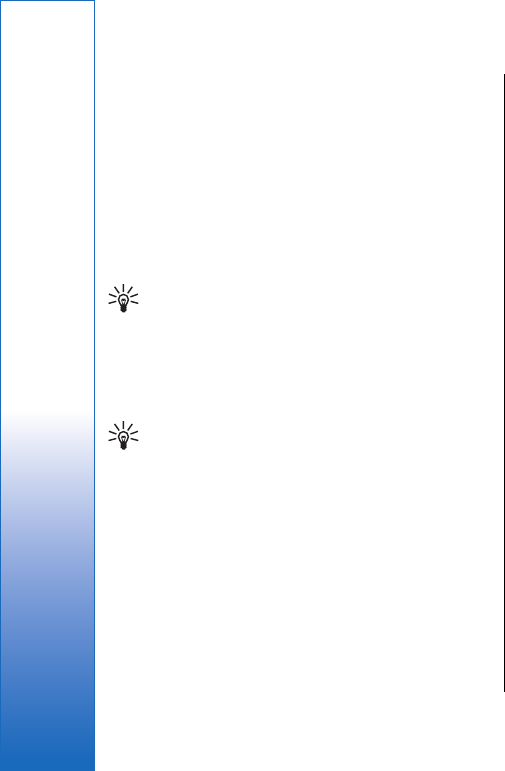
provider for the correct settings. See Multimedia
message account settings on page 45.
To create a multimedia message, press Write
message, scroll to Multimedia message, and press
OK. Press Recipient to select the recipients of the
message, or enter the recipients' GSM phone numbers
or e-mail addresses in the To: field. If you enter more
than one number, separate the numbers with a
semicolon or by pressing the Enter key after each
number. Enter a subject, and create the message. After
the message is ready, press Send.
Tip: You can also create multimedia messages
directly from several applications, such as
Images and File manager.
To add multimedia objects to a message, press Insert.
You can insert images, sound clips, and video clips, and
create page breaks in your message. Select the type of
multimedia object you want to add, and press Insert.
Tip: A multimedia message may contain
several pages. If the cursor is in the To:, Cc:, or
Subject: field when you add a page, the new
page becomes the first page of the message.
Otherwise, the new page is added after the
page where the cursor is. Each page can
contain only one video or one sound clip.
To add special effects to images in multimedia
messages, press Menu, and select Options →
Transition settings…. You can specify the length of
time an image is displayed and the style in which a
new object is opened. You have to be in advanced
editing mode.
To preview a multimedia message before sending it,
press Menu, and select View → Preview.
To delete a multimedia object, select the object you
want to delete, press Menu, and select Edit → Delete
and the appropriate menu option.
To delete a page, scroll to the page, press Menu, and
select Edit → Delete → Page.
You must be in the advanced editing mode to use most
editing functions. Press Menu, and select Options →
Upgrade editing mode.
To change the position of text in relation to images,
press Menu, and select Tools → Slide layout. Select
Text right or Text left.
To edit the type, color, and formatting of text, select the
text, press Menu, and select Options → Text format….
You can also select the formatting before you start
writing.
To change the background color of a multimedia
message, press Menu, and select Options →
Background colour…. Press Change, scroll to a new
color, and press OK. Press Done.
To change the sending options of a multimedia
message, start to create or edit a message, press Menu,
and select Options → Sending options…. You can
select whether to receive delivery reports and how long
the messaging center tries to send messages.
Set the following options:
•Receive report—Select whether you want to
receive a notification when the message has been
successfully delivered to the recipient. Receiving a
44
Messaging
file:///C:/USERS/MODEServer/rapi/7167389/rae-6_mini/en/issue_1/rae-6_mini_en_1.xml Page 44 Nov 22, 2004 2:59:20 PMfile:///C:/USERS/MODEServer/rapi/7167389/rae-6_mini/en/issue_1/rae-6_mini_en_1.xml Page 44 Nov 22, 2004 2:59:20 PM

delivery report of a multimedia message that has
been sent to an e-mail address may not be possible.
•Validity period—Select how long the messaging
center tries to send the message. If the recipient of a
message cannot be reached within the validity
period, the message is removed from the
multimedia messaging center. Note that the
network must support this feature. Maximum is the
maximum amount of time allowed by the network.
Receiving multimedia
messages
Important: Multimedia message objects may
contain viruses or otherwise be harmful to your device
or PC. Do not open any attachment if you are not sure
of the trustworthiness of the sender.
Multimedia messages are received in your Inbox, and
you can open or reply to them as to other messages.
You can receive multimedia messages containing
objects unsupported by your device, but you cannot
view them. You can, however, try to forward these
messages to another device that supports such objects.
To view a list of multimedia attachments in a message,
press Menu, and select Tools → Objects….
To save a multimedia object, select the object, and
press Copy to.
To play a multimedia object, select the object, and
press Open.
Multimedia message account
settings
On the Send page, define the following settings:
•Internet access—Select the Internet access point
(IAP) connection you want to use for sending
messages.
•Homepage—Enter the address of the multimedia
messaging center.
•Receive report—Select whether you want to
receive a notification when the message has been
successfully delivered to the recipient. Receiving a
delivery report of a multimedia message that has
been sent to an e-mail address may not be possible.
•Sending time—Select when you want the
multimedia message to be sent.
•Validity period—Select how long the messaging
center tries to send the message. If the recipient of a
message cannot be reached within the validity
period, the message is removed from the
multimedia messaging center. Maximum is the
maximum amount of time allowed by the network.
Note that the network must support this feature.
On the Receive page, define the following settings:
•Multimedia reception—Select whether you want
to receive multimedia messages always, only in your
home network, or do not want to receive them at all.
•On receiving messages—Select On if you want to
receive multimedia messages. The reception of
multimedia messages is on by default. Select
Deferred if you want the multimedia messaging
center to save the messages to be retrieved later.
45
Messaging
file:///C:/USERS/MODEServer/rapi/7167389/rae-6_mini/en/issue_1/rae-6_mini_en_1.xml Page 45 Nov 22, 2004 2:59:20 PMfile:///C:/USERS/MODEServer/rapi/7167389/rae-6_mini/en/issue_1/rae-6_mini_en_1.xml Page 45 Nov 22, 2004 2:59:20 PM

Change this setting to On when you want to retrieve
the messages. Select Reject if you want to reject
multimedia messages. The multimedia messaging
center will delete the messages.
•Receive advertisements—Select whether you
want to receive messages defined as advertisements.
•Receive anonymous messages—Select whether
you want to receive messages from unknown
senders.
On the General page, define the following settings:
•Compress images—Select whether you want to
compress images that you include in your
multimedia messages. Compression may make the
multimedia message size smaller.
Fax
To send a fax, press Write message. Scroll to Fax, and
press OK. Press Recipient, and select the recipient from
the Contacts directory. You can also enter the number
yourself. Write the message, and press Send.
To change the fax sending, press Menu, and select
Tools → Sending options….
To change the font and format of fax text, press Menu,
and select Format → Font…, Formatting, or
Alignment.
To add a document, sheet or image to a fax, press
Insert object. Note that it may not always be possible
to insert a document to a fax. If you want to send a
document as a fax, use the File → Send → Via fax
option in Documents.
To print a fax, press Menu, and select File → Printing
→ Print…. Check that the printing settings are correct,
and press Print.
To view a received fax, select the fax, and press Open.
Press the arrow keys to scroll the fax.
To rotate a fax, press Rotate.
To zoom in or out, press Zoom in or Zoom out.
Saving a received fax
In the Range selection dialog, you can select the
section of the fax you want to export to another picture
file format.
To save a multipage fax, open the fax, press Menu, and
select File → Export…. Select Whole document to
save the fax as a whole, Current page to save the page
you are on, Selected to save a section that you
selected, or User defined: to enter the page numbers
of the pages you want to save.
Editing fax settings
Press Menu, and select Tools → Account settings….
Select Fax, and press Edit.
On the General page, define the following:
•Fax cover page—Select whether to use a header
or cover page for a fax. Select Template 1 to create
a separate cover page, Full template to use a cover
page that includes all the contact information of
both the sender and the recipient, your remarks on
the fax content, and the date, Header to display the
46
Messaging
file:///C:/USERS/MODEServer/rapi/7167389/rae-6_mini/en/issue_1/rae-6_mini_en_1.xml Page 46 Nov 22, 2004 2:59:20 PMfile:///C:/USERS/MODEServer/rapi/7167389/rae-6_mini/en/issue_1/rae-6_mini_en_1.xml Page 46 Nov 22, 2004 2:59:20 PM

sender and the recipient information and the date,
or None for no cover page.
•Send fax—Select when to send the messages. If
you select Upon request, you must select a message
in Outbox, and send the fax from there.
On the Advanced page, define the following:
•Resolution—Select the resolution for your sent
and received faxes.
•ECM—Select whether erroneous fax pages are
automatically corrected during sending. Note that
also the receiving device has to support ECM.
•Resend—Select whether to resend All pages or
only the Missed pages if any fax pages failed to be
sent.
To edit settings for fax diverting or fax barring, press
Fax diverting or Fax barring.
Special message types
The device can receive different types of messages, for
example, text messages that contain data, operator
logos, ringing tones, bookmarks, or Internet access or e-
mail account settings.
The device can also receive service messages. Service
messages are notifications of, for example, news
headlines and may contain a text message or a link. For
availability and subscription, contact your service
provider.
Receiving provisioning settings
To view a message that contains connectivity settings,
select the message, and press Open. If the device asks
for a password, enter your password, and press OK.
Note that after three incorrect passwords, the message
is deleted.
To accept the settings and configure your device, press
Save. If you receive trusted server settings (basic
connectivity settings and the location of the server)
from your service provider, the settings are saved
automatically, and an information message is placed to
your Inbox..
Cell broadcast
In areas where the cell broadcast service is available
(network service), you can receive messages on various
topics from your service provider, such as weather or
traffic conditions. For available topics and relevant
topic numbers, contact your service provider. Note that
a packet data (GPRS) connection may prevent cell
broadcast reception. Contact your network operator for
the correct GPRS settings.
Go to Desk → Tools → Cell broadcast.
To open a cell broadcast message, select a topic, and
press Read.
Tip: To search for topics, enter a name or a
number of a topic in the search field.
To receive a specific topic, select the topic, and press
Subscribe. To stop receiving topics, select the topic,
and press Unsubscribe.
47
Messaging
file:///C:/USERS/MODEServer/rapi/7167389/rae-6_mini/en/issue_1/rae-6_mini_en_1.xml Page 47 Nov 22, 2004 2:59:20 PMfile:///C:/USERS/MODEServer/rapi/7167389/rae-6_mini/en/issue_1/rae-6_mini_en_1.xml Page 47 Nov 22, 2004 2:59:20 PM

To stop receiving cell broadcast messages, press
Reception off. To start receiving cell broadcast
messages again, press Reception on.
To add, edit, or remove topics, press Menu, and select
one of the Topic → More options menu options.
To create a blank topic list, press Menu, select List →
Edit lists, and press New. Enter a name for the topic
list, and press OK.
To create a topic list from selected topics, press Menu,
select Topic → Add selected topics to list, and press
New. Enter a name for the topic list, and press OK.
To define the automatic detection of new topics, press
Menu, and select Tools → Settings → Add new
topics automatically to list.
To define the language of the received messages, press
Menu, and select Tools → Settings. Scroll to
Language, and select a language.
48
Messaging
file:///C:/USERS/MODEServer/rapi/7167389/rae-6_mini/en/issue_1/rae-6_mini_en_1.xml Page 48 Nov 22, 2004 2:59:20 PMfile:///C:/USERS/MODEServer/rapi/7167389/rae-6_mini/en/issue_1/rae-6_mini_en_1.xml Page 48 Nov 22, 2004 2:59:20 PM
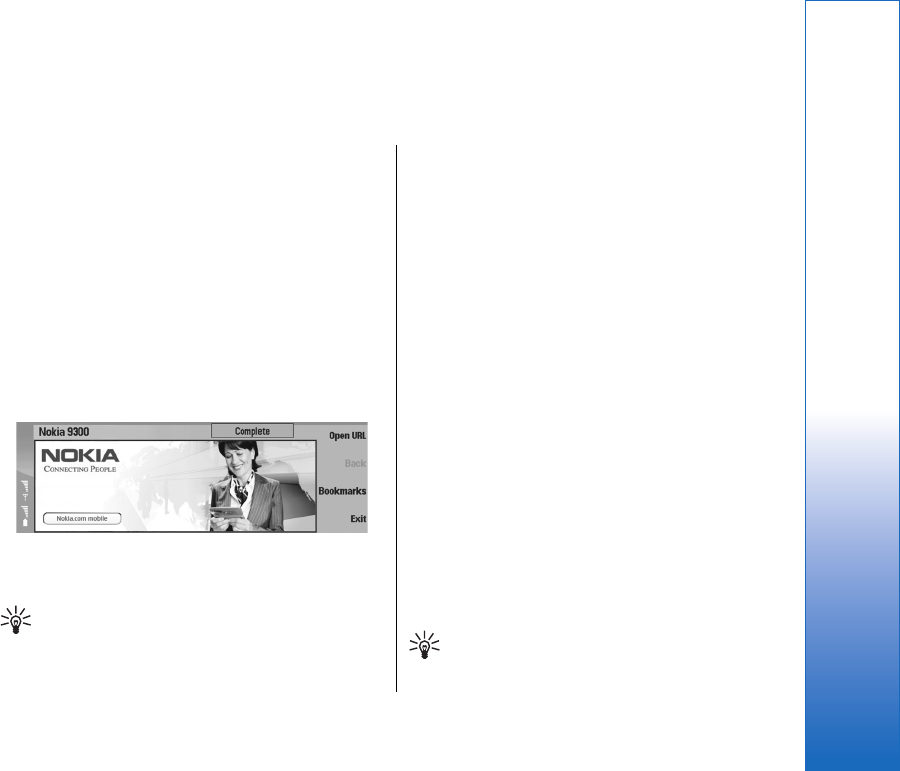
Web
To connect to the World Wide Web:
• You must configure the Internet access point and
Internet connection settings. See Internet setup on
page 84.
• If you are using a data call or a GPRS connection,
your wireless network must support data calls or
GPRS, and the data service must be activated for
your SIM card.
Contact your service provider for the correct settings.
The best way to browse Web pages is to use both the
keyboard shortcuts and the pointer. Move the pointer
on the page with the joystick. Scroll the page up, down,
left or right with the arrow keys. You can also use the
tab key to select elements on a page.
To open a Web page, press Open Web address, enter
the address of the page, and press Go to. Note that if
you are not online, you need to establish a connection.
Tip: To open a link, move the pointer on the
link, and press the joystick.
To add a page that you are viewing to your bookmarks,
press Menu, and select Tools → Add to bookmarks.
To maximize a Web page in the display or return it to
normal display, press Menu, and select View → Full
screen mode. In full screen mode, press any of the
command buttons to display the commands.
To adjust Web page content to the screen horizontally,
press Menu, and select View → Fit to screen.
To save a Web page without images, press Menu, and
select File → Save as….
To save an image, press Menu, and select File → Save
→ Save image as….
To save a Web page with frames, select the frame,
press Menu, and select File → Save → Save frame as….
To print a Web page, press Menu, and select File →
Printing → Print….
To open a new window, press Menu, and select File →
Open → New window.
To switch between open windows, press Switch
window.
To close extra windows, press Menu, and select View
→ Window list…. Scroll to the window that you want
to close, and press Close window.
To disconnect from the Internet, press Menu, and select
File → Disconnect.
Tip: Move the pointer on top of an image or
link, and press Shift+the joystick. A pop-up
49
Web
file:///C:/USERS/MODEServer/rapi/7167389/rae-6_mini/en/issue_1/rae-6_mini_en_1.xml Page 49 Nov 22, 2004 2:59:20 PM

menu appears, allowing you to save or load
images or open links in new windows.
To save a cookie to your device, press Accept. A cookie
is a file containing information such as personal
settings for a Web page.
To refuse a cookie, press Refuse.
To view a list of Web pages and Web addresses that
you have visited or tried to visit, press Menu, and select
Information → History list. You can scroll the list
using the joystick or arrow keys.
To clear the list, press Clear list.
Downloading files
To download a file, move the pointer to the link to the
file, and press Enter. You can see the name, type and
size of the file, the Web address to the file, and the
application your device uses to open the file.
To download and save a file, press Save.
To download and open a file in the corresponding
application, press Save and open.
To view details of downloads in progress, press Menu,
and select View → Downloads….
To pause a download, select the download, and press
Pause.
To cancel a download, select the download, and press
Cancel download.
To remove the completed downloads from the list,
press Clear completed.
Clearing the cache
A cache is a memory location that is used to store data
temporarily. If you have tried to access or have
accessed confidential information requiring passwords,
empty the cache after each use. The information or
services you have accessed is stored in the cache.
To clear the cache, press Menu, and select Tools →
Clear → Clear cache.
Managing bookmarks
Your device may have some bookmarks loaded for sites
not affiliated with Nokia. Nokia does not warrant or
endorse these sites. If you choose to access them, you
should take the same precautions, for security or
content, as you would with any Internet site.
To view a list of bookmarks, press Bookmarks.
To create a new bookmark, press New bookmark,
enter the name and address of the bookmark, and
press OK.
To open a bookmarked page, scroll to the bookmark,
and press Go to.
To edit the name and address of a bookmark, scroll to
the bookmark, and press Edit.
To create a new folder for bookmarks, press Menu, and
select Bookmarks → Insert new folder…. Enter the
name of the folder, and press OK.
50
Web
file:///C:/USERS/MODEServer/rapi/7167389/rae-6_mini/en/issue_1/rae-6_mini_en_1.xml Page 50 Nov 22, 2004 2:59:20 PMfile:///C:/USERS/MODEServer/rapi/7167389/rae-6_mini/en/issue_1/rae-6_mini_en_1.xml Page 50 Nov 22, 2004 2:59:20 PM

To rename a folder for bookmarks, select the folder,
press Menu, and select Bookmarks → Rename
folder…. Enter the name of the folder, and press OK.
To save your bookmarks as a Web page, press Menu,
and select Bookmarks → Export as HTML….
Changing browser
settings
To change the browser settings, press Menu, and select
Tools → Settings….
Select the General page to edit:
•Home page address—Enter the address of the
first page that opens when you open the browser.
Press Use current if you want to use the page that
you have opened as a home page.
•Show images—Select whether you want to view
all images on a Web page, no images on a Web
page, or only those images that have already been
saved to the cache memory.
•Frame options—Select whether you want to view
all frames on a Web page at the same time or one by
one.
•Load in new window—Select the page that you
want to open when you open a new browser
window.
Select the Services page to edit:
•Use cookies—Select whether you want to accept
all cookies, no cookies, or want the device to confirm
every time a Web page tries to save a cookie.
Tip: A cookie is a file containing information
such as personal settings for a Web page.
•Enable plug-ins—Select whether you want to
expand browser functionality with pre-installed
plug-ins that enable the use of Flash animations and
other enhancements.
•Enable JavaScript—Select whether you want the
Web pages that you open to use JavaScript™.
•Enable automatic redirection—Select whether
you want to automatically move to another Web
page if you try to open a Web page with a
redirection command.
Select the Advanced page to edit:
•Maximum cache size—Select how much space
you want to allocate to the cache memory.
Tip: A cache is a memory location that is
used to store data temporarily. If you have
tried to access or have accessed confidential
information requiring passwords, empty the
cache after each use.
•Empty cache on exit—Select whether you want to
empty the cache when you close the browser.
•Empty history list on exit—Select whether you
want to empty the list of visited Web pages when
you close the browser.
•Delete cookies on exit—Select whether you want
to remove all cookies from the device when you
close the browser.
•Use proxy configuration script—Select whether
you want to use a proxy configuration script. If used,
it will override proxy settings set for each Internet
access point.
51
Web
file:///C:/USERS/MODEServer/rapi/7167389/rae-6_mini/en/issue_1/rae-6_mini_en_1.xml Page 51 Nov 22, 2004 2:59:20 PMfile:///C:/USERS/MODEServer/rapi/7167389/rae-6_mini/en/issue_1/rae-6_mini_en_1.xml Page 51 Nov 22, 2004 2:59:20 PM

•Script address—Enter the address for proxy
configuration script.
52
Web
file:///C:/USERS/MODEServer/rapi/7167389/rae-6_mini/en/issue_1/rae-6_mini_en_1.xml Page 52 Nov 22, 2004 2:59:20 PMfile:///C:/USERS/MODEServer/rapi/7167389/rae-6_mini/en/issue_1/rae-6_mini_en_1.xml Page 52 Nov 22, 2004 2:59:20 PM
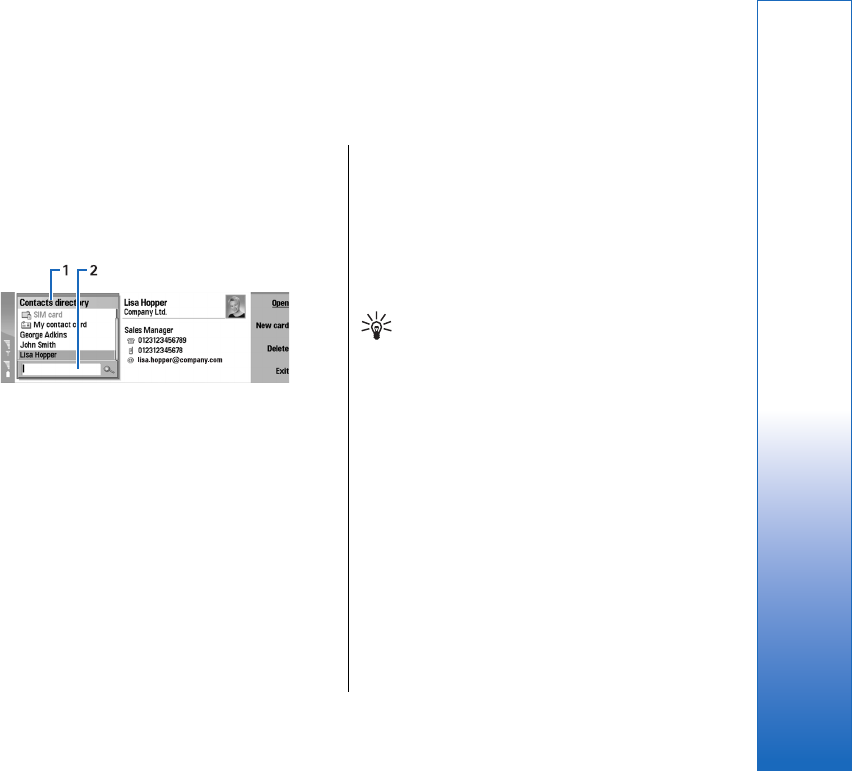
Contacts
You can use the Contacts application to create, edit,
and manage all contact information, such as phone
numbers and addresses.
The main contact database is in the device memory.
You can also store contacts in the SIM card and in
databases on a memory card inserted in the device.
The left frame of the Contacts main view (Contacts
directory) shows the contents of the currently open
contact database (1).
The available contact databases are shown at the top of
the list.
Below the list there is a search box for finding entries
(2).
The right frame of the Contacts main view shows the
contents of the contact card or contact group that you
have selected from the Contacts directory list.
Contact card information is also used by, for example,
the Telephone application.
Managing contact cards
To open a contact database, scroll to the desired
database in the Contacts directory list, and press Open.
To create a new contact card using the default
template, press New card, type the contact
information, and press Done. The card is added to the
selected contact database.
Tip: To use the phone number abroad, add a
plus (+) character before the country code.
To open a contact card in the selected database, scroll
to the contact in the Contacts directory list, and press
Open.
To search for an existing contact card from the selected
database, type the first letters of the contact in the
search field below the Contacts directory list, scroll to
the desired contact, and press Open.
To call a contact, scroll to the contact in the Contacts
directory list, move to the right window, scroll to the
phone number, and press Call.
To create a new contact card using a certain template,
press Menu, and select File → New card and the
template you want to use.
To delete an existing contact card, scroll to the contact
in the Contacts directory list, and press Delete and
then Delete.
53
Contacts
file:///C:/USERS/MODEServer/rapi/7167389/rae-6_mini/en/issue_1/rae-6_mini_en_1.xml Page 53 Nov 22, 2004 2:59:20 PM

To send a text or multimedia message to a contact,
scroll to the contact in the Contacts directory list,
move to the right window, scroll to a mobile phone
number, and press Write text message or Write MMS.
To send a fax to a contact, scroll to the contact in the
Contacts directory list, move to the right window,
scroll to a fax number, and press Write fax.
To send an e-mail message to a contact, scroll to the
contact in the Contacts directory list, move to the
right window, scroll to the e-mail address, and press
Write e-mail.
To copy all the contacts of a database, scroll to the
database in the Contacts directory list, press Copy all,
and select the database where you want to copy the
contact information.
To go to a Web address included in a contact card, scroll
to the contact in the Contacts directory list, move to
the right window, scroll to the Web address, and press
Go to.
To create a new database in your memory card , press
Menu, and select File → More options → New
database.
To exit the Contacts application, press Exit.
Editing contact cards
To add a field to the contact card, press Add field.
To rename a field in the contact card, scroll to the field,
and press Rename field. If you are not allowed to
rename the field, Rename field is dimmed.
To delete a field from the contact card, scroll to the
field, and press Delete field.
To change the default template for new contact cards,
press Menu, select Tools → Settings → General →
Default template, press Change, and select the
template.
To attach an image to the contact card, scroll to the
empty image frame, and press Insert picture.
To change the image in the contact card, scroll to the
image, and press Change picture.
To delete the image from the contact card, scroll to the
image, and press Remove picture.
To assign a certain ringing tone to a contact, press
Menu, select Card → Ringing tone, and press Change.
To attach DTMF tones to a contact card, press Add field,
select DTMF, and type a DTMF tone sequence.
To save the contact card and return to the Contacts
main view, press Done.
To delete a contact card, press Menu, select File →
Delete card.
My contact card
Tip: You can use the information in My contact
card as your electronic business card. You can
send your business card as a message or using
an infrared or Bluetooth connection, or use it
on the fax header or cover page.
To modify the fields in your contact card, scroll to a
field, and press Rename field, Delete field, or Add field.
54
Contacts
file:///C:/USERS/MODEServer/rapi/7167389/rae-6_mini/en/issue_1/rae-6_mini_en_1.xml Page 54 Nov 22, 2004 2:59:20 PMfile:///C:/USERS/MODEServer/rapi/7167389/rae-6_mini/en/issue_1/rae-6_mini_en_1.xml Page 54 Nov 22, 2004 2:59:20 PM
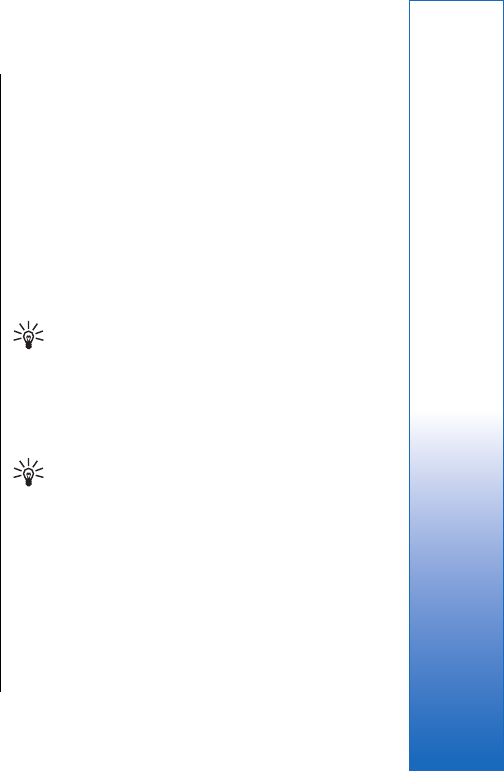
To attach an image to your contact card, press Menu,
and select Card → Insert picture, or scroll to the
empty image frame, and press Insert picture.
To change the image in your contact card, scroll to the
image, and press Change picture.
To delete the image from your contact card, press
Menu, and select Card → Remove picture, or scroll to
the image, and press Remove picture.
To save the changes and exit My contact card, press
Done.
Sending contact cards
In Contacts directory, you can send contact cards as
business cards in vCard or Nokia Compact Business Card
format to compatible devices using the SMS, MMS, or e-
mail service or an infrared or Bluetooth connection.
To open Contacts directory, go to Contacts.
Sending a contact card
Go to Contacts, scroll to a contact in the Contacts
directory list, press Menu, and select File → Send.
To send a contact card as a business card to a
compatible device, type the recipient's name in the To:
field, or press Recipient to select the name from the
contacts directory. To send the business card, press
Send. Note that if you select SMS as the sending
method, contact cards will be sent without images. For
other functions related to business cards, press Menu.
Creating and editing
contact groups
With contact groups you can send the same message to
a group of people at the same time.
To create a contact group, press Menu in Contacts
directory, and select File → New group…. Scroll to
Group name, and give a name for the group. To add a
member to the group, press Add member, scroll to a
contact in the list, and press Add. To select multiple
contacts, press Shift and scroll up or down with the
joystick.
Tip: If you want to restrict incoming calls to a
certain group of people, for example, while in a
meeting, you can create a contact group that
only includes those people. See Profile settings
on page 78.
To open a contact group, scroll to a contact group in
the Contacts directory list, and press Open.
Tip: To attach an image to the contact group,
press Menu, and select Group → Insert picture.
To remove a member from a contact group, open the
group in the Contacts directory list, scroll to the
member, and press Remove member.
55
Contacts
file:///C:/USERS/MODEServer/rapi/7167389/rae-6_mini/en/issue_1/rae-6_mini_en_1.xml Page 55 Nov 22, 2004 2:59:20 PMfile:///C:/USERS/MODEServer/rapi/7167389/rae-6_mini/en/issue_1/rae-6_mini_en_1.xml Page 55 Nov 22, 2004 2:59:20 PM

Copying and moving
contacts to different
databases
You can copy or move selected contacts from one
database to another.
To keep a copy of the contact card in the original
database, select Copy to and the contact database
where you want to copy the contact.
To move the contact card from the original database,
select Move to and the contact database where you
want to move the contact. No copy of the contact card
remains in the original database.
The primary contact database is in the device. You can
also store contact information in the databases of your
SIM and memory cards. The Contacts directory only
displays one database at a time. To view the contents
of a different database, select the database in the
Contacts directory, and press Open.
If you select the SIM card database, only the name and
numbers of the contact cards can be copied. If the
contact card includes more than one phone or fax
number, each number is placed in a separate SIM
memory location.
56
Contacts
file:///C:/USERS/MODEServer/rapi/7167389/rae-6_mini/en/issue_1/rae-6_mini_en_1.xml Page 56 Nov 22, 2004 2:59:20 PMfile:///C:/USERS/MODEServer/rapi/7167389/rae-6_mini/en/issue_1/rae-6_mini_en_1.xml Page 56 Nov 22, 2004 2:59:20 PM
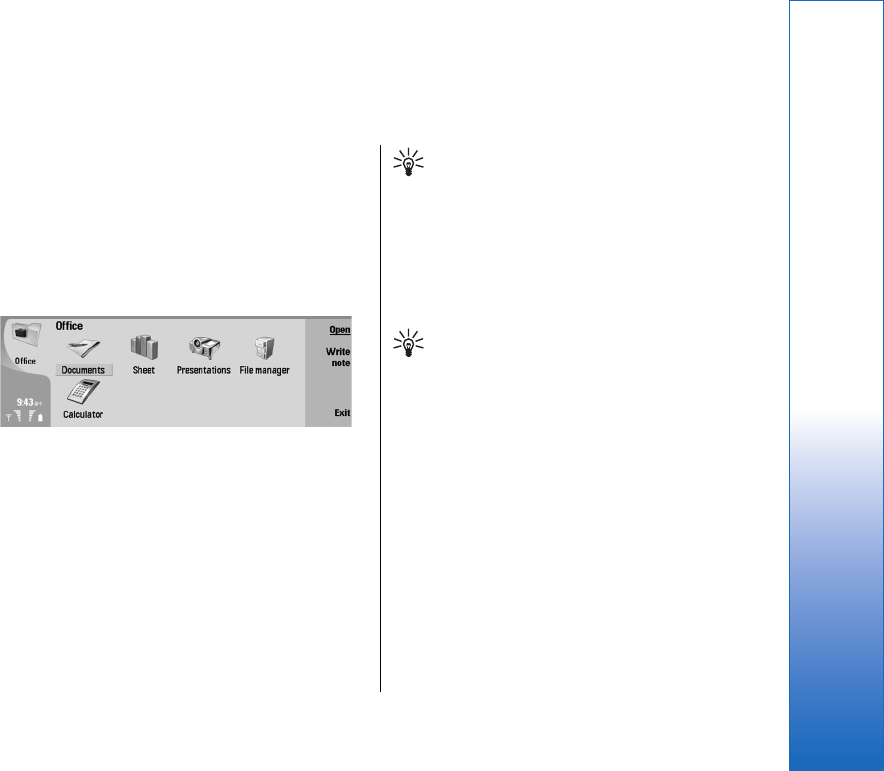
Documents
In Documents, you can write new and edit existing
text documents. You can insert and view images and
other files in the documents.
Documents is one of the applications available in the
Office group. Office also contains Sheet and
Presentations applications, Calculator, and File
manager application for file and folder management.
To open the Office group, select Desk → Office, and
press Open.
You can open, edit, and save documents created with
Microsoft Word for Windows versions 97 and later. Note
that not all features and formatting of the original
documents will be supported. The original document
must not be password protected. Documents created
with other versions of Microsoft Word may only be
viewed.
Working with documents
Move within the document with the joystick, and select
text by pressing Shift+scroll left right, up, or down.
Tip: The menu contains many options that are
familiar from other text editing applications.
To create a new document, start writing in the view
that opens, or press Menu, and select File → New
document → Blank document…. Write text or paste
it from another document.
To open an existing document, press Menu, and select
File → Open…. Browse for the folder where the file is
saved.
Tip: To open recently used documents, press
Menu, and select File → Recent documents.
To copy or cut selected text, press Menu, and select
Edit → Copy or Cut. To paste the text, go to the
document where you want to add the text, press Menu,
and select Edit → Paste.
To paginate a document, press Menu, and select Tools
→ Paginate. This command divides the document into
pages and updates the page numbering.
To insert page breaks or line breaks into a document,
press Menu, and select Insert → Page break or Line
break.
To count words, press Menu, and select Tools → Word
count.
To search for text in the document, press Menu, and
select Edit → Find…. Enter the text you are looking for,
and press Find. To refine the search criteria, press
Options. To replace the found item with something
57
Documents
file:///C:/USERS/MODEServer/rapi/7167389/rae-6_mini/en/issue_1/rae-6_mini_en_1.xml Page 57 Nov 22, 2004 2:59:20 PM

else, press Replace, enter the replacement text, and
press Replace.
To save and close a document, press Exit. If you have
modified the file, press Save to save the document with
a default file name. Press Save as to specify the file
name and location, or press Discard changes to close
the application without saving any changes.
To view the structure of a document, press Menu, and
select View → Outline…. The document is structured
by different levels of headings. Heading 1 is the top
level, Heading 2 comes second, and so on. Body text is
not shown in the document outline. To view more
levels in the document outline, press Expand. To hide
the lower levels, press Collapse. To jump to a particular
heading in the document, select the heading, and press
Go to.
To hide or make text markers visible, press Menu, and
select Tools → Preferences…. On the Basic options
page, you can define whether tab, space, and
paragraph marks are shown in the document. On the
Advanced options page, you can define whether
forced line breaks, nonbreaking spaces, and hard
hyphen marks are shown in the document.
To open a particular page in a document, press Menu,
and select Tools → Go to page…. In the Go to dialog,
you can see how many pages there are in the
document and select a page you want to jump to. Enter
the page number, and press Done.
Formatting documents
You can modify the style of a document on a font and
paragraph level. You can use different fonts, font sizes,
and styles. You can apply different predefined or user-
defined styles by either modifying particular pieces of
text separately, or by using a template on which the
style of the text is based.
To format text, select the text, press Menu, and select
Format → Font…, Formatting, Bullets…, or
Paragraph. Select the appropriate formatting option.
For example, you can add bold, italic, and underline
formatting, change the font size and color, and add
bullets and borders.
To edit or create a new paragraph style, press Style.
Select the style you want to edit, and press Edit. Press
New to create a new style. Give the new style a name,
and specify the font, bullet, border, and spacing
properties.
To change the paragraph style, move the cursor inside
a paragraph, and press Style. Select the new style, and
press Set.
Inserting and editing
objects
Objects in text documents are not links, but embedded
attachments, which may increase the file size of the
document dramatically. Some object types are
displayed as icons only.
58
Documents
file:///C:/USERS/MODEServer/rapi/7167389/rae-6_mini/en/issue_1/rae-6_mini_en_1.xml Page 58 Nov 22, 2004 2:59:20 PMfile:///C:/USERS/MODEServer/rapi/7167389/rae-6_mini/en/issue_1/rae-6_mini_en_1.xml Page 58 Nov 22, 2004 2:59:20 PM

To insert an object into a document, press Insert
object. Select from the list the type of object you want
to insert. Press Insert new to open the corresponding
editor and create a new object or press Insert existing
to open a list of existing files. Only those files that can
be inserted are listed. Select a file, and press OK.
To resize an image, select the image, press Menu, and
select Edit → Object → Object details…. On the
Scaling page, you can specify the width and height of
the image, or resize the image by a specific percentage.
On the Cropping page, you can crop the image. Note
that you cannot resize icons.
To open an object for viewing or editing, select the
object, and press the enter key.
To remove an object from a document, select the
object, and press the backspace key.
Viewing tables
Tables are shown as icons when the document has
been created with Microsoft Word for Windows. Such
tables can be opened for viewing in a separate view.
To view tables in a document, select the table icon, and
press the enter key.
To copy the table, press Copy.
To exit the table view, press Close.
Using templates
You can use templates and save documents as
templates. For example, you may have a company
template which defines a particular layout.
To save a document as a template, press Menu, and
select File → Save → Save as template….
To select a template, press Menu, and select File →
New document → Use template…. Browse for the
folder where the template is saved.
59
Documents
file:///C:/USERS/MODEServer/rapi/7167389/rae-6_mini/en/issue_1/rae-6_mini_en_1.xml Page 59 Nov 22, 2004 2:59:20 PMfile:///C:/USERS/MODEServer/rapi/7167389/rae-6_mini/en/issue_1/rae-6_mini_en_1.xml Page 59 Nov 22, 2004 2:59:20 PM
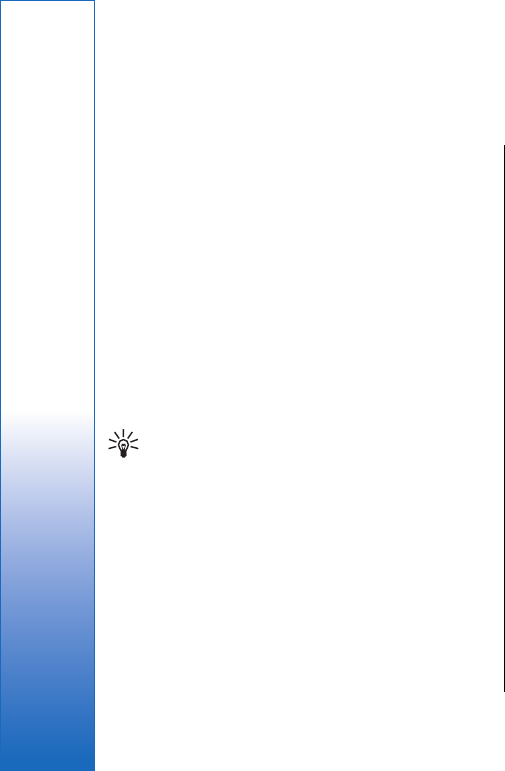
Sheet
In Sheet you can store your data in a file that is called a
workbook. Each workbook contains at least one
worksheet. A workbook can also contain charts; a chart
sheet is a sheet containing a chart that is based on data
from a worksheet.
Go to Desk → Office → Sheet.
Workbooks
To create a new workbook, press Menu, and select File
→ New workbook.
To open an existing workbook, press Menu, and select
File → Open. Browse for the folder where the file is
saved.
Tip: To open recently used workbooks, press
Menu, and select File → Recent workbooks.
Working with
worksheets
To insert data into cells, move to the cell with the
joystick, and enter the information.
To select an entire row in a worksheet, move the cursor
to the first cell on that row, and press Shift+scroll left.
To select an entire column, move the cursor to the first
cell of the column, and press Shift+scroll up. To select
the whole worksheet, press Esc.
To format worksheets, select the cell or cells you want
to format, press Menu, and select Format and an
appropriate menu option. You can change the font and
number formats, and adjust alignment, row height, and
column width. To format borders or the background
color of a cell, select Format → Cell appearance →
Borders or Background colour.
To add a new worksheet into a workbook, press Menu,
and select Insert → New worksheet.
To switch to another worksheet, press Menu, and select
View → Worksheets, or Sheets/Charts if the
workbook contains at least one chart. Select the
worksheet, and press OK.
To keep rows visible when scrolling, select the row
below the area that you want to remain visible. To
keep columns visible, select the column to the right of
the area that you want to remain visible. Press Menu,
and select View → Freeze panes.
To search for data, press Menu, and select Edit → Find.
Enter the text or numbers you want to find, and press
Find. To search the worksheet according to certain
criteria, press Options.
To rename a worksheet, press Menu, and select
Format → Rename worksheet. Enter the new name,
and press Done.
60
Sheet
file:///C:/USERS/MODEServer/rapi/7167389/rae-6_mini/en/issue_1/rae-6_mini_en_1.xml Page 60 Nov 22, 2004 2:59:20 PM
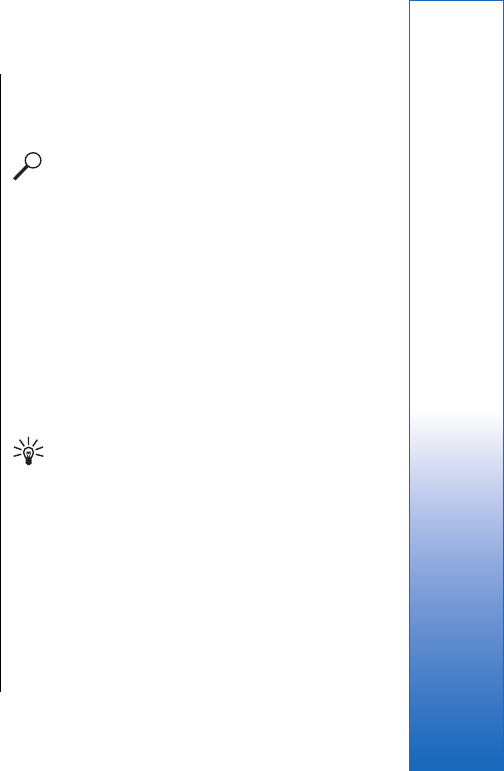
Working with cells
To clear contents or formatting from cells, select the
cells, and press Clear. If you select Formats, the
formatting of the selected cells is removed, but the
content remains. The default style is used. If you select
Contents, the content of the selected cells is deleted,
but the formatting stays the same. All clears both
formatting and contents of the selected cells.
To insert cells, select the area where you want to insert
new cells, press Menu, and select Insert → Cells. You
can insert cells above (Shift cells down) or to the left
(Shift cells right) of the selected range. If you have
selected only one cell, only one new cell is inserted, and
if you have selected a range of cells, a corresponding
range of blank cells is inserted. To insert a new row or
column, select Entire row or Entire column, and press
OK.
To rearrange the order of cells, select the cells, press
Menu, and select Tools → Sort → Top to bottom or
Left to right. On the 1st column or 1st row page,
select the direction of sorting, and to sort by case,
select Yes in the Case sensitive field. If you have
selected more than one row or column, move to the
second and third page to sort the next column or row.
To insert a function into a selected cell, press Insert
function in the worksheet. Functions are used to
automate calculations. You can choose from different
function categories, and each category has a set of
functions. For example, MIN finds the lowest value in
the numeric contents of a selected range of cells,
AVERAGE calculates the average of the values, and SUM
adds the values together. Once you have selected a
function, press Done. The function is inserted into the
selected worksheet cell. On the worksheet, press Point
reference, select the cells you want to include in the
function with Shift+joystick, and press OK.
Example: You want to add up the numbers in
cells C2 to C6 and have the results appear in cell
C7. Select cell C7, and press Insert function.
Select the function SUM, press OK, and press
Done. Press Point reference, select the cell
range C2 to C6 with Shift+joystick, and press
OK. The sum appears in cell C7.
To name a cell, select the cells you want to name, press
Menu, and select Insert → Name → Add. Enter the
name for the cell or range of cells. The coordinates of
the cells you have selected on the worksheet are
automatically inserted in the Value field. You can enter
new coordinates to change the cell selection. You can
also enter numbers or letters for use in different
functions.
Tip: You can use cell names to make calculating
functions easier to understand. For example,
cells named Rent and Groceries could be
subtracted from a cell named Salary when
calculating the money left for leisure activities
after monthly living costs.
Creating and modifying
chart sheets
Chart sheets contain charts based on information from
worksheets. When you change the information on a
worksheet, the chart is updated simultaneously.
61
Sheet
file:///C:/USERS/MODEServer/rapi/7167389/rae-6_mini/en/issue_1/rae-6_mini_en_1.xml Page 61 Nov 22, 2004 2:59:20 PMfile:///C:/USERS/MODEServer/rapi/7167389/rae-6_mini/en/issue_1/rae-6_mini_en_1.xml Page 61 Nov 22, 2004 2:59:20 PM

To create a chart sheet, select the worksheet cells that
contain the information you want to include in the
chart, press Menu, and select Insert → New chart.
Select the chart type, make the chart two or three-
dimensional, change the color of the background and
axis, or add a title to the chart.
To change the range of cells on which the chart is
based, press Sheets/ Charts, select the worksheet your
chart is based on, and press OK. Select a new range of
cells, press Menu, and select View → Sheets/Charts.
Select the chart sheet, and press OK. On the chart sheet,
press Menu, and select Tools → Replace data. Press
Replace ranges to confirm the change.
To replace chart sheet data, press Sheets/ Charts.
Select the worksheet, and press OK. Edit the
information in the worksheet, and press OK. Press
Menu, and select View → Sheets/Charts. Select the
chart, and press OK.
To change the general appearance of a chart, press
Chart settings. You can select the chart type, make the
chart three-dimensional, and change the color of the
background and axis. You can also change the title
shown in the chart.
To format a chart in more detail, press Select object.
Select the object you want to edit, and press OK. Press
the enter key to open a dialog where you can modify
the relevant settings.
Tip: You can also select chart sheet objects by
pressing the tab key.
To switch to another chart sheet in the same
workbook, press Sheets/ Charts. Select the chart, and
press OK.
To delete a chart sheet, press Menu, and select Chart
→ Delete chart.
62
Sheet
file:///C:/USERS/MODEServer/rapi/7167389/rae-6_mini/en/issue_1/rae-6_mini_en_1.xml Page 62 Nov 22, 2004 2:59:20 PMfile:///C:/USERS/MODEServer/rapi/7167389/rae-6_mini/en/issue_1/rae-6_mini_en_1.xml Page 62 Nov 22, 2004 2:59:20 PM

Presentations
In Presentations, you can open, view, edit, and save
presentations created with Microsoft PowerPoint 97 or
later. You can also create new presentations. Note that
not all features and formatting of the original files are
supported.
Go to Desk → Office → Presentations.
Viewing presentations
To open an existing presentation, press Menu, and
select File → Open…, or press Ctrl+O. Browse for the
folder where the file is saved. You can scroll the slide up
and down, left and right with the joystick.
To move between slides, press Next and Previous. To
move directly to a specific slide, press Menu, and select
Tools → Go to slide…. Select the slide from the list,
and press Go.
To zoom the view, press Menu, and select View → Zoom.
Tip: You can also zoom in and out by pressing
Chr and the magnifying glass keys.
To view slides in full screen mode, press Menu, and
select View → Full screen mode. In full screen mode,
press any of the command buttons to display the
commands. You can also use Ctrl+T to switch between
the full screen and normal screen modes.
Viewing slide shows
Special effects or animation in a presentation are
shown in a slide show. Note that not all special effects
or animations are supported.
To start a slide show, press Menu, and select View →
Slide show → View show.
To set slide show options, press Menu, and select View
→ Slide show → Show unsupported objects or
Show animations.
To move between slides in a slide show, press Menu,
and select Show → Next and Previous. To select the
first or last slide, press Menu, and select Show → First
slide or Last slide. To move to a specific slide, press
Menu, and select Tools → Go to slide…. Select the
slide from the list, and press Go.
To end the slide show, press Menu, and select Show →
End show.
Showing slide shows with a
data projector
You can show slide shows with a compatible data
projector, or other compatible projection system. The
slide show is transferred to the data projector using a
Bluetooth connection.
To be able to show slide shows with a compatible data
projector, you need to install the drivers of the data
63
Presentations
file:///C:/USERS/MODEServer/rapi/7167389/rae-6_mini/en/issue_1/rae-6_mini_en_1.xml Page 63 Nov 22, 2004 2:59:20 PM
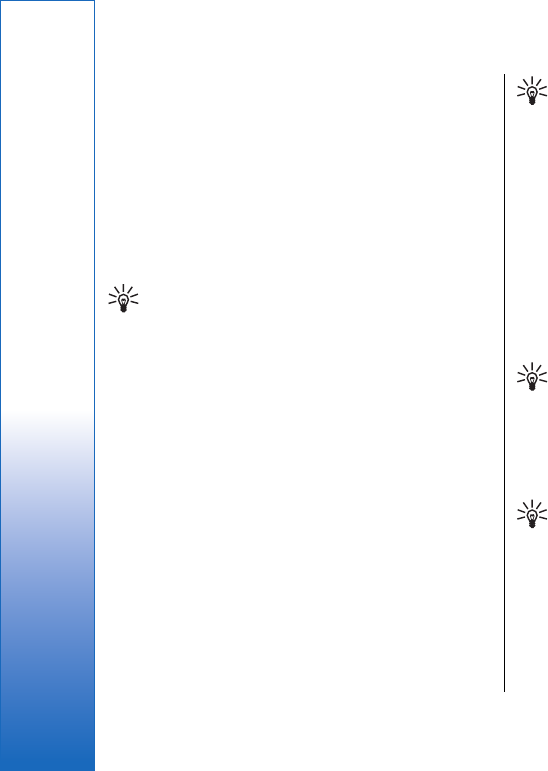
projector. If the drivers are not installed, the menu
options are not visible. For more information, check
with the data projector manufacturer or its
representative.
To show slide shows with a data projector, select the
presentation, press Menu, and select View → Slide
show → Show on external display. To start the slide
show, press Menu, and select View → Slide show →
View show. Note that no special effects or animations
are supported. If the presentation contains notes, they
are only visible on the communicator display.
Tip: If you have not selected a data projector
earlier, the External display dialog opens.
Select a data projector, press Connect, then
Done.
To change the data projector, press Menu, and select
View → Slide show > External display settings…. In
the External display dialog, select a device from the
list, and press Connect, then Done.
To stop showing a slide show with a data projector,
press Menu, select View → Slide show, and deselect
Show on external display.
Creating presentations
To create a new presentation, press Menu, and select
File → New presentation. Activate a text field by
pressing the tab key, and start writing. When you are
ready, press OK, and move to the next text field. If you
want to use a template, press Menu, and select File →
New presentation → Use template…. Browse for the
folder where the template is saved.
Tip: To move the text field inside the slide,
select the text field with the tab key, and scroll
with the joystick. To move the text field with
smaller steps, press Ctrl+scroll with the joystick.
Similarly, you can move other objects, such as
pictures or autoshapes.
To insert a new slide into a presentation, select the
slide after which you want to add the slide, and press
Insert slide. Select the layout you want to use in the
new slide, and press Insert.
To insert images or autoshapes into a presentation,
press Menu, and select Insert → Picture… or
Autoshape…. Browse for the folder where the image is
saved, or select an autoshape from the list, and press
Insert.
Tip: To change the size of an object, press Shift
+scroll left, right, up, or down. To change the
size with smaller steps, press Ctrl+Shift+scroll
left, right, up, or down.
To insert a text box into a presentation, press Menu,
and select Insert → Text box. Enter the text, and
press OK.
Tip: The menu contains further text formatting
options: press Menu, and select Format and a
menu option. You can change the font and
number formats, add bullets, and adjust
alignment.
To format an object you have inserted into a slide,
select the object, press Menu, and select Format →
Object…. You can resize the object and rotate it. Note
that not all objects, such as images or tables, can be
rotated.
64
Presentations
file:///C:/USERS/MODEServer/rapi/7167389/rae-6_mini/en/issue_1/rae-6_mini_en_1.xml Page 64 Nov 22, 2004 2:59:20 PMfile:///C:/USERS/MODEServer/rapi/7167389/rae-6_mini/en/issue_1/rae-6_mini_en_1.xml Page 64 Nov 22, 2004 2:59:20 PM

Inserting tables
To insert a table into a presentation, press Menu, and
select Insert → Table → Insert table…. Select the
number of rows and columns you want to have in the
table, and press Insert.
To select cells in a table, select the table by pressing the
tab key, then press the enter key. Press the tab key to
select cells.
To add rows or columns to a table, select a cell, press
Menu, and select Insert → Table → Insert column or
Insert row. A new column is inserted to the left of the
selected cell, and a new row is inserted above the
selected cell.
To remove rows or columns from a table, select a cell in
the row or column you want to remove, press Menu,
and select Insert → Table → Delete column or
Delete row.
Working with different
views
Presentations consists of different views that help you
when creating presentations.
To switch between the different views, press Menu, and
select View → Slide, Notes, Outline, or Slide master.
Outline view
The outline view displays the text content of the
presentation slides, and is used for organizing the
content.
To open the outline view, press Menu, and select View
→ Outline.
To view the slide content, press Expand. To hide the
content, press Collapse. To open a slide for editing,
select the slide, and press the enter key.
To change the order of slides, select the slide you want
to move, and press Move. Scroll up and down to move
the position marker to a new location, and press OK.
Notes view
In the notes view, you can read notes that have been
attached to slides in the presentation. You can also add
your own notes.
To open the notes view, press Menu, and select View
→ Notes. To move between the slides, press Next and
Previous.
To add a note, activate a text field by pressing the tab
key, and start writing in the text field. When you are
ready, press OK, and move to the next slide if needed.
Slide master view
The slide master is a slide that controls certain text
characteristics that are common to all slides in a
presentation. When you want to change the look of
65
Presentations
file:///C:/USERS/MODEServer/rapi/7167389/rae-6_mini/en/issue_1/rae-6_mini_en_1.xml Page 65 Nov 22, 2004 2:59:20 PMfile:///C:/USERS/MODEServer/rapi/7167389/rae-6_mini/en/issue_1/rae-6_mini_en_1.xml Page 65 Nov 22, 2004 2:59:20 PM

your slides, change the slide master instead of
changing each slide individually.
To open the slide master view, press Menu, and select
View → Slide master. Activate a text field by pressing
the tab key, and start writing. When you are ready,
press OK, and move to the next text field.
66
Presentations
file:///C:/USERS/MODEServer/rapi/7167389/rae-6_mini/en/issue_1/rae-6_mini_en_1.xml Page 66 Nov 22, 2004 2:59:20 PMfile:///C:/USERS/MODEServer/rapi/7167389/rae-6_mini/en/issue_1/rae-6_mini_en_1.xml Page 66 Nov 22, 2004 2:59:20 PM
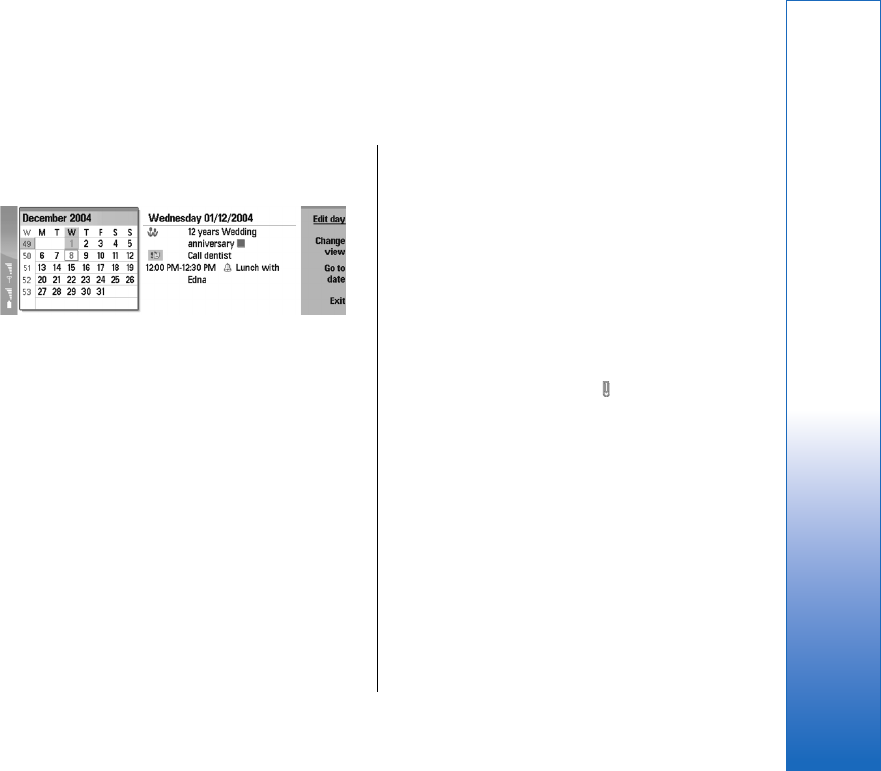
Calendar
In Calendar, you can create and view scheduled events
and appointments. You can also set alarms to calendar
entries.
Calendar, Month view
You can synchronize your calendar data with a
compatible computer using PC Suite on the product CD-
ROM. For information on synchronization, see the PC
Suite guide.
You can also synchronize calendar data with
compatible phones. See Data transfer on page 97.
Creating calendar entries
There are four types of calendar entries:
• Meeting entries are entries that have a specific date
and time.
• Memo entries are related to the whole day, not to a
specific time of day. Memo entries do not appear in
the Weekly time schedule view.
• Anniversary entries remind you of birthdays and
special dates. They are repeated every year.
• To-do notes remind you of things to do. They can be
prioritized and organized into to-do lists.
To create a calendar entry, select the date, press Menu,
and select File → New entry. Select the type of entry
you want to create. Note that available settings for
meeting, memo, anniversary, and to-do note entries
vary.
Define the settings on the following pages:
•Details page—You can enter a description and
specify a date for the entry. To set a specific start
and end time, select Yes in the Timed field.
•Notes page—You can enter extra information for
the calendar entry. The icon is added to the entry.
•Alarm page—You can set an alarm for the entry.
Select the Set alarm field and Yes. Enter the alarm
time and the number of days before the entry you
want the alarm to go off. If you have a meeting
entry that is linked to a specific time, enter in the
Time before field the amount of time before the
meeting you want the alarm to go off. Note that you
can set an alarm for a to-do note only if you have set
a due date on the Details page.
•Repeat page—You can specify whether you want
the entry to be repeated and when. Define the
repeat type, frequency, and possible ending date.
•Status page—You can define a color and symbol
for the entry, define status, as well as specify
whether you want to synchronize the entry. If the
status of an entry is uncertain, mark it as Tentative.
67
Calendar
file:///C:/USERS/MODEServer/rapi/7167389/rae-6_mini/en/issue_1/rae-6_mini_en_1.xml Page 67 Nov 22, 2004 2:59:20 PM
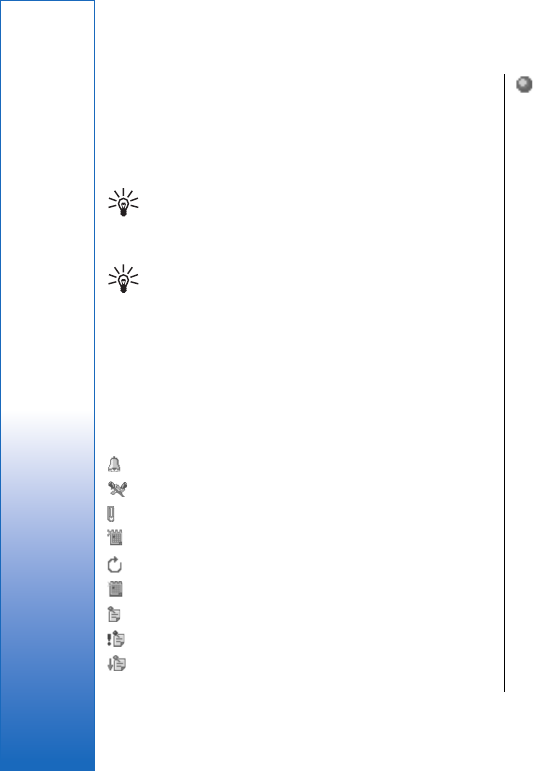
You can cross out an entry if it has been completed.
Crossing out an entry does not remove it from the
calendar. If you select Private in the
Synchronisation field, the details of the entry will
not be shown to others when you connect to a
network and synchronize your calendar.
Tip: Another way to create a calendar entry is
to start typing your entry when you have
opened Calendar. As you enter characters, the
default entry dialog opens.
Tip: Make sure you have selected the correct
city in the Clock application, because scheduled
calendar entries may change when the current
city is changed and is on another time zone.
To open and edit an entry, select the entry, and press
Edit. Edit the details on the various pages.
Calendar icons
The following icons are used in Calendar:
Alarm
Anniversary
Note
Memo
Repeating entry
Tentative entry
To-do note
To-do note with high importance
To-do note with low importance
Untimed entry
Managing calendar entries
To cross out an entry or mark it as tentative, select the
entry, press Menu, and select Entry → Crossed out or
Tentative. Crossing out en entry does not remove it
from the calendar.
To send a calendar entry, press Menu, and select File
→ Send. Select the method of sending.
To add a received calendar entry to your calendar, open
the message that contains the calendar entry, and press
Add to calendar.
To define default entry settings, press Menu, and select
Entry → Default settings. Select an entry type, and
enter the values you would most commonly use.
To change the type of an open entry, press Menu, and
select Entry → Change entry type…. Select the new
entry type from the list, and press Select.
To delete a calendar entry, select the entry, and press
the backspace key. Press OK to confirm the deletion.
To move or delete several calendar entries, press Menu,
and select Tools → Move/Delete…. To either move all
the suggested entries to a different file or delete them
from the device, press OK. To define further criteria,
press Options. You can specify whether calendar
entries are deleted or moved to a file, the type of
entries to be removed, and restrict the removal to a
specific time period.
To search for calendar entries, press Menu, and select
Tools → Find entry…. Enter the search keywords
68
Calendar
file:///C:/USERS/MODEServer/rapi/7167389/rae-6_mini/en/issue_1/rae-6_mini_en_1.xml Page 68 Nov 22, 2004 2:59:20 PMfile:///C:/USERS/MODEServer/rapi/7167389/rae-6_mini/en/issue_1/rae-6_mini_en_1.xml Page 68 Nov 22, 2004 2:59:20 PM

included in the description of the entry you are looking
for, and press Find. To restrict the number of entries
searched, press Options. You can narrow down the
search by specifying the target group, time period, and
calendar entry type. Press Done → Find to start
searching. In the Find results view, you can modify the
found entry and open the previously open calendar
view.
To modify general calendar settings, press Menu, and
select Tools → General settings…. On the General
page, you can choose the view that opens when you
open the Calendar application, and define where you
want untimed entries to appear in calendar views. On
the Preferred views page, you can change the order in
which calendar views are listed. If you select No for a
calendar view, it is shown last in the list or not shown
at all when you change views by pressing the Calendar
application key repeatedly.
Calendar views
To switch between the different calendar views, press
Change view in any calendar view. Select a type of
view from the list, and press Select.
To edit calendar views, select a calendar view, press
Menu, and select View → View settings….
For more instructions on editing the settings of a view,
see the Help function in the device.
To open a specific date in the calendar view, press Go
to date, enter the date, and press OK. To go to today's
date, press Today. To view the date in the Month view,
press Browse.
Tip: To go to today's date in most calendar
views, press the space bar on the keyboard.
Month view
In the Month view, you can browse the days of one
month on the left frame, and view the entries for those
days on the right frame. Today's date is marked with a
colored rectangle, days that have scheduled events are
marked in bold and blue, and the currently selected
date is highlighted.
To switch between the days of the month and day's
entries, press the tab key.
Week view
The Week view shows the events for the selected week
in seven day boxes. Today's date is marked with a
colored rectangle.
Tip: To quickly select a different date in day
and week views, press the tab key, select the
desired date, and press the enter key.
Day view
The Day view shows the events for the selected day.
Entries are grouped into time slots according to their
starting time. To view the previous or next day, scroll
left or right.
69
Calendar
file:///C:/USERS/MODEServer/rapi/7167389/rae-6_mini/en/issue_1/rae-6_mini_en_1.xml Page 69 Nov 22, 2004 2:59:20 PMfile:///C:/USERS/MODEServer/rapi/7167389/rae-6_mini/en/issue_1/rae-6_mini_en_1.xml Page 69 Nov 22, 2004 2:59:20 PM

Weekly time schedule view
The Weekly time schedule view shows the reserved
hours for the selected week. Only timed entries are
shown. If a time box contains entries, the bar across the
bottom of the weekly time schedule shows the details
of the entry. The numbers to the right of the entry
description indicate the number of entries in that time
box. For example, 1/3 means that you are seeing the
details of the first of three entries. If a time box
contains more than one entry, press the tab key to view
a list of all entries.
Year schedule view
The Year schedule view shows the timetable for the
selected year. Only entries with colors are shown. If
there are several colors for the day, only one can be
shown.
Anniversaries view
The Anniversaries view shows the anniversaries for
four months at a time. No other entries are shown.
To-do lists view
In the To-do lists view, you can view and create lists
that contain to-do notes. The page number in the upper
right corner indicates the position of the to-do list
among other to-do lists. For example, 1/6 means that
you are viewing the first to-do list out of six. To view
the previous or next list, scroll left or right. To see a list
of all to-do lists, press the tab key.
To create a new to-do list, press Menu, and select File
→ New to-do list…. On the Details page, enter the
name, position, and sorting order of the to-do list. On
the Visibility page, define whether to-do notes are
visible in to-do lists only or in all calendar views, and
the time position in which you want the to-do notes
displayed in calendar views.
70
Calendar
file:///C:/USERS/MODEServer/rapi/7167389/rae-6_mini/en/issue_1/rae-6_mini_en_1.xml Page 70 Nov 22, 2004 2:59:20 PMfile:///C:/USERS/MODEServer/rapi/7167389/rae-6_mini/en/issue_1/rae-6_mini_en_1.xml Page 70 Nov 22, 2004 2:59:20 PM
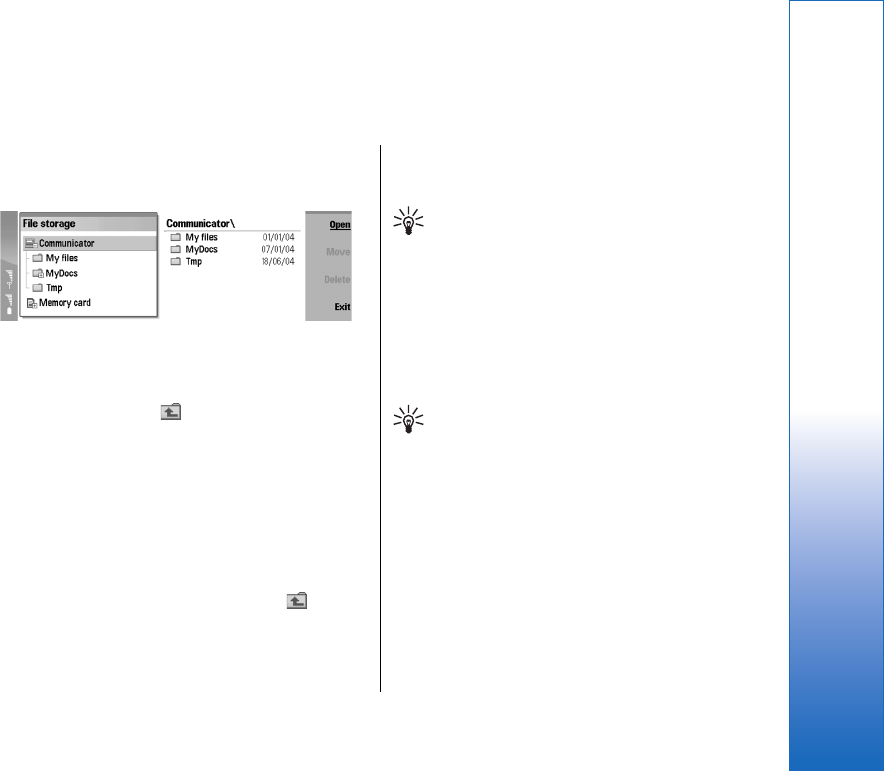
File manager
In File manager, you can manage the contents and
properties of files and folders.
Go to Desk → Office → File manager.
On the left frame of the File manager view, you can
browse and select folders. To expand and collapse
folders, scroll right and left with the joystick. On the
right frame you can open subfolders and files. To move
up one folder level, select , and press Open. To move
from one frame to another, press the tab key.
Managing files and
folders
To open a folder, select the folder, and press Open. A
view of all the subfolders and files of the parent folder
opens. To open a subfolder, select the folder, and press
Open. To open the upper-level folder, select , and
press Open. Press Close folder to return to the main
view.
To open a file, select the file, and press Open. The
appropriate application opens the file. Note that you
can open only one file at a time.
Tip: To view hidden files, press Menu, and
select View → Show all files.
To create a new file or folder, move to the location
where you want to create the new file or folder, press
Menu, and select File → New folder or New file….
Enter the name, and press OK.
To move or copy files or folders, select the file or folder,
press Menu, and select Edit → Cut or Copy. Then move
to the location where you want to place the file or
folder, press Menu, and select Edit → Paste.
Tip: You can also move files or folders by
pressing Move.
To rename files or folders, select the file or folder, press
Menu, and select File → Rename. Enter the new name,
and press Rename. It is recommended that you do not
change the names of the default folders. Default folders
are folders that the device creates during the first start-
up, such as C:\My files\ and C:\My files emplates\.
To delete files or folders, select the file or folder, and
press Delete.
To view and modify properties of a file, folder, or drive,
select the file, folder, or drive, press Menu, and select
File → Properties…. To prevent the file or folder from
being edited, select the Read-only field, and select Yes.
71
File manager
file:///C:/USERS/MODEServer/rapi/7167389/rae-6_mini/en/issue_1/rae-6_mini_en_1.xml Page 71 Nov 22, 2004 2:59:20 PM
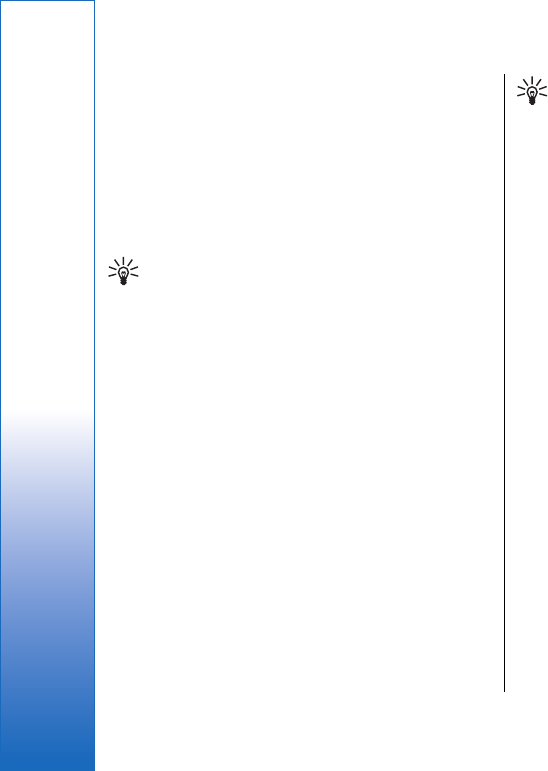
To change a file into hidden state, select the Hidden
field and Yes.
To sort files and folders, press Menu, and select View
→ Sort by or Sorting order. Select one of the available
options.
To modify File manager settings, press Menu, and
select Tools → Settings…. You can define whether
you want to be able to browse the system directory
and all its folders and files in File manager.
Tip: It is advisable to hide the system directory
so that you cannot accidentally delete or move
important system files and risk causing
software to malfunction.
To search for files and folders, press Menu, and select
Tools → Find…. Enter the text that is included in the
name of the file or folder you are looking for, and press
Find. To change the location or refine the search
criteria, press Options.
In the Results of Find view, you can open and delete
the files and folders found, as well as move, copy,
rename, and sort them.
Memory card security
To protect the memory card with a password, press
Menu, and select Memory card → Security →
Change password…. Enter the current password (if
already set); then enter the new password, confirm it,
and press OK. The password is up to 8 characters long,
and it is asked for each time someone tries to access
the memory card.
Tip: The password is case-sensitive, and you
can use upper and lowercase letters. You can
also use numbers.
To remove the memory card password, press Menu, and
select Memory card → Security → Remove
password…. Enter the current password, and press
Remove.
To format a memory card, press Menu, and select
Memory card → Format memory card…. All memory
card data is permanently deleted.
To back up or restore data to or from a memory card,
press Menu, and select Memory card → Backup to
memory card… or Restore from memory card….
72
File manager
file:///C:/USERS/MODEServer/rapi/7167389/rae-6_mini/en/issue_1/rae-6_mini_en_1.xml Page 72 Nov 22, 2004 2:59:20 PMfile:///C:/USERS/MODEServer/rapi/7167389/rae-6_mini/en/issue_1/rae-6_mini_en_1.xml Page 72 Nov 22, 2004 2:59:20 PM
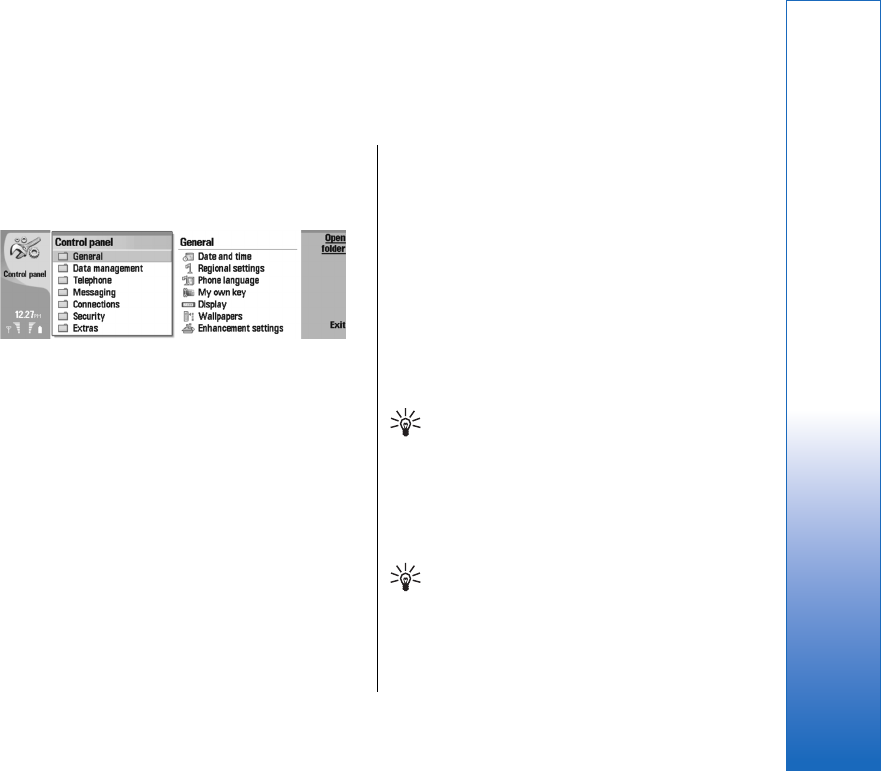
Control panel
In Control panel, you can define and modify various
settings of your device. Modifying these settings affects
the operation of your device across several applications.
Go to Desk → Tools → Control panel.
Control panel, main view
To open an application in Control panel, select one of
the folders in the left frame, then the appropriate item
in the right frame.
To zoom in on the Control panel view, press Menu, and
select View → Zoom in.
General
Go to Desk → Tools → Control panel → General.
Date and time
You can change the time and date used by applications
such as Calendar and Clock.
To set the current time and date, select General →
Date and time, select the Time and Date fields, and
enter the numbers. When setting the date, you can also
press Browse to open a month grid where you can
select a date.
To update date and time automatically, select General
→ Date and time. In the Auto time update field,
select On. The time, date, and time zone information is
updated to your device from the mobile phone network
(network service). If the time zone changes, the current
city also changes in the Clock application, and starting
and ending times of your calendar entries are shown in
local time. For the setting to take effect, the phone
needs to be restarted.
Tip: Check any alarms and scheduled calendar
entries, as these may be affected by Auto time
update.
To use daylight saving, select General → Date and
time. In the Daylight-saving field, select On to use the
system's daylight saving time. Note that you cannot
activate daylight saving if you have selected On in the
Auto time update field.
Tip: To change the time and date format, select
General → Regional settings. Modify the
settings on the Time and Date pages.
73
Control panel
file:///C:/USERS/MODEServer/rapi/7167389/rae-6_mini/en/issue_1/rae-6_mini_en_1.xml Page 73 Nov 22, 2004 2:59:20 PM

Regional settings
You can define the format for the local time, date,
numbering, and currency.
To define regional settings, select General →
Regional settings, and select the appropriate page.
Time page
Define the following:
•Time format—Select the 12-hour or 24-hour clock
system.
•am/pm format—If you selected the 12-hour clock
format in the previous field, choose the way the 12-
hour clock is expressed.
•Separator—Select the symbol that separates hours
and minutes.
Date page
Define the following:
•Date format—Choose the order of days, months,
and years.
•Separator—Select the symbol that separates days,
months, and years.
•First day of the week—Change the first day of the
week.
•Working days—Define which are the working
days of the week.
Numbers page
Define the following:
•Decimal point—Select the sign that is used as a
decimal point.
•Thousands separation—Select whether you want
to use separation between thousands.
•Thousands separator—Select the sign that is used
to separate thousands and hundreds.
•Measurement units—Select either metric or
nonmetric units for length measurement.
Currency page
Define the following:
•Currency symbol—Enter the symbol for the used
currency.
•Decimal places—Define the number of decimal
figures used in currency numbers.
•Symbol position—Define the position and spacing
of the currency symbol and the number of currency
units.
•Negative value format—Define how a negative
amount of currency is expressed.
Device language
To change the language of the device, select General
→ Device language. Select the new language from the
list, and press Done. Press Reboot to restart the device.
My own key
To select the application that opens when you press the
My own key, select General → My own key. Press
Select, select the application, and press Done.
74
Control panel
file:///C:/USERS/MODEServer/rapi/7167389/rae-6_mini/en/issue_1/rae-6_mini_en_1.xml Page 74 Nov 22, 2004 2:59:20 PMfile:///C:/USERS/MODEServer/rapi/7167389/rae-6_mini/en/issue_1/rae-6_mini_en_1.xml Page 74 Nov 22, 2004 2:59:20 PM

Display
To define the contrast and brightness of the display,
select General → Display.
Define the following:
•Contrast level—Press + or - to increase or
decrease the difference between the lightest and
darkest areas on the screen.
•Brightness—Press + or - to increase or decrease
the amount of white the colors contain.
•Brightness period—Select a time period after
which the display is dimmed if the device remains
inactive.
•Screen saver—Select a time period after which the
display is automatically switched off if there have
been no key presses within that time.
Tip: You can adjust brightness also by pressing
Chr+space bar.
To define the color set for the dialogs and controls,
select General → Display. On the Colour page, select
the Colour palette field, select one of the color sets,
and press Done.
To define the cursor speed and acceleration, select
General → Display, and select the Cursor settings
page. Specify how fast the cursor moves, and how
much it accelerates as you move it faster.
Wallpapers
To change the background image of the communicator
interface, select General → Wallpapers. Select the
Desk page, and in the Wallpaper field, select Yes.
Select the Image file field, and press Change. Pre-
installed wallpapers are shown in the Select
wallpaper dialog. To search for other files, press
Browse. Note that by default only image files are
shown. To view other types of files, press Show all
files. To view the selected image, press Preview.
Similarly, you can change the background image of the
cover phone display on the Cover page.
Enhancement settings
To let the device answer phone calls automatically
when an enhancement is in use, select General →
Enhancement settings, select Headset, Loopset, or
Car kit from the list, and press Edit. In the Automatic
answer field, select On.
To select the profile that is activated when you attach
an enhancement to your device, select General →
Enhancement settings, select Headset, Loopset, Car
kit, or TTY from the list, and press Edit. Change the
profile in the Default profile field. To select the
currently active profile, select Active.
To keep the light of the cover phone switched on when
the device is attached to a car kit, select General →
Enhancement settings, select Car kit from the list,
and press Edit. In the Cover display lights field, select
Always on.
To activate the TTY (teletypewriter), select General →
Enhancement settings, select TTY from the list, and
press Edit. In the TTY active field, select Yes.
75
Control panel
file:///C:/USERS/MODEServer/rapi/7167389/rae-6_mini/en/issue_1/rae-6_mini_en_1.xml Page 75 Nov 22, 2004 2:59:20 PMfile:///C:/USERS/MODEServer/rapi/7167389/rae-6_mini/en/issue_1/rae-6_mini_en_1.xml Page 75 Nov 22, 2004 2:59:20 PM

Data management
Go to Desk → Tools → Control panel → Data
management.
Application manager
In Application manager, you can view the details of
installed applications or remove them from your device.
You can also specify installation settings.
You cannot install applications in Application
manager. See Installing applications and software on
page 99.
When you open Application manager, the Installed
software page lists all of the software packages that
have been installed, with their name, version number,
type, and size.
To view the details of an installed software package,
select Data management → Application manager,
and select the Installed software page. Select an
application or a component from the list, and press
Details.
To uninstall applications or components, select Data
management → Application manager. Select the
software from the list, press Remove, and confirm the
removal. Note that some software packages update
existing software, and after the installation you may
only be able to remove the whole software package,
not the update.
Note that if you remove software, you can only reinstall
it by using the original software package file, or by
restoring a full backup that contains the removed
software package. If you remove a software package,
you may no longer be able to open files created with
that software. If another software package depends on
the software package that you removed, the other
software package may stop working. Refer to the
documentation of the installed software package for
details.
To view the installation log, select Data management
→ Application manager, and select the Install log
page. A list shows what software has been installed
and removed, and the date of installation or removal. If
you encounter problems with the device after installing
a software package, you can use this list to find out
which software package may be the cause of the
problem. The information in this list may also help to
pinpoint problems that are caused by software
packages that are incompatible with each other.
To save the contents of the installation log, select Data
management → Application manager, and select
the Install log page. Press Copy, and open the
application where you want to paste the contents.
Modifying installation settings
To modify installation settings, select Data
management → Application manager, and select
the Preferences page. You can select options related to
software installation.
•Delete source file after installation—If you select
Yes, the software package installation file is deleted
from the device after installation. If you download
software packages using the Web browser, this may
help to reduce the amount of storage space
required. If you want to store the software package
76
Control panel
file:///C:/USERS/MODEServer/rapi/7167389/rae-6_mini/en/issue_1/rae-6_mini_en_1.xml Page 76 Nov 22, 2004 2:59:20 PMfile:///C:/USERS/MODEServer/rapi/7167389/rae-6_mini/en/issue_1/rae-6_mini_en_1.xml Page 76 Nov 22, 2004 2:59:20 PM

file for possible reinstallation, do not select this
option, or make sure that you have a copy of the
software package file stored on a compatible PC or
on a CD-ROM.
•Enable online cert. checking—If you select Yes,
the certificate of the file is verified during installation.
•Web address for cert. checking—Enter the Web
address of the site that checks online certificates.
•Preferred language—If the software package
contains several language versions of the software,
select the language version that you want to install.
•Install application—Specify what kind of
applications you want installed. If you select Only
certified, only applications with validated
certificates can be installed. Note that this setting
applies only to Symbian operating system
applications (SIS files).
Backup
See Backup on page 97.
Memory
To view memory consumption, select Data
management → Memory. You can view the amount
of free memory and the memory consumption of
different items on your device and memory card.
To switch between device memory and memory card
statistics, select Data management → Memory, and
press Device or Memory card.
Tip: To avoid memory getting low, you should
regularly delete or transfer data to a memory
card or PC.
Messaging tools
To automatically empty the Sent folder in Messaging,
select Data management → Messaging tools, and
select Sent items storage. Set Delete sent items to
automatically, and enter the number of days after
which the device empties the folder.
To delete messages from the device, select Data
management → Messaging tools. Select Delete e-
mails locally, and select the e-mail you want to delete.
For example, you can delete all e-mail, or only e-mails
that are more than two weeks old. Press Delete now
to delete the messages.
See Avoiding low memory on page 35.
Telephone
Desk → Tools → Control panel → Telephone.
•Speed dials—See Speed dialing on page 30.
•Voice call diverting—See Diverting calls on page 31.
•Voice call barring—See Call barring on page 31.
•Voice mailboxes—See Voice mailbox settings on
page 33.
•Other settings—See Call, network, and phone line
settings on page 32.
77
Control panel
file:///C:/USERS/MODEServer/rapi/7167389/rae-6_mini/en/issue_1/rae-6_mini_en_1.xml Page 77 Nov 22, 2004 2:59:20 PMfile:///C:/USERS/MODEServer/rapi/7167389/rae-6_mini/en/issue_1/rae-6_mini_en_1.xml Page 77 Nov 22, 2004 2:59:20 PM

Profile settings
You can adjust and customize the device tones for
different events, environments, or caller groups.
To modify a profile, select Telephone → Profile
settings. Select a profile in the list, and press Edit. To
create a new profile, press New. Define the settings on
the different pages of the Profile settings dialog. Note
that not all settings can be changed for all profiles.
Define the following:
•Name—You can rename a profile, and give it any
name you want. The General and Offline profiles
cannot be renamed.
•Ringing type—If you select Ascending, the
ringing volume starts from level one and increases
level by level to the set volume level.
•Ring tone—Press Change to select a ringing tone
from the list. If the sound file is located on the
memory card or in another folder, press Browse to
search for the file. To listen to the selected tone,
press Play. If you have two alternate phone lines in
use, you can specify a ringing tone for each line.
•Personal tones—Select On if you want to use the
personal ringing tones of callers that you have set in
Contacts.
•Clock alarm—Select an alarm tone that is used
with the alarm clock. Similarly, you can specify an
alarm tone for calendar alarms and received text,
multimedia, and fax messages.
•Keyboard tone—Set the volume level of the
communicator keyboard.
•Telephone keypad tone—Set the volume level of
the phone keypad.
•Notification tones—Set the tones made by the
device when, for example, the battery is running out
of power.
•Play ring tone for—You can set the phone to ring
only upon calls from phone numbers that belong to
a selected contact group. Phone calls coming from
outside that group will have a silent alert.
SIM access profile
With the SIM access profile, you can access the SIM card
of your smartphone from a compatible car kit phone.
This way, you do not need a separate SIM card to access
SIM card data and connect to the GSM network.
To use the SIM access profile, you need:
• a compatible car kit phone that supports Bluetooth
• a valid SIM card in your smartphone
See Bluetooth on page 101.
For more information on car kit phones and
compatibility with your smartphone, see
www.nokia.com. See also the user guide of your car kit
phone.
Using the SIM access profile
1. Activate Bluetooth in your smartphone. Go to Desk
→ Tools → Control panel → Connections →
Bluetooth. Select the Settings page, scroll to
Bluetooth active, and select Yes.
2. Scroll to Remote SIM access, and select Enabled.
3. Activate Bluetooth in the car kit phone.
4. Use your car kit phone to start a search for
compatible devices. For instructions, see the user
guide of your car kit phone.
78
Control panel
file:///C:/USERS/MODEServer/rapi/7167389/rae-6_mini/en/issue_1/rae-6_mini_en_1.xml Page 78 Nov 22, 2004 2:59:20 PMfile:///C:/USERS/MODEServer/rapi/7167389/rae-6_mini/en/issue_1/rae-6_mini_en_1.xml Page 78 Nov 22, 2004 2:59:20 PM

5. Select your smartphone from the list of compatible
devices.
6. Enter the Bluetooth passcode shown on the display
of the car kit phone to your smartphone to pair the
devices.
7. Authorize the car kit phone. Go to Desk → Tools
→ Control panel → Connections → Bluetooth,
and select the Paired devices page. Select the car
kit phone, and press Edit. In the Device authorised
field, select Yes. Connections between your
smartphone and the car kit phone can be made
without separate acceptance or authorization. If
you select No, connection requests from this device
must be accepted separately every time.
Tip: If you have already accessed the SIM card
from the car kit phone with the active user
profile, the car kit phone automatically
searches for the device with the SIM card. If this
device is your smartphone, and automatic
authorization is activated, the car kit phone
finds the smartphone, and automatically
connects to the GSM network when you switch
on the car ignition.
When you have activated the SIM access profile, you
cannot use the cover phone of your smartphone.
However, you can use applications on the
communicator interface that do not need network or
SIM services.
To end the Bluetooth SIM access connection from your
smartphone, press Menu, select , press Exit Remote
SIM profile, and OK.
Data call and fax call diverting
(network service)
Call diverting allows you to direct your incoming data
and fax calls to another phone number.
To divert data or fax calls, select Telephone → Data
call diverting or Fax call diverting.
Define the following:
•Divert all calls—When activated, all incoming calls
are diverted.
•Divert if busy—When activated, incoming calls are
diverted if you are engaged in another call.
•Divert if out of reach—When activated, incoming
calls are diverted when the device is switched off or
outside the network service area.
•Divert if not answered—When activated,
incoming calls are diverted if you do not answer
them within a certain time period.
•Divert if not available—In a single action, this
option activates the following: Divert if busy,
Divert if out of reach, and Divert if not answered.
To check whether the divert is active, select
Telephone → Data call diverting or Fax call
diverting, select the divert option, and press Check
status.
To cancel all data or fax call diverts, select Telephone
→ Data call diverting or Fax call diverting, and press
Cancel all.
79
Control panel
file:///C:/USERS/MODEServer/rapi/7167389/rae-6_mini/en/issue_1/rae-6_mini_en_1.xml Page 79 Nov 22, 2004 2:59:20 PMfile:///C:/USERS/MODEServer/rapi/7167389/rae-6_mini/en/issue_1/rae-6_mini_en_1.xml Page 79 Nov 22, 2004 2:59:20 PM

Data call and fax call barring
(network service)
Call barring allows you to restrict the making and
receiving of calls. To modify these settings, you need
the barring password from your service provider.
To prevent or allow certain data or fax call types, select
Telephone → Data call barring or Fax call barring.
Define the following:
•Outgoing calls—When activated, calls cannot be
made.
•Incoming calls—When activated, calls cannot be
received.
•International calls—When activated, calls cannot
be made to other countries or regions.
•Incoming calls when abroad—When activated,
calls cannot be received when you are outside your
home country.
•International except home country—If you have
enabled international roaming with your network
operator, you cannot make international calls
abroad, except to your home country.
To check the current status of a barring option, select
Telephone → Data call barring or Fax call barring,
select the barring option, and press Check status.
To cancel all data or fax call barrings, select Telephone
→ Data call barring or Fax call barring, and press
Cancel all.
Messaging
Go to Desk → Tools → Control panel → Messaging.
See Editing fax settings on page 46.
See Multimedia message account settings on page 45.
See Text message settings on page 42.
Service message
To edit reception and authentication settings for
service messages, select Messaging → Service
message. In the Reception: field, select Yes if you
want to receive all service messages to your Inbox.
Select No to ignore all service messages.
Connections
Go to Desk → Tools → Control panel → Connections.
•Internet setup—See Internet setup on page 84.
•Bluetooth—See Bluetooth on page 101.
Cable setup
To specify how the data cable is used, select
Connections → Cable setup.
Select from the following options:
•PC Suite connection—Select this to use the data
cable to connect to PC Suite.
80
Control panel
file:///C:/USERS/MODEServer/rapi/7167389/rae-6_mini/en/issue_1/rae-6_mini_en_1.xml Page 80 Nov 22, 2004 2:59:20 PMfile:///C:/USERS/MODEServer/rapi/7167389/rae-6_mini/en/issue_1/rae-6_mini_en_1.xml Page 80 Nov 22, 2004 2:59:20 PM

•IP passthrough—Select this to connect your
device to a compatible PC and use the Internet or
network connection of the PC.
•IP pass. overr. PC Suite—Select this to
automatically terminate a PC Suite connection via
data cable when you connect your device to a
compatible PC and use the Internet or network
connection of the PC.
RealPlayer settings
To access streaming data, such as real-time audio and
video, you must set network and proxy settings for the
RealPlayer application.
To modify RealPlayer settings, select Connections →
RealPlayer settings.
On the Network and Proxy pages, define the following:
•Connection timeout:—Specify how long
RealPlayer waits before reporting a network
connection failure. Increase the time if you
frequently receive a time-out error.
•Server timeout:—Specify how long RealPlayer
waits for a response from the media server before
disconnecting.
•Port range:—Specify the port range that is used
for receiving data.
•Use proxy:—Select Yes, if your Internet service
provider requires that a proxy server is used to
connect to the Internet.
•Host address:—Enter the proxy server address.
•Port:—Enter the port number of the proxy server.
Security
Go to Desk → Tools → Control panel → Security.
Device security
You can modify the security settings for the PIN code,
automatic locking of the device, and changing of the
SIM card. You can also change the PIN code, PIN2 code,
lock code, and barring password.
Avoid using codes that are similar to emergency
numbers, such as 112, to prevent accidental dialling of
the emergency number.
Codes are shown as asterisks. When changing a code,
enter the current code, and then the new code twice.
Defining device lock settings
Important: In offline profile you cannot make
(or receive) any calls, or use other features that require
GSM network coverage. To make any calls, you must
first activate the phone function by changing the
profile. You may, however, be able to make an
emergency call in offline profile by pressing the power
key on the cover of the device and then entering the
official emergency number. This can be done using the
cover phone interface only, not the communicator
interface. If the device has been locked, enter the lock
code to activate the phone function. When the device is
locked, calls may still be possible to the official
emergency number.
81
Control panel
file:///C:/USERS/MODEServer/rapi/7167389/rae-6_mini/en/issue_1/rae-6_mini_en_1.xml Page 81 Nov 22, 2004 2:59:20 PMfile:///C:/USERS/MODEServer/rapi/7167389/rae-6_mini/en/issue_1/rae-6_mini_en_1.xml Page 81 Nov 22, 2004 2:59:20 PM

Making an emergency call in offline profile or when the
device is locked requires that the device recognizes the
number to be an official emergency number. It may be
advisable to change the profile or unlock the device by
entering the lock code before you make the emergency
call.
To define device lock settings, select Security →
Device security, and select the Device lock page.
Define the following:
•Autolock period—You can set a time-out after
which the device is automatically locked and can be
used only if the correct lock code is entered. When
the device is locked, calls may still be possible to the
official emergency number programmed into your
device. You can also answer incoming calls.
•Lock code—Press Change to change the lock code.
The new code must be 5 to 10 digits long. The preset
code is 12345. To avoid unauthorized use of your
device, change the lock code. Keep the new code
secret and in a safe place separate from your device.
•Lock if SIM card is changed—You can set the
device to ask for the lock code when an unknown
SIM card is inserted into your device. The device
maintains a list of SIM cards that are recognized as
the owner's cards.
•Allow remote locking—If you set this option to
Yes, you can lock the device by sending a predefined
text message from another phone.
To create a remote locking message, select Security →
Device security. Set the option Allow remote locking
to Yes, enter your lock code, and enter text for the
remote locking message in the Message field. Confirm
the message, and press Done. The remote locking
message can be 5 to 20 characters or digits long. Press
Reboot to restart the device and for the changes to
take effect.
Tip: If you use a memory card with no
password, the memory card will be locked
when you lock your device with the remote
locking message. To remove the memory card
password, select Desk → Office → File
manager, press Menu, and select Memory
card → Security → Remove password….
Enter the remote locking message as your
password, and press Remove. If the remote
locking message is longer than 8 characters,
the first 8 characters of the message are used
as the memory card password.
Defining PIN code settings
To define PIN code settings, select Security → Device
security, and select the PIN codes page.
Define the following:
•PIN code request—If you set this option to On, the
PIN code is requested each time the phone is
switched on. Note that this setting cannot be
changed if the phone is switched off or if there is no
valid SIM card inserted. Note also that some SIM
cards do not allow you to turn off the PIN code
request.
•PIN code—Press Change to change the PIN code.
The PIN code must be 4 to 8 digits long. Changing
the PIN code requires that PIN code request is
selected, the device is on, and that there is a valid
SIM card inserted.
82
Control panel
file:///C:/USERS/MODEServer/rapi/7167389/rae-6_mini/en/issue_1/rae-6_mini_en_1.xml Page 82 Nov 22, 2004 2:59:20 PMfile:///C:/USERS/MODEServer/rapi/7167389/rae-6_mini/en/issue_1/rae-6_mini_en_1.xml Page 82 Nov 22, 2004 2:59:20 PM
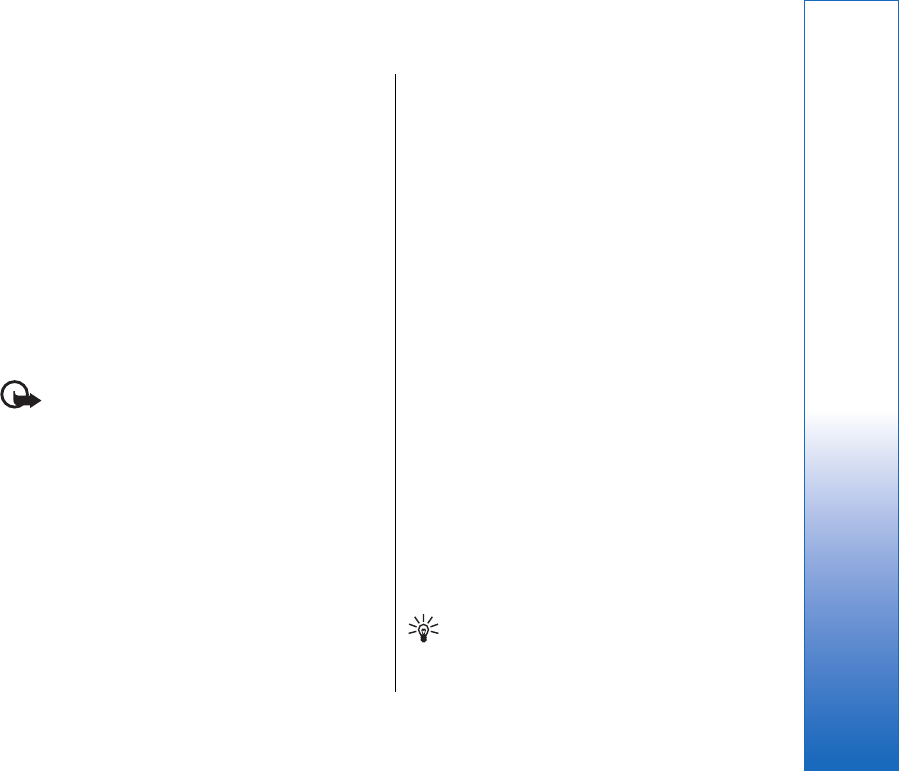
•PIN2 code—Press Change to change the PIN2
code. The PIN2 code must be 4 to 8 digits long. The
PIN2 code is required to access some functions, such
as the fixed dialing settings, which must be
supported by your SIM card.
Changing the barring password
To change the password used for barring voice, fax, and
data calls, select Security → Device security, and
select the Call barring page. Select the Barring
password field, and press Change. Enter the current
code, and then the new code twice. The barring
password must be four digits long.
Certificate manager
Important: Note that even if the use of
certificates makes the risks involved in remote
connections and software installation considerably
smaller, they must be used correctly in order to benefit
from increased security. The existence of a certificate
does not offer any protection by itself; the certificate
manager must contain correct, authentic, or trusted
certificates for increased security to be available.
Certificates have a restricted lifetime. If Expired
certificate or Certificate not valid yet is shown even if
the certificate should be valid, check that the current
date and time in your device are correct.
Before changing any certificate settings, you must
make sure that you really trust the owner of the
certificate and that the certificate really belongs to the
listed owner.
Digital certificates may be used for:
• connecting to an online banking service or another
site or remote server to transfer confidential
information
• reducing the risk of viruses or other malicious
software, and checking the authenticity of software
when downloading and installing it
Managing certificates
Personal certificates are certificates that are issued to
you. They are listed on the User page.
Authority certificates are on the Other page. They are
used by some services, such as banking, for checking
the validity of other certificates.
To add certificates, select Security → Certificate
manager. Press Add to add a new certificate. You can
then browse for the certificate file. Press Delete to
remove a selected certificate.
To check the authenticity of a certificate, select
Security → Certificate manager. Select a certificate,
and press View details. The Issued to: field identifies
the owner of this certificate. Make sure that this is the
name of the party to whom the certificate belongs. The
Fingerprint: field uniquely identifies the certificate.
Contact the help desk or customer service of the owner
of the certificate and ask for the MD5 fingerprint of the
certificate. Compare the fingerprint with the one shown
in the dialog to check whether they match.
Tip: Check the authenticity of a certificate each
time you add a new certificate.
83
Control panel
file:///C:/USERS/MODEServer/rapi/7167389/rae-6_mini/en/issue_1/rae-6_mini_en_1.xml Page 83 Nov 22, 2004 2:59:20 PMfile:///C:/USERS/MODEServer/rapi/7167389/rae-6_mini/en/issue_1/rae-6_mini_en_1.xml Page 83 Nov 22, 2004 2:59:20 PM

To change the trust settings of a certificate, select
Security → Certificate manager. Select the
certificate, press View details, and press Trust
settings. Depending on the certificate, a list of the
applications that can use the selected certificate is
shown. Select an application field, and change the value
to Yes or No. Note that you cannot change the trust
settings of a personal certificate.
To change the private key store password, select
Security → Certificate manager, select the
Password page, and press Change password. Enter
the current password, press OK, and enter the new
password twice. You need the private key store
password when using personal certificates. The private
key store contains the secret keys that come with
personal certificates.
Extras
Go to Desk → Tools → Control panel → Extras.
About product
To view the version number of the software, select
Extras → About product, and scroll to the bottom of
the dialog.
Location privacy
Some networks allow others to request the position of
your device (network service). Note that a separate
positioning module is needed for this service.
To set the device to accept or reject all position
requests, select Extras → Location privacy, and select
the Verification policy field. Select Accept all or
Reject all.
Location request log
To view the location request log, select Extras →
Location request log. The log shows a list of received
location requests, displaying the name or phone
number of the requester, time and date, and whether
the request was accepted.
Internet setup
Go to Desk → Tools → Control panel, and select
Connections → Internet setup.
To connect to the Internet, you need an Internet access
point.
For connecting to the Internet over GPRS, the device has
predefined, default Internet access point settings. You
can create new Internet access points yourself, or you
may receive your Internet access point settings in a
message from your service provider. This might reduce
the number of settings you need to enter yourself, or
eliminate the need altogether.
The exact values for the settings are usually provided
by your service provider. Follow the instructions given
to you by your service provider very carefully.
Tip: You may need to set up several Internet
access points, depending on the sites you want
to access. For example, browsing the Web may
84
Control panel
file:///C:/USERS/MODEServer/rapi/7167389/rae-6_mini/en/issue_1/rae-6_mini_en_1.xml Page 84 Nov 22, 2004 2:59:20 PMfile:///C:/USERS/MODEServer/rapi/7167389/rae-6_mini/en/issue_1/rae-6_mini_en_1.xml Page 84 Nov 22, 2004 2:59:20 PM

require one setup, and accessing your company
intranet may require another connection.
Setting up an Internet access
point
1. Select Connections → Internet setup.
2. Press New. You can use an existing Internet access
point as a basis for the new one: after you have
pressed New, press Yes. Select the access point
from the list, and press OK.
3. Define the settings.
•Internet settings name—Enter a descriptive
name for the connection.
•Internet settings type—Select the connection
type. Depending on which connection you select,
only certain settings will be available during the
setup process.
•Network ID—Select the network ID according
to the destination network you want to access
with the Internet access point. You can rename,
and create new network IDs. Using the correct
network ID ensures that the data traffic is routed
directly to the desired destination network.
Especially VPN (virtual private network) software
may restrict data traffic for a certain destination
network. Network ID can be used to filter
Internet access points when establishing an
Internet connection.
•GPRS access point name (for GPRS only)—If
you are not using a default Internet access point,
define a name for the access point. You can
obtain the name from your network operator or
service provider.
•Telephone number (for GSM data only)—Type
the modem telephone number of the Internet
access point.
•Password prompt—Change this to Yes if you
must write a new password every time you log
on to a server, or if you do not want to save your
password to the device.
•User name—Type a user name if required by
the service provider. The user name may be
needed to make a data connection, and is usually
provided by the service provider. The user name
is often case-sensitive.
•Password—A password may be needed to
connect to the Internet, and is usually provided
by the service provider. The password is often
case-sensitive.
4. After defining the settings, press Advanced to
define advanced settings, if necessary. Otherwise,
press Finish or Done to exit the setup wizard.
Configuring advanced Internet
access point settings
Press Advanced when you have finished setting up the
basic Internet access point settings. The pages and
options available depend on the connection type you
have selected.
85
Control panel
file:///C:/USERS/MODEServer/rapi/7167389/rae-6_mini/en/issue_1/rae-6_mini_en_1.xml Page 85 Nov 22, 2004 2:59:20 PMfile:///C:/USERS/MODEServer/rapi/7167389/rae-6_mini/en/issue_1/rae-6_mini_en_1.xml Page 85 Nov 22, 2004 2:59:20 PM

IP configuration page
Note that the two protocols (IPv4 and IPv6) require
slightly different settings.
•Network type (for GPRS only)—For a GPRS
connection you must specify which protocol you
want to use.
•Auto retrieve IP—If you select Yes, the IP address
is obtained automatically from the server. This
setting is also called dynamic IP address.
•IP address—The IP address of the device. If the IP
address is obtained automatically, you are not
required to enter details here.
•Auto retrieve DNS—If you select Yes for the IPv4
protocol, the DNS (domain name server) address is
obtained automatically from the server. The
respective value for the IPv6 protocol is Well
known. DNS is an Internet service that translates
domain names such as www.nokia.com into IPv4
addresses like 192.100.124.195, or IPv6 addresses
like 3ffe:2650:a640:1c2:341:c39:14. If you select No
for the IPv4 protocol, or Manual for the IPv6
protocol, you must specify the IP addresses for the
primary and secondary DNS servers.
Proxies page
You may want to use a proxy to quicken access to the
Internet. Some Internet service providers require the
use of Web proxies. Contact your Internet service
provider to determine proxy details.
If you have made an Internet connection to your
company’s intranet, and are unable to retrieve Web
pages from the general Internet, you may need to set
up a proxy server to retrieve Web pages outside your
company’s intranet.
Define the following:
•Proxy protocol—Select the protocol type of the
proxy. You can set different proxy settings for each
protocol.
•Use proxy server—Select Yes to use the proxy
server.
•Proxy server—Enter the IP address of the proxy
server, or the domain name. Example domain names
are: company.com and organisation.org.
•Port number—The number of the proxy port. The
port number is related to the protocol. Common
values are 8000 and 8080, but vary with every proxy
server.
•No proxy for—Define the domains for which the
HTTP or HTTPS proxy is not needed.
Data call page
Define the following:
•Connection type—Define the GSM data call type.
To use High speed, the service provider must
support this feature, and if necessary, activate it for
your SIM card.
•Remote modem type—Define whether the device
uses an analog or digital connection. This setting
depends on both your GSM network operator and
Internet service provider, because some GSM
networks do not support certain types of ISDN
connections. For details, contact your Internet
service provider. If ISDN connections are available,
86
Control panel
file:///C:/USERS/MODEServer/rapi/7167389/rae-6_mini/en/issue_1/rae-6_mini_en_1.xml Page 86 Nov 22, 2004 2:59:20 PMfile:///C:/USERS/MODEServer/rapi/7167389/rae-6_mini/en/issue_1/rae-6_mini_en_1.xml Page 86 Nov 22, 2004 2:59:20 PM

they establish connections more quickly than analog
methods.
•Modem speed—This option allows you to limit the
maximum connection speed. Higher data rates may
cost more, depending on the service provider. The
speed represents the maximum speed at which your
connection will operate. During the connection, the
operating speed may be less, depending on network
conditions.
•Modem initialisation—You can control your
device using modem AT commands. If required,
enter characters specified by your service provider.
Script page
A script can automate the connection between the
device and the server. Contact your Internet service
provider to find out whether you need a script.
Define the following:
•Use login script—If you select Yes, you can write
or import a login script. You can edit the script in the
Login script field.
•Show terminal window—If you select Yes, once a
connection is established, you see the execution of
the script.
Other page
Define the following:
•Use callback—Select Yes if you have a service that
dials back to your device when you establish an
Internet connection.
•Callback type—Ask your Internet service provider
for the correct setting. Server number refers to the
standard Microsoft callback, and Server number
(IETF) refers to a callback approved by the Internet
Engineering Task Force. Select Number to use a
number that you define in the Callback number
field.
•Callback number—Enter the data call phone
number of your device, which the callback server
uses.
•Allow plain text login—Select No, if you never
want to send your password as plain text without
encryption. Note that this option only affects PPP
connections; e-mail and Web passwords are not
encrypted. Some Internet service providers require
that this option is set to Yes.
•Use PPP compression—Select Yes to speed up the
data transfer, if it is supported by the remote PPP
server. If you have problems establishing a
connection, select No.
Configuring Internet
connection settings
These settings affect all Internet connections.
To configure common Internet connection settings,
select Connections → Internet setup. Select the Idle
page, and define the time period after which the
connection ends automatically and returns to standby
mode if not used. You can specify a different time for
each connection type, but the setting affects all
Internet access points using that connection type.
Some Internet connections may appear inactive, but
they may still be sending and receiving data in the
87
Control panel
file:///C:/USERS/MODEServer/rapi/7167389/rae-6_mini/en/issue_1/rae-6_mini_en_1.xml Page 87 Nov 22, 2004 2:59:20 PMfile:///C:/USERS/MODEServer/rapi/7167389/rae-6_mini/en/issue_1/rae-6_mini_en_1.xml Page 87 Nov 22, 2004 2:59:20 PM

background. These connections may postpone the
closing of the connection.
Select the Other page, and define the settings.
•Ask before connecting—If you select Yes, a dialog
appears every time you connect to the Internet,
asking you to confirm the connection or to change
the Internet access point.
•GPRS operating mode—Select Always on to keep
the GPRS connection in alert mode and to switch the
packet data transfer on quickly when needed. If you
select On when needed, the device uses a GPRS
connection only when you start an application or
action that needs it. Note that if there is no GPRS
coverage and you selected Always on, the device
will periodically try to establish a GPRS connection.
To change the priority of Internet access points, select
Connections → Internet setup. Press Priority, select
an Internet access point, and press Move up or Move
down. When you establish a data connection, the
access points are searched for in the order you have
specified.
Selecting an Internet access
point
When you establish an Internet connection, you are
asked to select the Internet access point you want to
use for that connection. In the Network connection
dialog, select an Internet access point from the list, and
press Connect. Before connecting, you can filter the list
of access points according to the network type. To view
all Internet access points, select All networks. To view
Internet access points that are currently available, press
Show available. For example, if you are using the
Offline profile, no GPRS or GSM Internet access points
are shown in the list.
Tip: The Network connection dialog opens
only if you have selected Yes in the Ask before
connecting field in the general Internet access
point settings. To check the status of the
setting, select Desk → Tools → Control
panel, and Connections → Internet setup
→ Other page.
88
Control panel
file:///C:/USERS/MODEServer/rapi/7167389/rae-6_mini/en/issue_1/rae-6_mini_en_1.xml Page 88 Nov 22, 2004 2:59:20 PMfile:///C:/USERS/MODEServer/rapi/7167389/rae-6_mini/en/issue_1/rae-6_mini_en_1.xml Page 88 Nov 22, 2004 2:59:20 PM
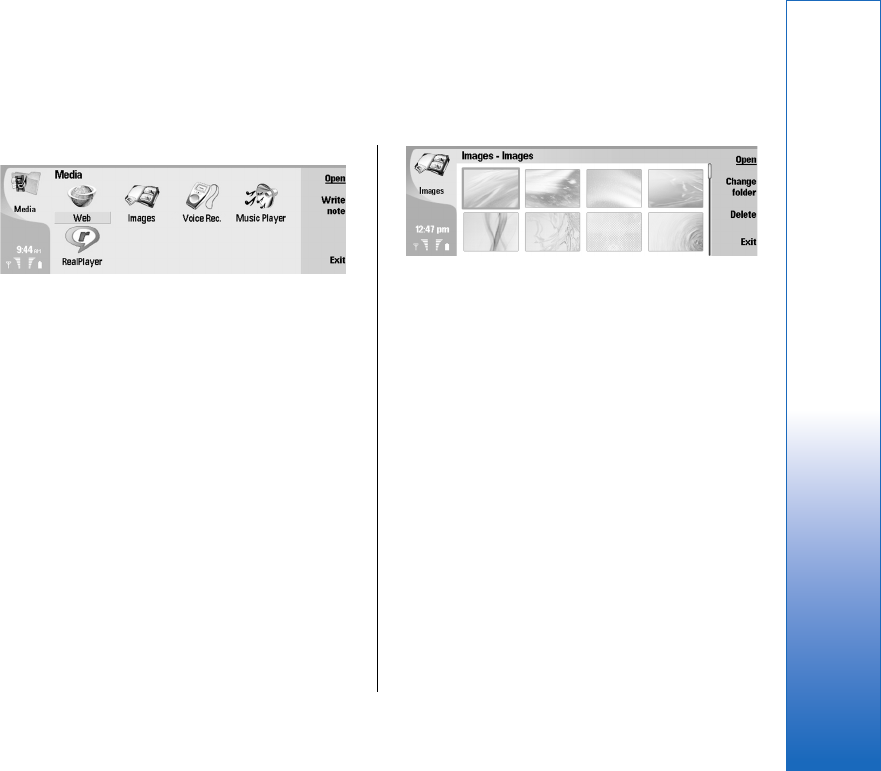
Media applications
Go to Desk → Media.
Images
Go to Desk → Media → Images.
Images consists of two different views:
• In the image browser view you can, for example,
organize, delete, and rename images stored in your
device or memory card. The images can be displayed
either as thumbnails or as a list of file names.
• In the image viewer, which opens when you select
an image in the image browser view and press
Open, you can view, edit, and send individual
images. Note that TIFF and animated GIF files cannot
be edited.
Image browser view
The following file formats are supported: JPEG, BMP,
PNG, GIF 87a/89a, and TIFF/F (monochrome). The device
does not necessarily support all variations of the
aforementioned file formats.
Viewing images
To open an image for viewing, select an image in the
image browser view, and press Open. The image opens
in the image viewer.
To open the next or previous image for viewing, press
Menu, and select Go to → Next image or Previous
image, or press Ctrl+F for the next image or Ctrl+B for
the previous image.
To enlarge or reduce the viewed image on the display,
press Menu, and select View → Zoom → Zoom in or
Zoom out.
To view the image in full screen size, press Full screen.
To return to normal view, press Menu, select View, and
unselect Full screen. If you want the images to always
open in full screen size, press Menu, and select Tools
89
Media applications
file:///C:/USERS/MODEServer/rapi/7167389/rae-6_mini/en/issue_1/rae-6_mini_en_1.xml Page 89 Nov 22, 2004 2:59:20 PM

→ Settings…. In the Always open image in full
screen field, select Yes.
Tip: To switch between the full screen and
normal view, press Ctrl+T. In full screen mode,
press any of the command buttons to display
the commands.
Editing images
To rotate an image, select an image, and press Open.
Press Menu, and select Tools → Rotate. The image is
rotated clockwise by 90 degrees.
To flip an image horizontally or vertically, select an
image, and press Open. Press Menu, and select Tools
→ Flip → Flip horizontally or Flip vertically.
To crop an image, select an image, and press Open.
Press Menu, and select Tools → Crop…. Press + or - to
increase or decrease the size of the selected area, or
press Ctrl and scroll up, down, left, or right to change
the shape of the selected area. To move the area
selector inside the image, scroll up, down, left, or right.
Press Crop to crop the image. The extra space around
the area selector is removed.
To resize an image, select an image, and press Open.
Press Menu, and select Tools → Resize…. Select a
percentage, or select Custom size, and define the size
yourself. If you want to zoom the image so that there
are no empty margins at the sides of the screen, select
Best fit. This option is useful when, for example,
creating wallpaper for Desk. Note that the aspect ratio
of the image cannot be changed when you select Best fit.
Managing image files
Copyright protections may prevent some images,
ringing tones, and other content from being copied,
modified, transferred or forwarded.
To view detailed information about an image, select an
image, press Menu, and select File → Properties….
Name, size, and format of the file; the time and date
the file was last modified; and the resolution of the
image in pixels are displayed. To prevent the image
from being modified, select the Attributes page, and
select Read-only and Yes.
To send an image, select the image, press Menu, and
select File → Send, and the method to send.
To change the file format, select an image, and press
Open. Press Menu, and select File → Save → Save
as…. Press Change. Select the new file format, and
press Done. Press OK to save the file.
To rename an image, select an image, press Menu, and
select File → Rename…. Enter a new name, and press
OK.
To make a copy of an image, select the image, press
Menu, and select File → Duplicate….
To view images as a list of file names or as thumbnails,
press Menu, and select View → Show as →
Thumbnails or List.
To set an image as wallpaper, select the image, press
Menu, and select Tools → Set as wallpaper. Select
Desk if you want the image to appear in the Desk view,
and select Cover if you want to add the background
image to the cover phone display.
90
Media applications
file:///C:/USERS/MODEServer/rapi/7167389/rae-6_mini/en/issue_1/rae-6_mini_en_1.xml Page 90 Nov 22, 2004 2:59:20 PMfile:///C:/USERS/MODEServer/rapi/7167389/rae-6_mini/en/issue_1/rae-6_mini_en_1.xml Page 90 Nov 22, 2004 2:59:20 PM
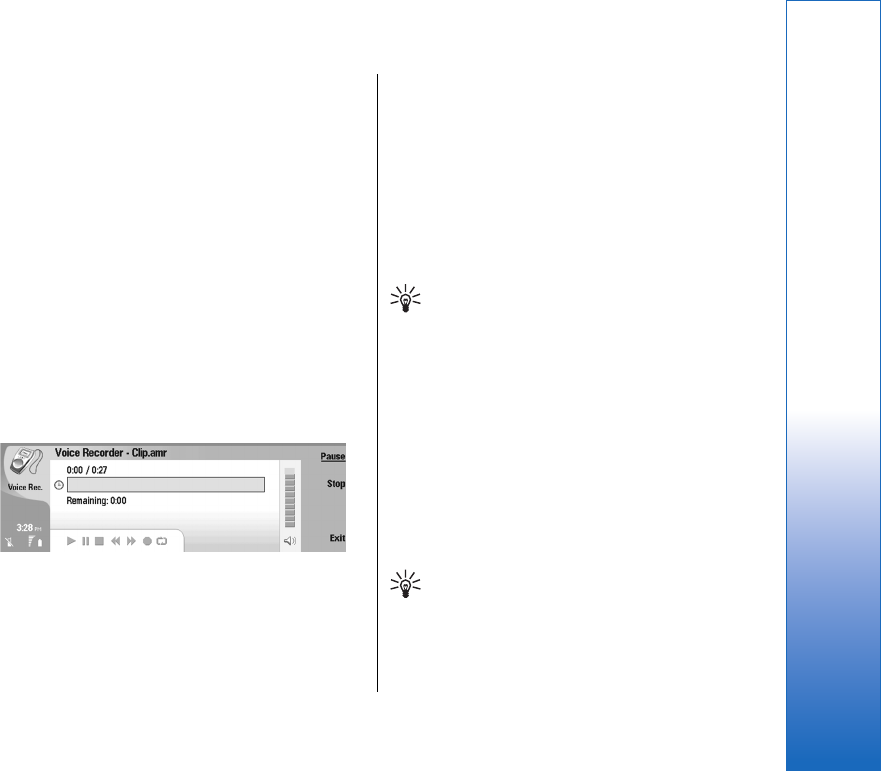
To add an image to a contact card, select an image,
press Menu, and select Tools → Add to contact
card…. Press + or - to increase or decrease the size of
the selected area. To move the area selector inside the
image, scroll up, down, left, or right. Press Menu, and
select an option to zoom, rotate, or flip the image.
When the image is ready, press Add. Select the contact
card to which the image is added, and press Done.
Voice recorder
The recorder cannot be used when a data call or GPRS
connection is active.
Go to Desk → Media → Voice rec..
Voice rec. can record a telephone conversation or voice
memo, save the voice recording as a sound clip, play
your clip or other sound files, and edit sound files.
Voice rec. can play the following formats: WAV, AMR,
AU, and compressed GSM.
To record a voice memo, press Menu, and select File →
New clip, and press Record. Voice rec. begins to
record all sound that enters the external microphone.
When you complete recording, select Stop. Press Menu,
and select File → Save → Save clip. Type a name for
the voice recording, and press OK.
To record a phone call, begin the call. When the call
recipient answers, press Menu, and select File → New
clip, and press Record. Voice rec. begins to record, and
both parties will hear a tone every five seconds to
indicate that the telephone conversation is recorded.
When you complete recording, select Stop. Press Menu,
and select File → Save → Save clip. Type a name for
the voice recording and select OK.
To continue recording at the end of a voice recording,
select a voice recording, and press Record. Recording
continues at the endpoint of the previous recording.
Tip: The maximum length of a voice recording
depends on the storage space available in
device memory or on a memory card.
Playing a voice recording
The progress bar displays the playing time, position,
and length of a voice recording.
To listen to a voice recording, press Play. Scroll left to
seek backward or right to seek forward.
To pause a voice recording, press Pause. Playback
resumes when you press Play.
To play a voice recording again, press Menu, and select
Playback → Repeat. The voice recording will repeat.
Tip: Voice recordings that you receive or record
are temporary files. You must save the files that
you want to keep.
91
Media applications
file:///C:/USERS/MODEServer/rapi/7167389/rae-6_mini/en/issue_1/rae-6_mini_en_1.xml Page 91 Nov 22, 2004 2:59:20 PMfile:///C:/USERS/MODEServer/rapi/7167389/rae-6_mini/en/issue_1/rae-6_mini_en_1.xml Page 91 Nov 22, 2004 2:59:20 PM
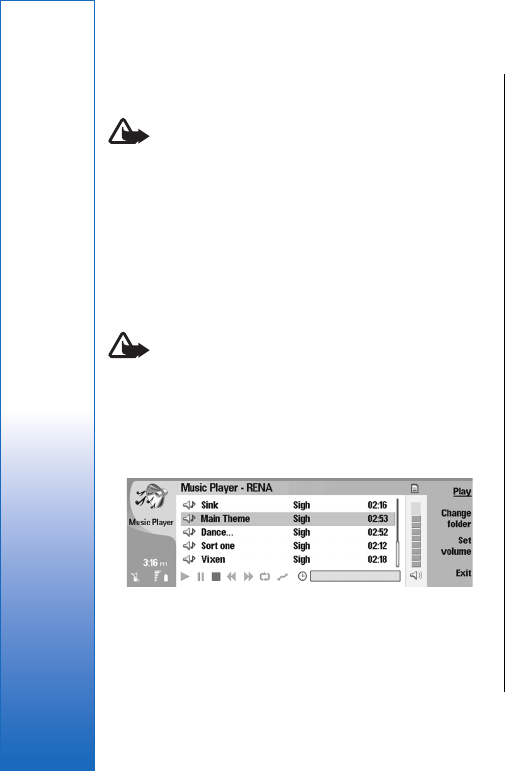
Music player
Warning: Do not hold the device near your ear
when the loudspeaker is in use, because the volume
may be extremely loud.
Go to Desk → Media → Music player.
Music player can play and organize music tracks and
sound files. Music player supports several sound
formats: MP3, WAV, MIDI, AMR, and AAC.
Listening to music
Warning: Listen to music at a moderate level.
Continuous exposure to high volume may damage your
hearing.
Music player displays a music track list, volume, shuffle
and repeat indicators, the current active mode, and a
progress bar. The progress bar shows the playing time,
position, and length of a track.
To play a music track, or tracks in the current folder,
press Play. Playback stops automatically when the last
track in the playing order is complete.
To sort music tracks, press Menu, and select View →
Sort by. List tracks in the current folder by name, file
name, date, or size. Sorting affects the playing order of
tracks in the current folder.
To select the previous or next track, press Menu, and
select Go to → Previous track or Next track. The
selected track is based on the current sort order.
To play music tracks again, press Menu, and select
Playback → Repeat. This loops playback of tracks in
the current folder from the last track in the playing
order back to the first track.
To play music in random order, select a folder, press
Menu, and select Playback → Random.
RealPlayer
Copyright protections may prevent some images,
ringing tones, and other content from being copied,
modified, transferred or forwarded.
Go to Desk → Media → RealPlayer.
RealPlayer plays video, sound, and media from the
Internet. RealPlayer plays many formats, including:
MPEG-4, MP4 (not streaming), 3GP, RV, RA, RAM, and RM.
Playing media clips
You can play video clips and sound files that are stored
in device memory or on a memory card, transferred to
your device from e-mail or compatible PC, or streamed
to your device over the Internet.
92
Media applications
file:///C:/USERS/MODEServer/rapi/7167389/rae-6_mini/en/issue_1/rae-6_mini_en_1.xml Page 92 Nov 22, 2004 2:59:20 PMfile:///C:/USERS/MODEServer/rapi/7167389/rae-6_mini/en/issue_1/rae-6_mini_en_1.xml Page 92 Nov 22, 2004 2:59:20 PM
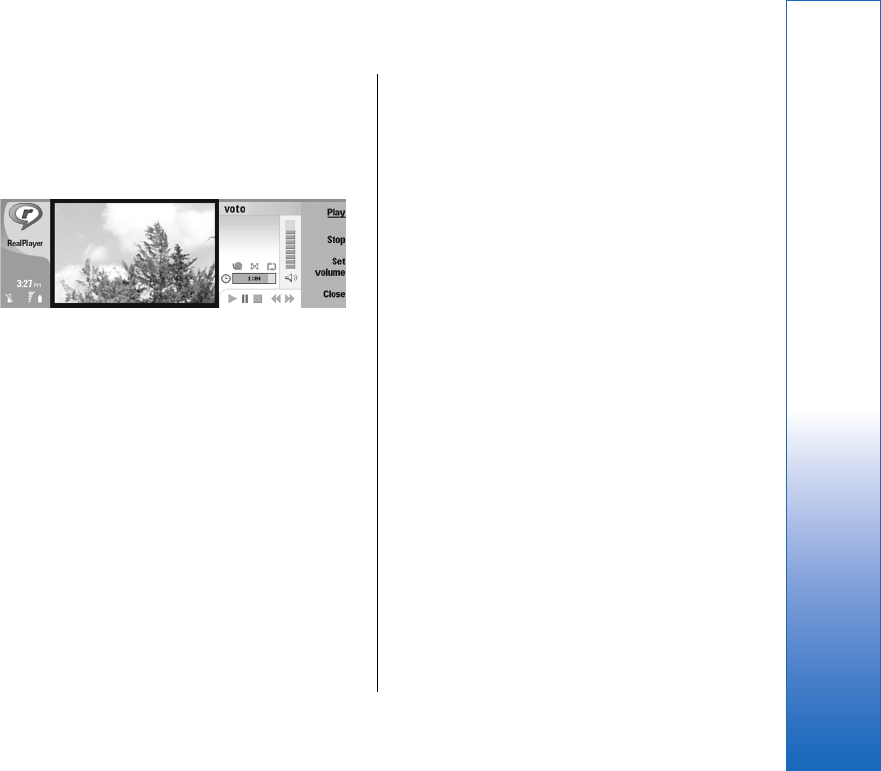
The progress bar displays the playing time, position,
and length of a media clip. During playback, video
pauses while the main menu or any dialog is displayed.
Video is centered horizontally and vertically in the
video area. If video is too large to fill either the whole
width or height of the video area, the video is resized
before rendering to preserve the original aspect ratio.
To play streaming media, browse to a media file on the
Internet, and press Play. If a network connection
problem causes a playback error, RealPlayer will
attempt automatically to reconnect to the Internet
access point.
To play stored media, press Play. Playback stops
automatically.
To stop playback or streaming, press Stop. Buffering or
connecting to a streaming site stops, playback of a clip
stops, and the clip rewinds to the beginning. The clip
remains selected in the media clip list.
To view the video clip in full-screen size, press Menu,
and select View → Full screen. This changes the size
of the video area to normal or full screen.
To save a media clip, press Menu, and select File →
Save clip as…. To save an Internet connection link,
press Menu, and select File → Save link as….
Adjusting media volume
To change media volume, scroll up or down.
To turn off the sound, press Set volume → Mute.
Press Unmute to turn on sound.
93
Media applications
file:///C:/USERS/MODEServer/rapi/7167389/rae-6_mini/en/issue_1/rae-6_mini_en_1.xml Page 93 Nov 22, 2004 2:59:20 PMfile:///C:/USERS/MODEServer/rapi/7167389/rae-6_mini/en/issue_1/rae-6_mini_en_1.xml Page 93 Nov 22, 2004 2:59:20 PM

Calculator
In Calculator, you can make calculations, and save the
results to the calculator memory for later use. The Desk
calculator can be used for basic calculations, and the
Scientific calculator for more advanced calculations.
Note: This calculator has limited accuracy and is
designed for simple calculations.
Go to Desk → Office → Calculator.
Making calculations
To make a calculation, enter the first number of the
calculation. Press the tab key, and select a function
from the function map. Enter the second number of the
calculation, and press the enter key.
Note that the calculator performs operations in the
order you enter them. Parentheses cannot be used to
change the order of operations.
To switch between the desk and scientific calculator,
press Menu, and select View → Desk calculator or
Scientific calculator.
To make a number positive or negative, write the
number, and press m on the keyboard.
To print a calculation, press Menu, and select Printing
→ Print.
For instructions on using the scientific calculator, see
the Help function in the device.
94
Calculator
file:///C:/USERS/MODEServer/rapi/7167389/rae-6_mini/en/issue_1/rae-6_mini_en_1.xml Page 94 Nov 22, 2004 2:59:20 PM

Clock
In Clock, you can view the date and time of your home
and destination city, and manage clock alarms.
Go to Desk → Clock.
Using world clock
To set the date and time, press Menu, and select Tools
→ Date and time….
Tip: You can also update date and time
automatically (network service). You can select
this setting in Control panel. See Date and time
on page 73.
To switch between the home and destination city
information, press the tab key.
To change a city, select either the home or destination
city, and press Change city.
Tip: If you change the home city, the clock and
calendar entries are updated. This is useful for
example when you want to attend phone
conferences.
To view and manage alarms, press Alarm clock.
To change the clock type, press Menu, and select View
→ Clock type, and select Analog or Digital.
Tip: To change to the one-clock view which
shows only your home city information, press
Menu, and select View → Remote city details.
Using Alarm clock
If the alarm time is reached while the device is
switched off, the device switches itself on and starts
sounding the alarm tone. If you press Stop/Stop, the
device asks whether you want to activate the device for
calls. Press No to switch off the device or Yes to make
and receive calls. Do not press Yes when wireless
phone use may cause interference or danger.
To set an alarm, press New alarm, and enter the alarm
time.
To modify an alarm, press Edit alarm.
To remove an alarm, press the backspace key.
When the alarm sounds, press Stop to turn it off. Press
Snooze to postpone the alarm.
95
Clock
file:///C:/USERS/MODEServer/rapi/7167389/rae-6_mini/en/issue_1/rae-6_mini_en_1.xml Page 95 Nov 22, 2004 2:59:20 PM
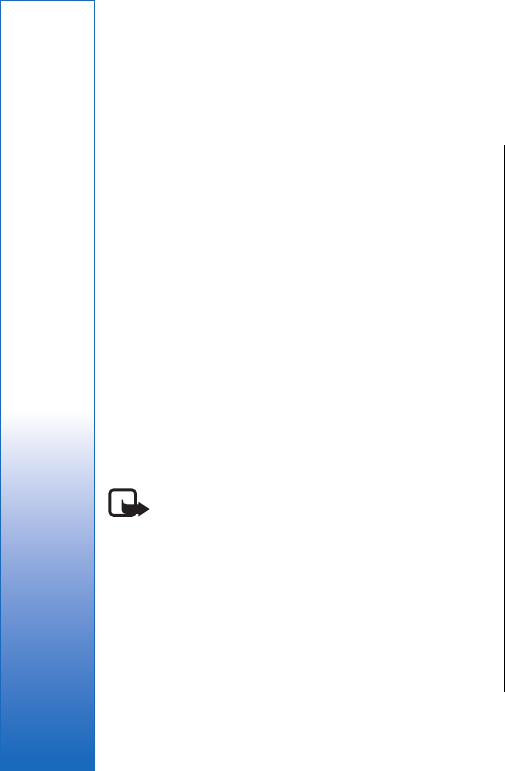
Data and software management
Your smartphone offers you several applications for
managing your personal data, such as contacts and
calendar information and e-mail.
Data mover
You can use Data mover to transfer certain data, such
as contacts and settings, from your Nokia 9200 series
Communicator to your Nokia 9300 with infrared or a
memory card. Before you start, make sure that there is
enough free memory in your devices or memory card
for the transfer. Note that if there is less than 2 MB of
free memory in the Nokia 9300 , you cannot start the
transfer.
Do not use the Nokia 9300 when using Data mover. If
possible, switch off the cover phone. Make sure you
have enough battery power, or connect the device to a
charger.
Note: Before you use an existing compatible
memory card with your Nokia 9300, you must convert
the memory card with Data mover and reinstall the
applications that you previously installed to the
memory card. However, do not reinstall any pre-
installed applications for the Nokia 9210
Communicator. Your Nokia 9300 contains a later
version of these applications, and these later versions
must be used with Nokia 9300.
Note that there may be additional steps, depending on
the type of information that you want to transfer, the
method of transfer you want to use, the amount of free
memory on your previous communicator or memory
card, or the number of successful or unsuccessful
transfers you have made previously. Make sure that the
infrared ports of the devices are facing each other.
1. Go to Desk → Tools → Data mover. If there is
data on a memory card, insert it to your Nokia 9200
series Communicator. Press Continue transfer.
2. Activate infrared in both devices, make sure that the
infrared ports of the devices are facing each other,
and press Continue. An infrared connection is
established between the devices.
3. Press Send data collector to send the Data
collector to your Nokia 9200 series Communicator.
Data collector is sent as an infrared message to your
Inbox. To install Data collector, press Open in the
9200 series Communicator. If Open is not available,
press Save to save the installation file, and open it
from File manager. The Data collector starts
automatically after installation. If you have already
installed the tool , press Connect data coll. in your
Nokia 9300.
4. Select the data you want to transfer in the Nokia
9300. You can transfer calendar and contact
information, messages, settings, documents, and
images. Some files, such as business card messages
96
Data and software management
file:///C:/USERS/MODEServer/rapi/7167389/rae-6_mini/en/issue_1/rae-6_mini_en_1.xml Page 96 Nov 22, 2004 2:59:20 PM

and e-mail messages not stored in the Inbox, are
not transferred.
5. Press Transfer infrared or Transfer mem. card,
depending on the method of transfer you want to
use.
6. Press Start transfer. If the transfer process is
interrupted, restart Data mover, and continue the
transfer. If the problem happens again, there may
be a problem with the data you are trying to
transfer. Start the data transfer process again, but
do not select to transfer data that seems to be
causing the problem.
7. Press OK after the transfer to finish the transfer
process.
8. Press Exit to exit, or Convert mem. card to convert
a memory card for use in your Nokia 9300.
Note that the transfer may take some time.
Beginning a data transfer
Go to Desk → Tools → Data mover.
With Data mover, you can transfer data, such as
settings, messages, and files, from your Nokia 9200
series Communicator to your Nokia 9300 using infrared
or with a memory card. Data mover displays
instructions as you follow the transfer process. Follow
the instructions on the display.
To start transferring data from your Nokia 9200 series
Communicator to Nokia 9300, press Continue transfer.
If you are continuing an interrupted transfer, press
Continue conversion.
To end the data transfer process, close Data mover, and
press Exit.
Backup
It is advisable to take backups of your device data
regularly.
Go to Desk → Tools → Backup.
Before you start backing up or restoring data:
• Close all other applications.
• If possible, switch off the cover phone.
• Make sure you have enough battery power.
To back up data to a memory card, press New backup.
Enter a name for the backup, and select whether you
want to perform a full or partial backup. Full backup
copies all data. If you select Partial backup, specify
which items you want to include in the backup. Press
Start backup.
To restore backup data from the memory card, select a
backup, and press Restore. Select whether you want to
restore all backup data or selected items only. If you
select Partial backup, specify which items you want to
restore. Press Start restore.
Data transfer
If you have a Nokia 9300 and another device that
supports data transfer, you can use Data transfer to
synchronize your calendar and contacts entries
between the two devices.
97
Data and software management
file:///C:/USERS/MODEServer/rapi/7167389/rae-6_mini/en/issue_1/rae-6_mini_en_1.xml Page 97 Nov 22, 2004 2:59:20 PMfile:///C:/USERS/MODEServer/rapi/7167389/rae-6_mini/en/issue_1/rae-6_mini_en_1.xml Page 97 Nov 22, 2004 2:59:20 PM

For information on compatible devices, contact your
dealer, operator, or service provider.
Go to Desk → Tools → Data transfer.
1. Press New to create a new synchronization profile.
2. Select the content you want to synchronize, and
press Next.
3. Select the connection type, and press Select. If you
select infrared as the connection type, the
synchronization is started immediately.
4. If you selected Bluetooth as the connection type,
press Search to search for the device you want to
synchronize with. To stop the search, press Stop.
5. Scroll to the device you want to synchronize with,
and press Select. The synchronization is started.
To view the synchronization log, press Menu, and select
File → Synchronisation log.
Synchronization
The Synchronization application enables you to
synchronize your calendar or contacts with various
calendar and address book applications on a
compatible computer or remote Internet server. Your
settings (what data is synchronized, what connection
method is used) are saved to a synchronization profile,
which is then used while synchronizing.
The application uses SyncML technology for remote
synchronization. For information on SyncML
compatibility, contact the supplier of the applications
with which you want to synchronize your device.
Go to Desk → Tools → Synchronization.
Synchronizing calendar and contacts information
1. Connect your device to a compatible PC. You can use
infrared, Bluetooth, or a cable connection. See
Connectivity on page 101.
2. Press Sync. If you selected Bluetooth, the device
searches for available devices for synchronization.
Press Stop to end the search, and Select to select a
device with which you want to synchronize.
3. Follow the instructions on the display.
There is an existing profile for Nokia PC Suite, and the
basic setup is done with Nokia PC Suite. You need to
edit these predefined settings only if the settings have
been changed.
You may also receive the synchronization settings as a
smart message from your service provider.
If you want to return to the default settings for PC
Suite, press Menu, and select Tools → Reset PC Suite
profile.
To edit an existing profile, select the profile, and press
Edit.
To set one of the existing synchronization profiles as
the default profile, select the profile, press Menu, and
select File → Tools → Set as default.
To delete a profile, select the profile, and press the
backspace key.
After you have synchronized your device with a
compatible computer, you can view a synchronization
log.
To open the synchronization log, select a profile, and
press Log. The log shows, for example, the date and
98
Data and software management
file:///C:/USERS/MODEServer/rapi/7167389/rae-6_mini/en/issue_1/rae-6_mini_en_1.xml Page 98 Nov 22, 2004 2:59:20 PMfile:///C:/USERS/MODEServer/rapi/7167389/rae-6_mini/en/issue_1/rae-6_mini_en_1.xml Page 98 Nov 22, 2004 2:59:20 PM

time of the synchronization, and lists possible
synchronization errors.
See the User Guide on the CD-ROM for more information
on new profiles.
For additional information on synchronizing, see the
User's Guide for Nokia PC Suite or the help for Nokia PC
Sync.
Nokia PC Suite
Nokia PC Suite offers you a set of programs for
managing your Nokia 9300. For example, you can
synchronize your contacts and calendar information, e-
mail, and to-do items between the device and a
compatible PC using Nokia PC Sync, manage device
folders using Nokia Phone Browser, back up and restore
personal data using Nokia Content Copier, and install
applications using Nokia Application Installer.
For additional instructions on how to install and use
the PC Suite, see the User's Guide for Nokia PC Suite on
CD-ROM, or helps in the Nokia PC Suite applications.
To use Nokia PC Suite, you need to connect your device
to a compatible PC using the DKU-2 (USB) cable,
Bluetooth, or infrared. See Connectivity on page 101.
Install Nokia PC Suite from CD-ROM or from
www.nokia.com. Note that Nokia PC Suite can only be
used with Windows 2000 and Windows XP.
• If you want to use cable, connect the cable to a
compatible PC, and then to the device.
• If you want to use Bluetooth, pair the device and a
compatible PC, and set the PC as authorized. See
Pairing with a device on page 103.
• If you want to use infrared, activate infrared on your
device. See Infrared on page 104. Activate infrared
on the compatible PC, if necessary.
Installing applications
and software
Important: Only install applications from
sources that offer adequate protection against harmful
software.
You can install two types of applications and software
to your device:
• Applications and software specifically intended for
the Nokia 9300 or compatible with the Symbian
operating system. These software installation files
have the extension .SIS.
• J2ME™ applications compatible with the Symbian
operating system. The Java™ application installation
files have the extensions .JAD or .JAR.
Installation files may be transferred to your device from
a compatible computer, downloaded during browsing,
or sent to you in a multimedia message, as an e-mail
attachment, or with Bluetooth. If you use PC Suite for
Nokia 9300 to transfer a file, save the file in the C:\nokia
\installs folder in your device. If you use Microsoft
Windows Explorer to transfer a file, save the file on a
memory card (local disk).
During installation, the device checks the integrity of
the package to be installed. The device shows
information about the checks being carried out, and
99
Data and software management
file:///C:/USERS/MODEServer/rapi/7167389/rae-6_mini/en/issue_1/rae-6_mini_en_1.xml Page 99 Nov 22, 2004 2:59:20 PMfile:///C:/USERS/MODEServer/rapi/7167389/rae-6_mini/en/issue_1/rae-6_mini_en_1.xml Page 99 Nov 22, 2004 2:59:20 PM

you are given options to continue or cancel the
installation.
See Certificate manager on page 83.
Installing Symbian software
When you install an update or repair to an application,
you must have the original or a full backup to restore
the application. To restore the original application,
remove the application, and install it again from the
original installation file or the backup copy.
To install software, search the device memory or
memory card for the installation file, select the file, and
press the enter key to start the installation. For
example, if you received the installation file as an e-
mail attachment, go to your mailbox, open the e-mail,
select an installation file, and press the enter key to
start the installation.
Use the Application manager to remove software. See
Application manager on page 76.
Installing Java™ applications
1. Search the device memory or memory card for the
installation file, select the file, and press the enter
key to start the installation. For example, if you
received the installation file as an e-mail
attachment, go to your mailbox, open the e-mail,
select an installation file, and press the enter key to
start the installation.
2. Confirm the installation. The .JAR file extension is
required for installation. If it is missing, the device
may ask you to download it. If there is no access
point defined, you will be asked to select one. When
you download the .JAR file, you may need to enter a
user name and password to access the server. You
can obtain these from the application provider.
3. The device informs you when installation is
complete.
Tip: When browsing Web pages, you can
download an installation file and install it
immediately. Note, however, that the
connection runs in the background during
installation.
Java™
You can install and run Java™ applications on your
device. See Installing applications and software on
page 99.
The Java platform for the Nokia 9300 is J2ME™. You can
search for Java applications with the browser,
download through the Internet, and store them in the
Applications folder.
To manage your Java applications, use the Application
manager.
J2ME on your device supports two Java environments:
MIDP and Personal Profile.
Tip: For development information, visit
www.forum.nokia.com. Forum Nokia contains
the Series 80 Developer Platform, Java Software
Development Kit (SDK), tools, technical notes,
and applications.
100
Data and software management
file:///C:/USERS/MODEServer/rapi/7167389/rae-6_mini/en/issue_1/rae-6_mini_en_1.xml Page 100 Nov 22, 2004 2:59:20 PMfile:///C:/USERS/MODEServer/rapi/7167389/rae-6_mini/en/issue_1/rae-6_mini_en_1.xml Page 100 Nov 22, 2004 2:59:20 PM

Connectivity
There are several different connectivity types you can
use with your device. You can use wireless connectivity
methods such as Bluetooth or infrared, or a USB
(Universal Serial Bus) cable connection for PC Suite or IP
passthrough.
Cable connection
You can connect your device to a compatible PC using a
DKU-2 (USB) cable. Connect the cable to the bottom of
the device. See Figure Keys and connectors on page 13.
You can also connect the cable to the desk stand of the
device. Note that if you connect the cable to the desk
stand, the connector of the cable must be connected
upside down.
Note that you must install the DKU-2 driver to your PC
before you can use a cable connection. See the sales
package CD-ROM or www.nokia.com for details.
IP passthrough
You can also use a cable for IP passthrough, where the
device uses the Internet connection of a computer. You
can use IP passthrough as you use any Internet access
point, for example for browsing or remote
synchronization.
Note that you cannot use IP passthrough at the same
time as Nokia PC Suite. You can define cable connection
settings in Control panel. See Cable setup on page 80.
Note that you cannot activate modem if you select IP
passthrough in cable connection settings. You must
use PC Suite connection, or IP pass. overr. PC Suite
with no active IP passthrough connection.
Bluetooth
This device is compliant with Bluetooth Specification
1.1 supporting the following profiles: Generic Access
Profile, Serial Port Profile, Dial-Up Networking Profile,
Generic Object Exchange Profile, Object Push profile, File
Transfer Profile, SIM Access Profile, and Handsfree
Profile. To ensure interoperability between other
devices supporting Bluetooth technology, use Nokia
approved enhancements for this model. Check with the
manufacturers of other devices to determine their
compatibility with this device.
There may be restrictions on using Bluetooth
technology in some locations. Check with your local
authorities or service provider.
Features using Bluetooth technology, or allowing such
features to run in the background while using other
features, increase the demand on battery power and
reduce the battery life.
101
Connectivity
file:///C:/USERS/MODEServer/rapi/7167389/rae-6_mini/en/issue_1/rae-6_mini_en_1.xml Page 101 Nov 22, 2004 2:59:20 PM
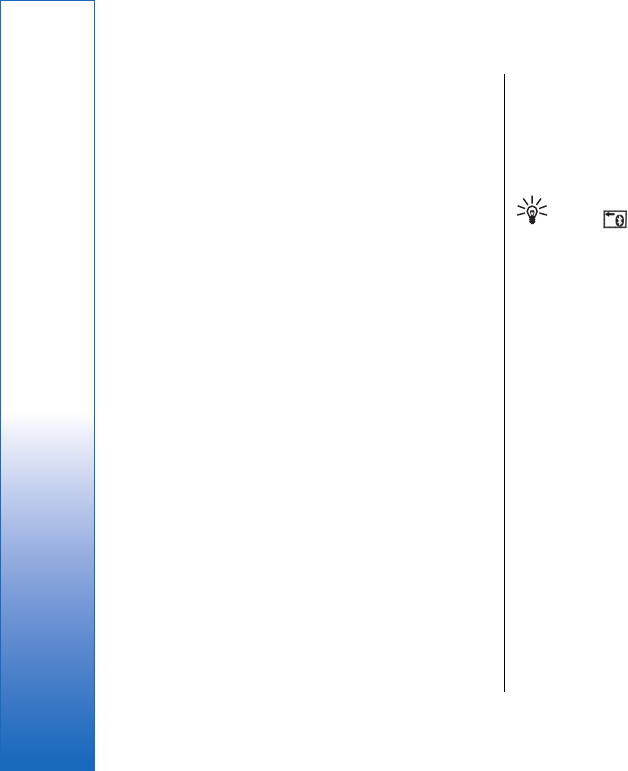
Bluetooth technology enables cost-free wireless
connections between electronic devices within a
maximum range of 10 metres. A Bluetooth connection
can be used to send images, videos, texts, business
cards, calendar notes, or to connect wirelessly to
devices using Bluetooth technology, such as computers.
Since devices using Bluetooth technology communicate
using radio waves, your device and the other devices
do not need to be in direct line-of-sight. The two
devices only need to be within a maximum of 10
metres of each other, although the connection can be
subject to interference from obstructions such as walls
or from other electronic devices.
When you activate Bluetooth for the first time, you are
asked to give a name to your device.
Bluetooth settings
To modify the Bluetooth settings, select Desk →
Tools → Control panel, and select Connections →
Bluetooth. Select the Settings page.
Define the following:
•Bluetooth active—Select Yes to enable Bluetooth.
If you select No, all active Bluetooth connections are
ended, and Bluetooth cannot be used for sending or
receiving data.
•My telephone's visibility—Select Shown to all if
you want your device to be found by other
Bluetooth devices. If you select Hidden, your device
cannot be found by other devices.
•My Bluetooth name—Define a name for your
device. The maximum length of the name is 247
characters.
If you have set Bluetooth as active and changed your
visibility to Shown to all, your device and its name can
be seen by other Bluetooth device users.
Tip: To activate or deactivate Bluetooth, press
Chr+ .
Note that if Bluetooth was turned off as a result of
entering Offline profile, you must re-enable Bluetooth
manually.
Sending data with Bluetooth
Copyright protections may prevent some images,
ringing tones, and other content from being copied,
modified, transferred or forwarded.
There can be only one active Bluetooth connection at a
time.
1. Open an application where the item you want to
send is stored. For example, to send a photo to
another device, open the Images application.
2. Select the item you want to send, press Menu, and
select File → Send → Via Bluetooth.
3. If you have searched for Bluetooth devices earlier, a
list of the devices that were found previously is
shown first. You can see a device icon and the
device name. To start a new search, press Search
more. To interrupt the search, press Stop.
4. Select the device you want to connect with, and
press Select.
102
Connectivity
file:///C:/USERS/MODEServer/rapi/7167389/rae-6_mini/en/issue_1/rae-6_mini_en_1.xml Page 102 Nov 22, 2004 2:59:20 PMfile:///C:/USERS/MODEServer/rapi/7167389/rae-6_mini/en/issue_1/rae-6_mini_en_1.xml Page 102 Nov 22, 2004 2:59:20 PM

5. If the other device requires pairing before data can
be transmitted, you are asked to enter a passcode.
Create your own passcode (1-16 characters long,
numeric), and agree with the owner of the other
Bluetooth device to use the same code. The
passcode is used only once, and you do not have to
memorize it. Devices that do not have a user
interface have a preset passcode. After pairing, the
device is saved to the Paired devices page.
6. When the connection has been established
successfully, the note Sending… is shown.
Receiving data with Bluetooth
If you want to receive data using Bluetooth, set
Bluetooth to be active and selected the option Shown
to all.
When you receive data with Bluetooth from a device
that is not authorized, you are first asked if you want to
accept the Bluetooth message. If you accept, the item is
placed in the Inbox folder in the Messaging application.
Pairing with a device
Pairing means authentication. Pairing with a device
makes device searches quicker and easier.
Go to Desk → Tools → Control panel, and select
Connections → Bluetooth.
To pair with a device, select the Paired devices page.
Press New, then Start to start a device search. Select
the device you want to pair with, and press Pair. Enter
the passcode, and press OK.
Tip: The users of the devices using Bluetooth
technology should agree together on the
passcode, and use the same passcode for both
devices in order to pair them. Devices that do
not have a user interface have a preset
passcode.
To cancel pairing, select the Paired devices page.
Select the device whose pairing you want to cancel, and
press Delete.
To assign a short name for a paired device, select the
Paired devices page. Select the device whose name
you want to change, and press Edit. In the Assign
short name field, you can define a short name
(nickname, alias) to help you recognize a certain device.
This name is stored in the device memory and cannot
be seen by other Bluetooth device users.
To set a device to be authorized or unauthorized, select
the Paired devices page. Select the device, and press
Edit. Move to the Device authorised field, and select
Yes. Connections between your device and the other
device can be made without your knowledge. No
separate acceptance or authorization is needed. Select
Yes for your own devices, for example, your PC, or
devices that belong to someone you trust. The icon
is added next to authorized devices in the list of
paired devices. If you select No, connection requests
from this device need to be accepted separately every
time.
To connect to a Bluetooth device, select the Paired
devices page. Select the device from the list, press Edit,
and press Connect. Note that this option is available
only with audio devices that require a more stable
Bluetooth connection, for example, Bluetooth headsets
103
Connectivity
file:///C:/USERS/MODEServer/rapi/7167389/rae-6_mini/en/issue_1/rae-6_mini_en_1.xml Page 103 Nov 22, 2004 2:59:20 PMfile:///C:/USERS/MODEServer/rapi/7167389/rae-6_mini/en/issue_1/rae-6_mini_en_1.xml Page 103 Nov 22, 2004 2:59:20 PM
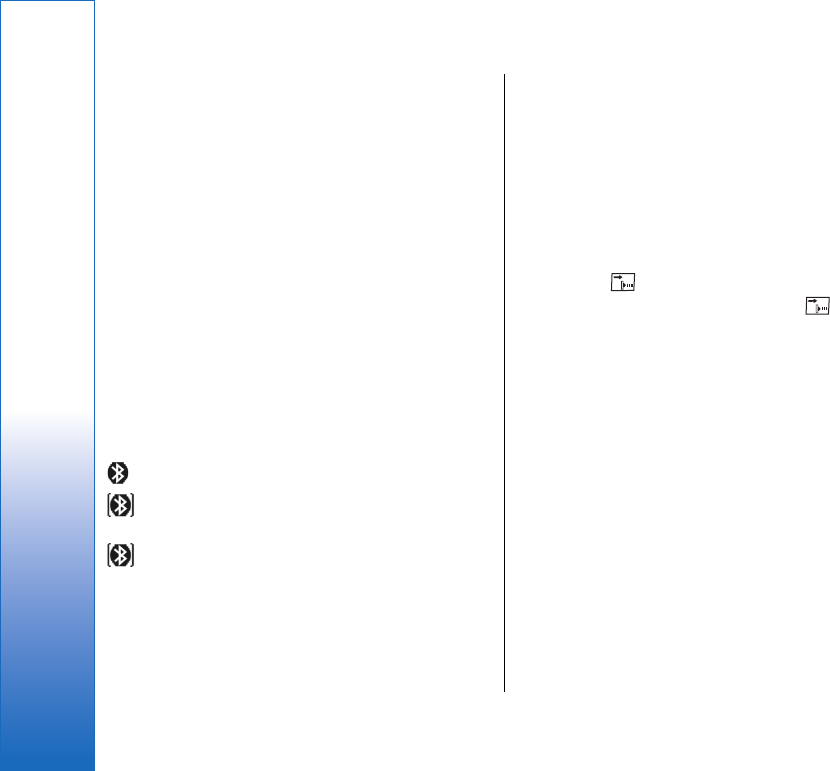
or car kits. Such devices must support the Bluetooth 1.1
specification and Handsfree profile. To end the
connection to the selected device, press Disconnect.
SIM access profile
Using a Bluetooth connection and the SIM access
profile, you can access your SIM card with a compatible
car kit phone. See SIM access profile on page 78.
Ending a Bluetooth connection
A Bluetooth connection is disconnected automatically
after sending or receiving data. Only with the PC Suite,
and some enhancements such as headsets, the
connection may be maintained even if it is not actively
used.
Checking the status of the
Bluetooth connection
Bluetooth is active.
When the icon is blinking, your device is trying to
connect to the other device.
When the icon is shown continuously, the
Bluetooth connection is active.
Infrared
Do not point the IR (infrared) beam at anyone's eye or
allow it to interfere with other IR devices. This device is
a Class 1 laser product.
You can use infrared for sending and receiving files
from other infrared devices.
1. Make sure that the infrared ports of the devices face
each other. The positioning of the devices is more
important than angle or distance.
2. Press Chr+ .
To end the infrared connection, press Chr+ again.
Modem
You can use the device as a modem together with a
compatible computer.
Go to Desk → Tools → Modem.
Before you can use your device as a modem:
• You need the appropriate data communications
software on your computer.
• You must subscribe to the appropriate network
services from your service provider or Internet
service provider.
• You must have the appropriate drivers installed on
your computer. You need to install DKU-2 (USB)
drivers for cable connection, and you may need to
install or update Bluetooth or infrared drivers.
• It is recommended that you have Nokia Modem
Options installed on your computer.
104
Connectivity
file:///C:/USERS/MODEServer/rapi/7167389/rae-6_mini/en/issue_1/rae-6_mini_en_1.xml Page 104 Nov 22, 2004 2:59:20 PMfile:///C:/USERS/MODEServer/rapi/7167389/rae-6_mini/en/issue_1/rae-6_mini_en_1.xml Page 104 Nov 22, 2004 2:59:20 PM

See www.nokia.com and the User's Guide for Nokia PC
Suite for details.
To connect the device to a compatible computer using
an infrared connection, press Activate. To disconnect,
press Disable.
Tip: To use the device as a modem using a
Bluetooth or cable connection, you must
connect the device to a compatible computer,
and activate the modem from the computer.
Note that you may not be able to use some of the other
communication features when the device is used as a
modem.
Printing
You can print files to compatible printers in most
applications. Before starting to print, make sure that
your device is properly connected to the printer.
To print a file to a compatible printer, press Menu, and
select File → Printing → Print…. Check that the
settings are correct, and press Print.
To change the printing settings, press Options.
To preview a file before printing, press Menu, select
File → Printing → Print…, and press Preview. To
start printing to a compatible printer, press Print. To
modify the document size, margins, headers, footers or
pagination, press Page setup.
Problems with printing
Your device shows a note if you cannot connect the
device to a compatible printer.
Here are some starting points for troubleshooting:
• Printer - check that the printer is switched on and
online, print a test page, try to print while directly
connected to the printer, verify that the printer
works with other wireless devices, or check that the
printer is supported by your device.
• Infrared - check that infrared is activated, the
infrared ports of the device and the printer face each
other, and there are no bright lights shining on
either port.
• Bluetooth - check that Bluetooth is activated and
your device can locate Bluetooth devices other than
the printer, and the device and printer are within
range.
Managing mobile printing
settings
To manage the printing settings when printing to a
compatible Hewlett-Packard printer, go to Desk →
Tools → Control panel → Extras → HP printer
selection. Set the following:
•Printer model—Select the printer you want to use.
•Quality mode—Select the quality of the print,
depending on the printing qualities supported by
your printer. Normal is for 600 dpi printing, Draft is
for fast, 300 dpi printing, Best is for 1200 dpi
printing, and Maximum is for 2400/4800 dpi
105
Connectivity
file:///C:/USERS/MODEServer/rapi/7167389/rae-6_mini/en/issue_1/rae-6_mini_en_1.xml Page 105 Nov 22, 2004 2:59:20 PMfile:///C:/USERS/MODEServer/rapi/7167389/rae-6_mini/en/issue_1/rae-6_mini_en_1.xml Page 105 Nov 22, 2004 2:59:20 PM

printing. To save ink or to increase the speed of
printing, select the Normal or Draft.
•Media type—Select the type of printing medium.
•Colour mode—Select whether to print in color or
greyscale, depending on your printer.
Remote configuration
(network service)
The Device manager application helps you configure
connection settings, for example, e-mail, multimedia
messaging, or Internet settings.
Go to Desk → Tools → Device manager.
The remote configuration connection is usually started
by the server when device settings need to be updated.
To start a configuration session, select a profile from
the list, and press Connect. If no remote configuration
profiles have been defined, you must first create a new
profile.
To disable configuration, select a profile, press Menu,
and select Tools → Disable configuration. You
cannot receive configuration settings from any of the
configuration servers for which you have a profile.
When the configuration session has ended, you can
view status information.
To open the configuration log, select a profile, and
press Configuration log. The log file shows the latest
configuration status of the selected profile.
Creating a new configuration
server profile
The configuration server profile contains the settings
for the remote server. You can create several profiles if
you need to access multiple servers.
You may receive the configuration server profile
settings as a special message from your service provider.
1. If you have no profiles defined, press New,
otherwise press Menu, and select File → New.
2. If you already have profiles defined, choose whether
you want to copy the values from an existing profile
to be used as the basis for the new profile.
3. The Profile settings dialog opens.
Define the following settings on the different pages
of the dialog:
•Server name—Type a name for the
configuration server.
•Server ID—Type the unique ID to identify the
configuration server. Contact your service
provider or system administrator for the correct
value.
•Password—Write a password to identify your
device to the server. Confirm the password.
•Active—Select Yes to allow the server to
initiate a configuration session.
•Accepted—Select Yes if you do not want the
server to ask for your confirmation when it
initiates a configuration session.
•Connection type—Select how you want to
connect to the server.
106
Connectivity
file:///C:/USERS/MODEServer/rapi/7167389/rae-6_mini/en/issue_1/rae-6_mini_en_1.xml Page 106 Nov 22, 2004 2:59:20 PMfile:///C:/USERS/MODEServer/rapi/7167389/rae-6_mini/en/issue_1/rae-6_mini_en_1.xml Page 106 Nov 22, 2004 2:59:20 PM

•Access point—Select the access point you want
to use for the data connection to the server.
•Host address—Type the URL address of the
server. Contact your service provider or system
administrator for the correct value.
•Port—Type the port number of the server.
Contact your service provider or system
administrator for the correct value.
•User name—Enter your user ID for the
configuration server. Contact your service
provider or system administrator for your correct
user ID.
•Password—Type your password for the
configuration server. Confirm it in the Confirm
password field. Contact your service provider or
system administrator for the correct password.
To edit the configuration profile settings, select the
profile, and press Edit.
To delete a profile, select the profile, and press the
backspace key.
Tip: If you have deleted or modified the
predefined PC Suite profile, you can restore it
by pressing Menu, and selecting Tools →
Reset PC Suite profile.
Data connections
This device supports packet data (GPRS), high-speed
data calls (HSCSD), and GSM data calls.
For information on packet data, high-speed data calls,
and GSM data calls, see the User Guide on CD-ROM.
107
Connectivity
file:///C:/USERS/MODEServer/rapi/7167389/rae-6_mini/en/issue_1/rae-6_mini_en_1.xml Page 107 Nov 22, 2004 2:59:20 PMfile:///C:/USERS/MODEServer/rapi/7167389/rae-6_mini/en/issue_1/rae-6_mini_en_1.xml Page 107 Nov 22, 2004 2:59:20 PM
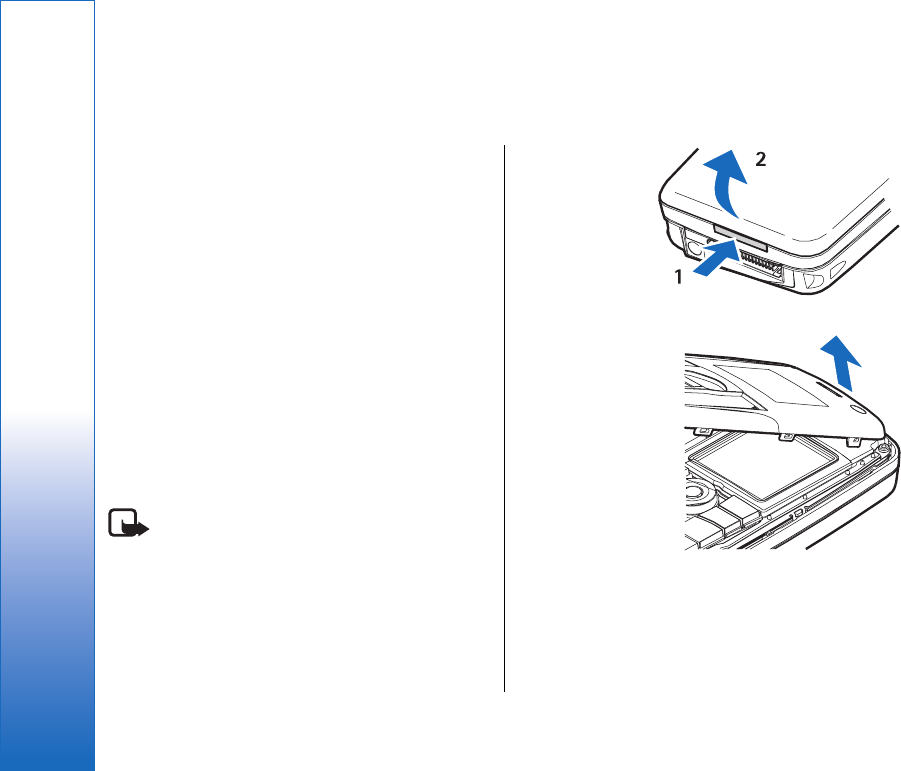
Personalizing your device
There are several ways you can personalize your device.
• Covers - You can change the front cover of your
device.
• Cover selection keys - You can change the functions
that are shown above the left and right selection
keys.
• Desk - You can organize the applications, shortcuts,
and notes to groups, and create new folders on Desk.
• My own key - You can configure the My own key to
open your favorite application.
• Background images - You can set a background
image to your cover phone display and
communicator display.
• Color schemes - You can change the color schemes of
your device.
Changing the front cover
Note: Before removing the cover, always switch
off the power and disconnect the charger and any other
device. Avoid touching electronic components while
changing the covers. Always store and use the device
with the covers attached.
1. Press the front cover release button (1), and lift the
front cover (2) in the direction of the arrow. Start at
the bottom part of the device, and end by releasing
the locking catches at the top of the device.
2. Lift the front cover in the direction of the arrow.
3. To replace the front cover, align the locking catches
with the top of the device at a low angle.
108
Personalizing your device
file:///C:/USERS/MODEServer/rapi/7167389/rae-6_mini/en/issue_1/rae-6_mini_en_1.xml Page 108 Nov 22, 2004 2:59:20 PM
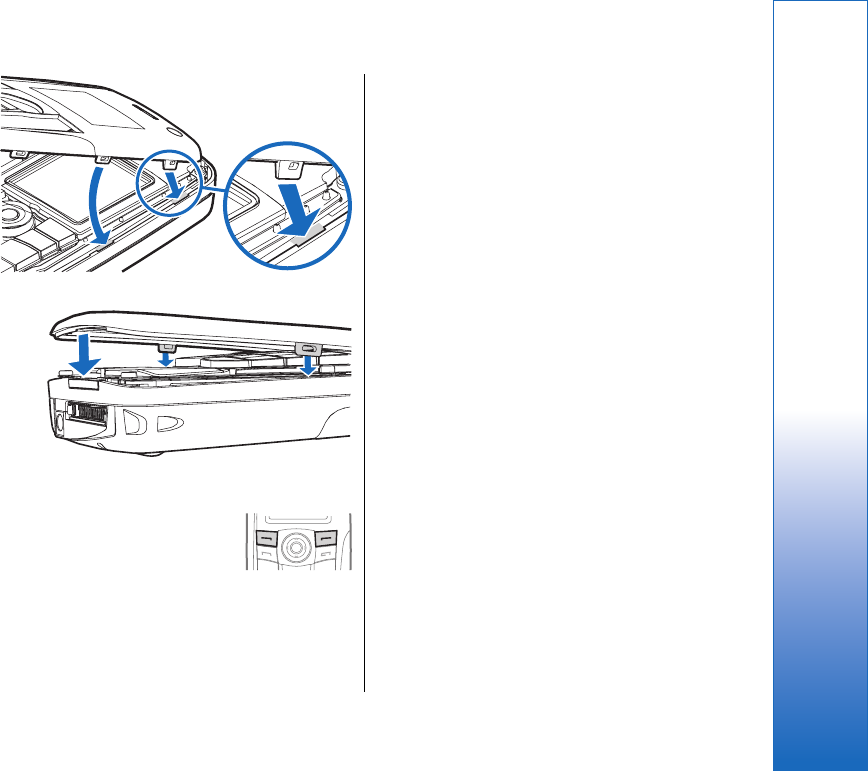
4. Press the front cover down until it locks into place.
Cover selection keys
The left selection key in standby mode
is Go to. You can use the key as a
shortcut to your favorite functions. To
activate a function, scroll to it, and
press Select.
To add a function to the shortcut list, press Options,
select Select options, scroll to a function, and press
Mark. To remove a function from the list, select the
function, and press Unmark.
To rearrange the functions in the list, press Options,
and select Organise. Scroll to the function that you
want to move, press Move, and select where you want
to move the function.
Desk
You can arrange the Desk in several ways. You can
move applications to different groups from their
original groups, create new groups, rename old groups,
and modify the icons and names of the applications.
You can also change the background image on Desk.
See Desk on page 27.
My own key
You can configure the My own key to open the
application of your choice. See My own key on page 74.
Wallpapers and color
schemes
You can set a background image to your cover display
and communicator display. There are several
wallpapers ready to use. See Wallpapers on page 75.
You can also change the color schemes of your device.
Changing the color scheme in Control panel affects the
colors on your communicator interface.See Display on
page 75. Use the Settings menu on the cover phone to
change the color scheme of the cover phone side. See
Settings on page 25.
109
Personalizing your device
file:///C:/USERS/MODEServer/rapi/7167389/rae-6_mini/en/issue_1/rae-6_mini_en_1.xml Page 109 Nov 22, 2004 2:59:20 PMfile:///C:/USERS/MODEServer/rapi/7167389/rae-6_mini/en/issue_1/rae-6_mini_en_1.xml Page 109 Nov 22, 2004 2:59:20 PM
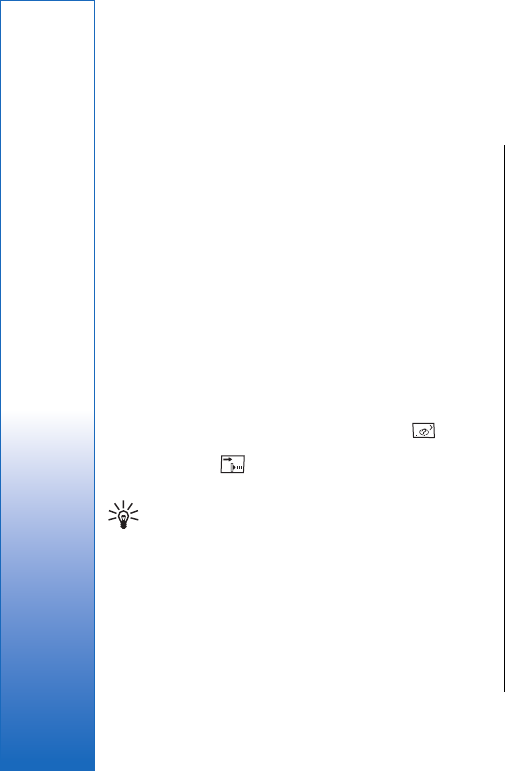
Shortcuts
Here are some of the available keyboard shortcuts in
your device. Shortcuts can make the use of the
applications more efficient.
There are several different shortcut combinations that
you can use:
• Shortcuts with Ctrl+key give you access to the Menu
functions. For example, pressing Ctrl+N creates a
new window in Web, a new contact card in Contacts
or a new message in Messaging.
• Additional characters and symbols are most often
inserted by the Shift+key combination. For example,
pressing Shift+a number key can insert quotation
marks, exclamation points or parentheses.
• Certain functions can be activated with the Chr+key
combinations. For example, pressing Chr+ opens
additional information about your current task, or
pressing Chr+ can activate and deactivate
infrared.
Tip: Many shortcuts are also displayed next to
menu options in applications.
General shortcuts
Ctrl+A Select all
Ctrl+C Copy
Ctrl+D Delete
Ctrl+F Find
Ctrl+I Sort
Ctrl+M Move
Ctrl+N New
Ctrl+O Open
Ctrl+P Print
Ctrl+S Save
Ctrl+T Full screen
Ctrl+V Paste
Ctrl+X Cut
Ctrl+Z Undo
Shift+Ctrl+E Zoom
Shift+Ctrl+G Next
Shift+Ctrl+L Log
Shift+Ctrl+P Previous
110
Shortcuts
file:///C:/USERS/MODEServer/rapi/7167389/rae-6_mini/en/issue_1/rae-6_mini_en_1.xml Page 110 Nov 22, 2004 2:59:20 PM

Shift+Ctrl+S Save as
Shift+Ctrl+U Page setup
Shift+Ctrl+V Print preview
Shift+Ctrl+Z Edit
Shift+Backspace Delete text from right
Ctrl+Telephone Open the Recent calls view in the
telephone application
Chr+alphabet Insert an accented character
Chr+Tab Switch between open applications
Chr+Telephone
key
Redial the last dialed number
Chr+Messaging
key Retrieve mail
Shift+Ctrl+Chr+S Screenshot
Application-specific
shortcuts
Desk application
Ctrl+P Properties
Shift+Ctrl+M Go to the Personal application group
Shift+Ctrl+S Show in groups
Ctrl+My own key Configure the My own key
Telephone
Ctrl+P View serial number (IMEI)
Shift+Ctrl+B Call barring
Shift+Ctrl+M Voice mailboxes
Shift+Ctrl+O Other settings
Shift+Ctrl+P Profile settings
Shift+Ctrl+S Speed dials
Shift+Ctrl+V Call diverting
Contacts
Ctrl+K Settings
Ctrl+M Belongs to groups (in an open
contact card)
Ctrl+N New contact card
Ctrl+P Database properties
Ctrl+R Ringing tone (in an open contact
card)
Ctrl+T Card templates
Shift+Ctrl+B New database
Shift+Ctrl+C Copy to
Shift+Ctrl+D Remove the picture (in an open
contact card)
Shift+Ctrl+M Move to
Shift+Ctrl+N Create a new group
111
Shortcuts
file:///C:/USERS/MODEServer/rapi/7167389/rae-6_mini/en/issue_1/rae-6_mini_en_1.xml Page 111 Nov 22, 2004 2:59:20 PMfile:///C:/USERS/MODEServer/rapi/7167389/rae-6_mini/en/issue_1/rae-6_mini_en_1.xml Page 111 Nov 22, 2004 2:59:20 PM

Shift+Ctrl+O Insert a picture (in an open contact
card)
Messaging
Ctrl+B Retrieve new messages
Ctrl+G Retrieve mail
Ctrl+I Sort by (sorts by the property you
have already selected, for example
date or sender)
Ctrl+L Go online, or go offline if a
connection is active
Ctrl+Q Properties
Ctrl+R Reply
Ctrl+T Expand folder contents
Ctrl+U Disconnect
Ctrl+Y Change the connection
Shift+Ctrl+A Retrieve all messages
Shift+Ctrl+B Retrieve the selected messages
Shift+Ctrl+E Rename the selected folder
Shift+Ctrl+F Forward the selected message
Shift+Ctrl+N Create a new folder
Shift+Ctrl+R Reply to all
Shift+Ctrl+S Sent items storage
Shift+Ctrl+T Account settings
Shift+Ctrl+Z Delete messages locally
Chr+Messaging Retrieve mail
Calendar
Ctrl+A Create a new anniversary
Ctrl+E Create a new memo
Ctrl+G Go to date
Ctrl+K Edit view settings
Ctrl+N Create a new meeting
Ctrl+Q Change view
Ctrl+S Create a new to-do note
Ctrl+T Edit the date and time
Shift+Ctrl+A Set anniversary as the default entry
type
Shift+Ctrl+C Crossed out entry
Shift+Ctrl+D Move or delete the selected object
Shift+Ctrl+E Set meeting as the default entry type
Shift+Ctrl+K Edit general settings
Shift+Ctrl+M Import entries
Shift+Ctrl+O Set to-do note as the default entry
type
Shift+Ctrl+P Properties
Shift+Ctrl+R Set memo as the default entry type
112
Shortcuts
file:///C:/USERS/MODEServer/rapi/7167389/rae-6_mini/en/issue_1/rae-6_mini_en_1.xml Page 112 Nov 22, 2004 2:59:20 PMfile:///C:/USERS/MODEServer/rapi/7167389/rae-6_mini/en/issue_1/rae-6_mini_en_1.xml Page 112 Nov 22, 2004 2:59:20 PM

Shift+Ctrl+T Tentative entry
Ctrl+Calendar Open the current day in the Day view
Calendar key Change view
Documents
Ctrl+B Bold
Ctrl+G Go to page
Ctrl+I Italics
Ctrl+U Underline
Shift+Ctrl+A Format paragraph alignment
Shift+Ctrl+B Format bullets
Shift+Ctrl+D Format borders
Shift+Ctrl+F Format the font
Shift+Ctrl+G Format the style
Shift+Ctrl+J View details of the selected object
Shift+Ctrl+K Preferences
Shift+Ctrl+N Format line spacing
Shift+Ctrl+O Insert an object
Shift+Ctrl+Y Format tabs
Shift+Ctrl+Z Edit the selected object
Sheet
Ctrl+H Rename the worksheet
Ctrl+M Freeze panes
Ctrl+Q View worksheets
Ctrl+W Insert a new worksheet
Ctrl+Y Insert cells
Shift+Ctrl+A Format cell alignment
Shift+Ctrl+B Format cell borders
Shift+Ctrl+C Insert a new chart
Shift+Ctrl+D Delete the cell
Shift+Ctrl+F Format the font
Shift+Ctrl+G Insert a page break
Shift+Ctrl+H Format row height
Shift+Ctrl+I Insert a function
Shift+Ctrl+N Format numbers
Shift+Ctrl+O Settings
Shift+Ctrl+P Format cell background color
Shift+Ctrl+R Recalculate
Shift+Ctrl+T Show title
Shift+Ctrl+W Format column width
Shift+Ctrl+X Clear the cell
113
Shortcuts
file:///C:/USERS/MODEServer/rapi/7167389/rae-6_mini/en/issue_1/rae-6_mini_en_1.xml Page 113 Nov 22, 2004 2:59:20 PMfile:///C:/USERS/MODEServer/rapi/7167389/rae-6_mini/en/issue_1/rae-6_mini_en_1.xml Page 113 Nov 22, 2004 2:59:20 PM

Presentations
Ctrl+T Full screen mode
Shift+Ctrl+A Format the alignment
Shift+Ctrl+F Format the font
Shift+Ctrl+J Format the selected object
Shift+Ctrl+V View a slide show
Enter key Start text editing
Esc key Cancel text editing
File manager
Ctrl+E Expand view
Ctrl+H Show all files
Ctrl+I Sort by (the property you have
already selected, for example name
or date)
Ctrl+N New file
Ctrl+O Collapse view
Ctrl+P Properties
Ctrl+R Rename the selected object
Ctrl+U Move up one level
Shift+Ctrl+B Back up to memory card
Shift+Ctrl+I Sorting order (the order you have
already selected, for example
ascending)
Shift+Ctrl+K Settings
Shift+Ctrl+N Create a new folder
Shift+Ctrl+Q Change memory card password
Shift+Ctrl+R Restore from memory card
Web
Ctrl+B Add to bookmarks
Ctrl+E Close the browser
Ctrl+G Back
Go to bookmark (in bookmark view)
Ctrl+H Go to home page
Ctrl+I Load all images
Insert new folder (in bookmark view)
Ctrl+K Settings
Ctrl+M Fit to screen
Ctrl+N Open a new window
Ctrl+R Reload
Ctrl+T Full screen mode
Ctrl+U Disconnect
Ctrl+W View window list
Ctrl+Y Change the connection
Ctrl+Z Stop
114
Shortcuts
file:///C:/USERS/MODEServer/rapi/7167389/rae-6_mini/en/issue_1/rae-6_mini_en_1.xml Page 114 Nov 22, 2004 2:59:20 PMfile:///C:/USERS/MODEServer/rapi/7167389/rae-6_mini/en/issue_1/rae-6_mini_en_1.xml Page 114 Nov 22, 2004 2:59:20 PM

Shift+Ctrl+B Bookmarks
Edit bookmark (in bookmark view)
Shift+Ctrl+D View downloads
Shift+Ctrl+F Reload frame
Shift+Ctrl+G Forward
Shift+Ctrl+I Rename folder (in bookmark view)
Shift+Ctrl+O Open a file
Shift+Ctrl+R Reload all
Shift+Ctrl+S Save frame as...
Shift+Ctrl+T View title bar
Images
Ctrl+B Previous image (with an image open)
Ctrl+F Next image (with an image open)
Ctrl+R Rotate image (with an image open)
Ctrl+T Full screen (with an image open)
Voice recorder
Ctrl+L Repeat
Ctrl+M Mute
Ctrl+R Rename
Shift+Ctrl+K Settings
Music player
Ctrl+B Previous track
Ctrl+F Next track
Ctrl+I Sort by (the property you have
already selected)
Ctrl+L Repeat all
Ctrl+M Mute
RealPlayer
Ctrl+B Previous clip (with a video clip open)
Ctrl+F Next clip (with a video clip open)
Ctrl+M Mute (with a video clip open)
Ctrl+R Repeat once (with a video clip open)
Ctrl+T Full screen (with a video clip open)
Shift+Ctrl+K Settings
Shift+Ctrl+S Save clip as (with a video clip open)
Device manager
Shift+Ctrl+C Connect
115
Shortcuts
file:///C:/USERS/MODEServer/rapi/7167389/rae-6_mini/en/issue_1/rae-6_mini_en_1.xml Page 115 Nov 22, 2004 2:59:20 PMfile:///C:/USERS/MODEServer/rapi/7167389/rae-6_mini/en/issue_1/rae-6_mini_en_1.xml Page 115 Nov 22, 2004 2:59:20 PM

Battery information
Your device is powered by a rechargeable battery. The
full performance of a new battery is achieved only after
two or three complete charge and discharge cycles. The
battery can be charged and discharged hundreds of
times but it will eventually wear out. When the talk and
standby times are noticeably shorter than normal, buy
a new battery. Use only Nokia approved batteries, and
recharge your battery only with Nokia approved
chargers designated for this device.
Unplug the charger from the electrical plug and the
device when not in use. Do not leave the battery
connected to a charger. Overcharging may shorten its
lifetime. If left unused, a fully charged battery will lose
its charge over time. Temperature extremes can affect
the ability of your battery to charge.
Use the battery only for its intended purpose. Never use
any charger or battery that is damaged.
Do not short-circuit the battery. Accidental short-
circuiting can occur when a metallic object such as a
coin, clip, or pen causes direct connection of the
positive (+) and negative (-) terminals of the battery.
(These look like metal strips on the battery.) This might
happen, for example, when you carry a spare battery in
your pocket or purse. Short-circuiting the terminals
may damage the battery or the connecting object.
Leaving the battery in hot or cold places, such as in a
closed car in summer or winter conditions, will reduce
the capacity and lifetime of the battery. Always try to
keep the battery between 15°C and 25°C (59°F and 77°
F). A device with a hot or cold battery may not work
temporarily, even when the battery is fully charged.
Battery performance is particularly limited in
temperatures well below freezing.
Do not dispose of batteries in a fire! Dispose of
batteries according to local regulations. Please recycle
when possible. Do not dispose as household waste.
116
Battery information
file:///C:/USERS/MODEServer/rapi/7167389/rae-6_mini/en/issue_1/rae-6_mini_en_1.xml Page 116 Nov 22, 2004 2:59:20 PM

CARE AND MAINTENANCE
Your device is a product of superior design and
craftsmanship and should be treated with care. The
suggestions below will help you protect your warranty
coverage.
• Keep the device dry. Precipitation, humidity and all
types of liquids or moisture can contain minerals
that will corrode electronic circuits. If your device
does get wet, remove the battery and allow the
device to dry completely before replacing it.
• Do not use or store the device in dusty, dirty areas.
Its moving parts and electronic components can be
damaged.
• Do not store the device in hot areas. High
temperatures can shorten the life of electronic
devices, damage batteries, and warp or melt certain
plastics.
• Do not store the device in cold areas. When the
device returns to its normal temperature, moisture
can form inside the device and damage electronic
circuit boards.
• Do not attempt to open the device other than as
instructed in this guide.
• Do not drop, knock, or shake the device. Rough
handling can break internal circuit boards and fine
mechanics.
• Do not use harsh chemicals, cleaning solvents, or
strong detergents to clean the device.
• Do not paint the device. Paint can clog the moving
parts and prevent proper operation.
• Use only the supplied or an approved replacement
antenna. Unauthorised antennas, modifications, or
attachments could damage the device and may
violate regulations governing radio devices.
All of the above suggestions apply equally to your
device, battery, charger, or any enhancement. If any
device is not working properly, take it to the nearest
authorized service facility for service.
117
CARE AND MAINTENANCE
file:///C:/USERS/MODEServer/rapi/7167389/rae-6_mini/en/issue_1/rae-6_mini_en_1.xml Page 117 Nov 22, 2004 2:59:20 PM

Additional safety information
Operating environment
Remember to follow any special regulations in force in
any area and always switch off your device when its
use is prohibited or when it may cause interference or
danger. Use the device only in its normal operating
positions. This device meets RF exposure guidelines
when used either in the normal use position against
the ear or when positioned at least 5/8 inch (1.5 cm)
away from the body. When a carry case, belt clip, or
holder is used for body-worn operation, it should not
contain metal and should position at least 5/8 inch (1.5
cm) away from your body.
In order to transmit data files or messages, this device
requires a quality connection to the network. In some
cases, transmission of data files or messages may be
delayed until such a connection is available. Ensure the
above separation distance instructions are followed
until the transmission is completed.
Medical devices
Operation of any radio transmitting equipment,
including wireless phones, may interfere with the
functionality of inadequately protected medical
devices. Consult a physician or the manufacturer of the
medical device to determine if they are adequately
shielded from external RF energy or if you have any
questions. Switch off your device in health care facilities
when any regulations posted in these areas instruct
you to do so. Hospitals or health care facilities may be
using equipment that could be sensitive to external RF
energy.
Pacemakers
Pacemaker manufacturers recommend that a minimum
separation of 6 inches (15.3 cm) be maintained
between a wireless phone and a pacemaker to avoid
potential interference with the pacemaker. These
recommendations are consistent with the independent
research by and recommendations of Wireless
Technology Research. Persons with pacemakers should:
• always keep the device more than 6 inches (15.3 cm)
from their pacemaker when the device is switched
on;
• not carry the device in a breast pocket; and
• hold the device to the ear opposite the pacemaker
to minimise the potential for interference.
• If you have any reason to suspect that interference is
taking place, switch off your device immediately.
Hearing aids
Some digital wireless devices may interfere with some
hearing aids. If interference occurs, consult your service
provider.
118
Additional safety information
file:///C:/USERS/MODEServer/rapi/7167389/rae-6_mini/en/issue_1/rae-6_mini_en_1.xml Page 118 Nov 22, 2004 2:59:20 PM

Vehicles
RF signals may affect improperly installed or
inadequately shielded electronic systems in motor
vehicles such as electronic fuel injection systems,
electronic antiskid (antilock) braking systems,
electronic speed control systems, air bag systems. For
more information, check with the manufacturer or its
representative of your vehicle or any equipment that
has been added.
Only qualified personnel should service the device, or
install the device in a vehicle. Faulty installation or
service may be dangerous and may invalidate any
warranty that may apply to the device. Check regularly
that all wireless device equipment in your vehicle is
mounted and operating properly. Do not store or carry
flammable liquids, gases, or explosive materials in the
same compartment as the device, its parts, or
enhancements. For vehicles equipped with an air bag,
remember that air bags inflate with great force. Do not
place objects, including installed or portable wireless
equipment in the area over the air bag or in the air bag
deployment area. If in-vehicle wireless equipment is
improperly installed and the air bag inflates, serious
injury could result.
Using your device while flying in aircraft is prohibited.
Switch off your device before boarding an aircraft. The
use of wireless teledevices in an aircraft may be
dangerous to the operation of the aircraft, disrupt the
wireless telephone network, and may be illegal.
Potentially explosive
environments
Switch off your device when in any area with a
potentially explosive atmosphere and obey all signs
and instructions. Potentially explosive atmospheres
include areas where you would normally be advised to
turn off your vehicle engine. Sparks in such areas could
cause an explosion or fire resulting in bodily injury or
even death. Switch off the device at refuelling points
such as near gas pumps at service stations. Observe
restrictions on the use of radio equipment in fuel
depots, storage, and distribution areas, chemical plants
or where blasting operations are in progress. Areas
with a potentially explosive atmosphere are often but
not always clearly marked. They include below deck on
boats, chemical transfer or storage facilities, vehicles
using liquefied petroleum gas (such as propane or
butane), and areas where the air contains chemicals or
particles such as grain, dust or metal powders.
119
Additional safety information
file:///C:/USERS/MODEServer/rapi/7167389/rae-6_mini/en/issue_1/rae-6_mini_en_1.xml Page 119 Nov 22, 2004 2:59:20 PMfile:///C:/USERS/MODEServer/rapi/7167389/rae-6_mini/en/issue_1/rae-6_mini_en_1.xml Page 119 Nov 22, 2004 2:59:20 PM
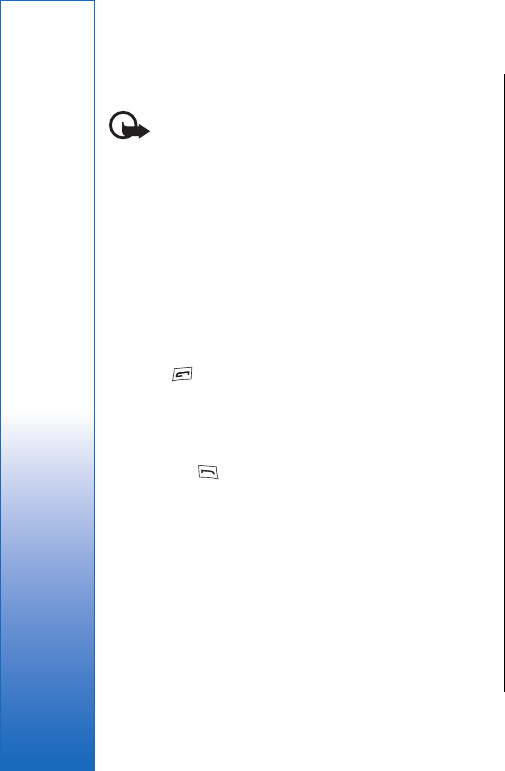
Emergency calls
Important: Wireless phones, including this
device, operate using radio signals, wireless networks,
landline networks, and user-programmed functions.
Because of this, connections in all conditions cannot be
guaranteed. You should never rely solely on any
wireless device for essential communications like
medical emergencies.
To make an emergency call:
1. If the device is not on, switch it on. Check for
adequate signal strength.
Some networks may require that a valid SIM card is
properly inserted in the device.
2. Press as many times as needed to clear the
display and ready the device for calls.
3. Key in the official emergency number for your
present location. Emergency numbers vary by
location.
4. Press the key.
If certain features are in use, you may first need to turn
those features off before you can make an emergency
call. Consult this guide or your service provider for more
information. When making an emergency call, give all
the necessary information as accurately as possible.
Your wireless device may be the only means of
communication at the scene of an accident. Do not end
the call until given permission to do so.
Certification Information
(SAR)
THIS DEVICE MEETS THE
GOVERNMENT'S REQUIREMENTS
FOR EXPOSURE TO RADIO WAVES.
Your mobile device is a radio transmitter and receiver.
It is designed and manufactured not to exceed the
limits for exposure to radio frequency (RF) energy
adopted by the governments of the USA through the
Federal Communications Commission (FCC) and Canada
through Industry Canada (IC). These limits establish
permitted levels of RF energy for the general
population. The guidelines are based on standards that
were developed by independent scientific
organizations through periodic and thorough
evaluation of scientific studies. The standards include a
substantial safety margin designed to assure the safety
of all persons, regardless of age and health.
The exposure guidelines for mobile devices employ a
unit of measurement known as the Specific Absorption
Rate or SAR. The SAR limit adopted by the USA and
Canada is 1.6 watts/kilogram (W/kg) averaged over one
gram of tissue. The limit incorporates a substantial
margin of safety to give additional protection for the
public and to account for any variations in
measurements. Tests for SAR are conducted using
standard operating positions with the device
transmitting at its highest certified power level in all
tested frequency bands. The actual SAR level of an
operating device can be well below the maximum
122
Additional safety information
file:///C:/USERS/MODEServer/rapi/4269270/rae-6_mini/en/issue_1/rae-6_mini_en_1.xml Page 122 Nov 24, 2004 3:19:21 PMfile:///C:/USERS/MODEServer/rapi/4269270/rae-6_mini/en/issue_1/rae-6_mini_en_1.xml Page 122 Nov 24, 2004 3:19:21 PM

value because the device is designed to use only the
power required to reach the network. That amount
changes depending on a number of factors such as how
close you are to a network base station.
information on file with the FCC can be found under the
Display Grant section of www.fcc.gov/oet/fccidafter
searching on FCC ID PDNRA-2. SAR values reported in
other countries may vary depending on differences in
reporting and testing requirements and the network
band. Additional SAR information may be provided
under product information at www.nokia.com.
123
Additional safety information
file:///C:/USERS/MODEServer/rapi/4269270/rae-6_mini/en/issue_1/rae-6_mini_en_1.xml Page 123 Nov 24, 2004 3:19:21 PM
file:///C:/USERS/MODEServer/rapi/4269270/rae-6_mini/en/issue_1/rae-6_mini_en_1.xml Page 123 Nov 24, 2004 3:19:21 PM
The highest SAR value reported to the FCC and IC for this
and when properly worn on the body is 0.52 W/kg. SAR
device type when tested for use at the ear is 0.21 W/kg,

Index
Symbols/Numerics
1-touch dialing 20
A
access points 84
Alarm clock 95
anniversaries view in
Calendar 70
answering a call 21, 29
Application manager 76
applications
common actions 16
installing 99
removing 76
attachments 39, 45
autolock 81
automatic redialing 25
B
background image 75
backing up data 72, 97
barring calls 31, 80
barring password 83
battery
charching 11
charge level 17
installing 10
Bluetooth 101
bookmarks 50
browser settings 51
browsing Web pages 49
business cards 54
C
cable
connections 101
settings 80
cache memory 50
Calculator 94
Calendar 67
call barring 31, 80
call diverting 79
call log 23
call register 23
call waiting 25
caller ID 25
calling 20, 29
CD-ROM 19
cell broadcast 47
cells 61
certificates 83
charging the battery 11
chart sheets 61
cities 13
Clock 95
communicator interface 14, 75
concatenation 42
conference calls 30
configuration server profiles 106
connecting to the Internet 84
connection methods
cable 101
infrared 104
modem 104
connections 36, 80
connectivity types 101
connectors 13
Contacts 24, 53
contact groups 55
contacts list 23
Control panel 73
cookies 50
cover phone 17, 20
currency format 74
cursor options 75
D
data calls
barring 80
diverting 79
Internet access point
settings 86
data connections 107
data management 76
data mover 96
data transfer 97
date and time 13, 73
day view in Calendar 69
declining a call 21
Desk 27
dialed calls 23, 30
122
Index
file:///C:/USERS/MODEServer/rapi/7167389/rae-6_mini/en/issue_1/rae-6_mini_en_1.xml Page 122 Nov 22, 2004 2:59:20 PM

display 15
indicators 17
settings 75
diverting calls 25, 31, 79
Documents 57
downloading files 50
E
e-mail 36
accounts 38, 39
attachments 39
servers 40
extended user guide 19
F
faxes 46
fax calls 79, 80
sending 46
File manager 71
formatting
documents 58
memory card 72
messages 37
H
headset settings 75
help in your device 18
I
Images 89
indicators 17
infrared 104
installing
applications 99
battery 10
memory card 10
SIM card 10
Internet 49
changing connection 36
settings 84
Internet access points 84
selecting 88
J
Java applications 100
joystick 14, 75
K
keyboard 14
keyguard 18
keypad lock 18
keys 13
L
language settings 13, 74
listening to music 92
location requests
accepting and rejecting 84
log 84
lock settings 81
locking the keypad 18
logs
calls 23
data transfer 98
general 33
installation 76
location request 84
remote configuration 106
synchronization 98
M
mail
See e-mail
memory 8, 35
memory card
backing up data 72, 97
formatting 72
installing 10
passwords 72
memory status 77
menu functions 21
messages 22, 34, 35
deleting 77
e-mail 36
multimedia messages 43
picture messages 43
special message types 47
text messages 41
Messaging center 34
missed calls 23, 30
modem 104
month view in Calendar 69
multimedia messages 43
Music player 92
muting the ringing tone 29
My contact card 54
My own key 74
N
notes view in Presentations 65
number format
general 74
123
Index
file:///C:/USERS/MODEServer/rapi/7167389/rae-6_mini/en/issue_1/rae-6_mini_en_1.xml Page 123 Nov 22, 2004 2:59:20 PMfile:///C:/USERS/MODEServer/rapi/7167389/rae-6_mini/en/issue_1/rae-6_mini_en_1.xml Page 123 Nov 22, 2004 2:59:20 PM

O
objects in documents 58
offline 30, 36
one-touch dialing 25
online 36
outline view in Presentations 65
P
pairing 103
passwords
memory card 72
private key store 84
PC Suite 99
personalization 108
phoneSee cover phone
phone calls 20
phone line 32
picture messages 43
PIN code 82
playing
music 92
video and sound 92
voice recordings 91
power 12
Presentations 63
previewing files 105
printing 105
privacy settings 84
private key store 84
product information 84
profiles 24, 78
proxy settings 81, 86
R
RealPlayer 81, 92
received calls 23, 30
recent calls 23, 30
recording
calls 91
voice 91
redialing 25
regional settings 74
rejecting a call 21
remote configuration 106
remote synchronization 98
replying to text messages 42
resizing images 90
restoring data 97
retrieving e-mail 38
S
schedules 70
scripting 87
searching
calendar entries 68
contacts 24
files and folders 72
messages 35
security
memory card 72
phone security 81
selecting text 16
service messages 80
settings
Bluetooth 102
browser 51
Calendar 69
calls 32
connectivity 47
Contacts 24
cover phone 25
display 75
Documents 58
e-mail 37, 39
fax 46
first start-up 13
headset 75
Internet 84
language 74
message centers 43
multimedia messages 44, 45
network 32
profiles 78
RealPlayer 81
regional 74
remote configuration 106
text messages 42
time and date 73
trust 84
voice mailbox 33
wallpaper 75
Sheet 60
shortcuts 17, 24, 110
signal strength 17
SIM card
installing 10
slide master view in
Presentations 65
slide shows 63
SMS messages 41
software
installing 99
124
Index
file:///C:/USERS/MODEServer/rapi/7167389/rae-6_mini/en/issue_1/rae-6_mini_en_1.xml Page 124 Nov 22, 2004 2:59:20 PMfile:///C:/USERS/MODEServer/rapi/7167389/rae-6_mini/en/issue_1/rae-6_mini_en_1.xml Page 124 Nov 22, 2004 2:59:20 PM

removing 76
version 84
sound files 92
speed dialing 20, 25, 30
stickers in the sales package 19
switching the device on and
off 12
synchronizing 98
T
tables 59, 65
Telephone application 29
templates
documents 59
text messages 41
time and date 13, 73
to-do lists view in Calendar 70
transferring data 96, 97
V
version of software 84
video clips
playing 92
voice mailbox 33
voice memos 91
Voice recorder 91
volume 18
W
wallpaper 75
Web 49
downloading files 50
visited Web pages 50
week view in Calendar 69
weekly time schedule view in
Calendar 70
worksheets 60
writing text 21
Y
year schedule view in
Calendar 70
125
Index
file:///C:/USERS/MODEServer/rapi/7167389/rae-6_mini/en/issue_1/rae-6_mini_en_1.xml Page 125 Nov 22, 2004 2:59:20 PMfile:///C:/USERS/MODEServer/rapi/7167389/rae-6_mini/en/issue_1/rae-6_mini_en_1.xml Page 125 Nov 22, 2004 2:59:20 PM